- Analytics
- News and Tools
- Market News
CFD Markets News and Forecasts — 21-03-2023
- WTI Price Rebound: Relief rally amid US intervention in banking turmoil.
- Russian President Putin welcomed the Chinese proposal for de-escalation in Ukraine.
- OPEC struggles to maintain elevated oil prices despite production cuts.
WTI prices experienced a sharp rebound after finding support around the $64 mark. This relief rally was fueled by US authorities' intervention to address the ongoing banking turmoil. US Treasury Secretary Janet Yellen stated on Tuesday that the government is prepared to intervene and provide deposit guarantees to all small US banks if needed amidst the banking crisis.
In addition, at the conclusion of Chinese President Xi's state visit to Moscow, a joint statement was issued. Russian President Putin welcomed the Chinese proposal of a 12-point paper calling for a de-escalation and eventual ceasefire in Ukraine, although it lacks details on how to end the war. Putin suggested that Chinese proposals could form the basis of a peace settlement in Ukraine, but noted that the West and Kyiv were not yet prepared.
Both of these developments positively impacted risk appetite, causing WTI prices to surge toward the $70 mark.
On the Organization of the Petroleum Exporting Countries (OPEC) front, Russian Deputy Prime Minister Alexander Novak announced on Tuesday that Russia will maintain a 500,000 barrels per day oil production cut until the end of June. In light of the current market situation, the decision to voluntarily reduce production by 500K bpd will remain in effect until June 2023.
Despite numerous efforts from OPEC nations, they have been unable to keep oil prices at elevated levels. Major oil traders and energy hedge funds, such as Andurand Capital, have argued that the current oil price downturn is speculative and not based on fundamentals. It will be important to observe how OPEC addresses these corrective declines in oil prices.
Levels to watch
- Silver price is auctioning in a 50-pip range for the past two sessions ahead of the interest rate decision by the Fed.
- The Fed will face a difficult balancing act between banking sector turmoil and persistent inflation.
- Two-day winning spell by S&P500 indicate that investors’ risk appetite is solid.
Silver price (XAG/USD) has rebounded firmly from $22.20 in the early Asian session. The white metal has been consolidating in a range of $22.20-22.70 for the past three trading sessions. The asset is expected to remain inside the woods ahead as pre-Federal Reserve (Fed) anxiety could come into play despite the odds favoring a consecutive 25 basis point (bp) rate hike to 4.75-5.00%.
Fed chair Jerome Powell couldn’t take risk of a revival in the inflationary pressures, therefore, the central bank would continue its policy-tightening spell to keep weighing on the Consumer Price Index (CPI). Analysts at Swedbank are sticking with their call that the Fed will hike rates by 25 bps both this week and at its May meeting. They further added, the Fed will, however, face a difficult balancing act between on the one hand being ready to support the financial sector, while also signaling further tightening is on the cards to tame inflation.
Commenting on the risk impulse, a two-day winning spell by S&P500 indicates that investors’ risk appetite is solid now, however, caution prevails as fears of a banking sector meltdown are not faded yet. The US Dollar Index (DXY) is juggling near 103.20 after failing to extend its recovery above 103.50. A sheer volatility would be visible in the USD Index if Fed decides to take an unchanged stance on interest rates as it is more versed in the situation of the banking sector.
Silver technical forecast
Silver price is demonstrating a sideways auction in the 50-pip range for the past two sessions on an hourly scale. The white metal is showing signs of weakness in the upside momentum, which indicates that a corrective move is on cards. The asset is putting efforts into keeping itself above the 20-period Exponential Moving Average (EMA) at $22.40.
Meanwhile, the Relative Strength Index (RSI) (14) is oscillating in the 40.00-60.00 range, which indicates that investors are awaiting a new trigger for further action.
Silver hourly chart
-638150384867169601.png)
China President Xi Jinping and his Russian counterpart Vladimir Putin cemented friendship and jointly criticised the West, which moved to buttress Ukraine against Moscow's invasion with nearly $16 billion in financial aid and faster delivery of battle tanks, reported Reuters.
Developing story...
- EUR/GBP retreats from the key EMA convergence after rising the most in three months.
- Steady RSI, easing bearish MACD signals keep buyers hopeful backed by a clear upside break of two-week-old trend line.
- 200-EMA, 61.8% Fibonacci retracement constitutes strong support to challenge bears.
EUR/GBP treads water around 0.8810-15, after rising the most in three months, as it braces for the key UK data/events during early Wednesday.
In doing so, the cross-currency pair retreats from the convergence of the 21-day and 50-day Exponential Moving Average (EMA).
However, the recent easing in the bearish bias of the MACD signals and steady RSI joins the EUR/GBP pair’s successful break of a two-week-old descending trend line keep the buyers hopeful of crossing the 0.8820 resistance confluence.
Following that, a run-up towards the 0.8900 round figure can’t be ruled out.
However, a downward-sloping resistance line from mid-February, around 0.8920 by the press time, could challenge the EUR/GBP bulls afterward.
On the contrary, pullback moves gain importance if breaking the previous resistance line, around 0.8765 at the latest.
EUR/GBP: Daily chart
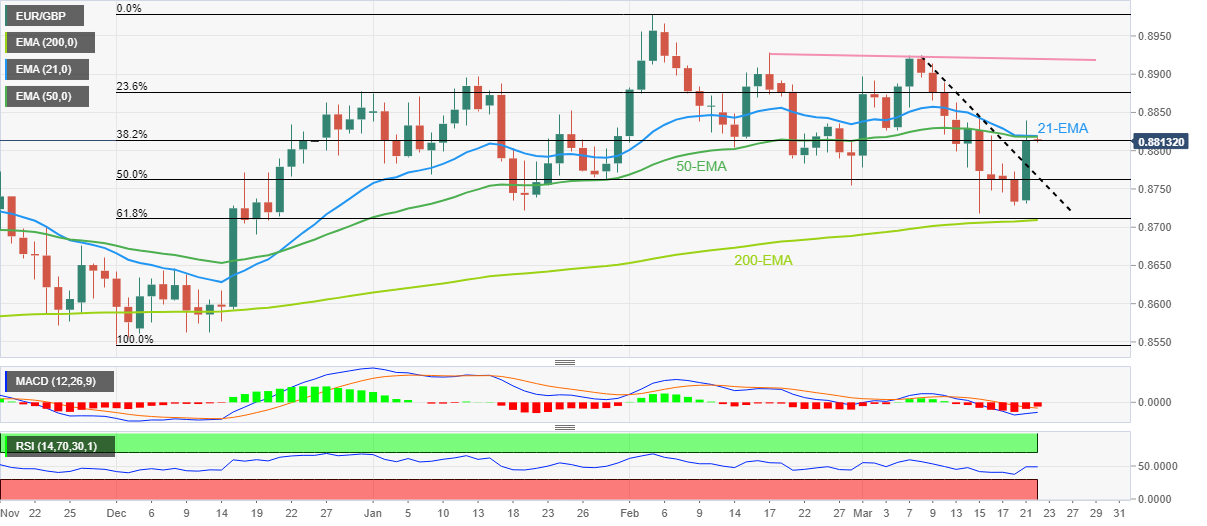
Trend: Further upside expected
- AUD/JPY formed a bullish harami candle pattern, suggesting the pair is upward biased.
- However, oscillators are still pointing south, so caution is warranted.
- AUD/JPY Price Analysis: Once it clears 89.00, that would pave the way toward 90.00.
The AUD/JPY trimmed some of its Monday losses on Tuesday and gained 0.16%. The pair formed a bullish harami two-candle pattern that could open the door for further gains, but firstly it needs to the region the 89.00 figure. At the time of writing, the AUD/JPY is trading at 88.32, up 0.01% as the Asian session begins.
AUD/JPY Price action
On Monday, the AUD/JPY printed a new YTD low at 87.12, then rallied above the 88.00 mark and registered a huge spinning top candlestick. On Tuesday, price action shrank, as usual, ahead of the US Federal Reserve’s (Fed) monetary policy meeting and formed a hammer. Additionally, price action was well contained within the previous day and formed a bullish harami. That said, the AUD/JPY is headed upward, although oscillators, such as the Relative Strength Index (RSI), stay in bearish territory.
Therefore, the AUD/JPY first resistance would be the March 21 high at 88.50, followed by the 89.00 mark. Once broken, the AUD/JPY would challenge the March 20 high at 89.23. A breach of the latter will expose the 20-day Exponential Moving Average (EMA) at 89.67. ahead of reaching 90.00.
In an alternate scenario, an AUD/JPY bearish continuation could happen if the pair dives below the March 21 lows of 87.71, putting into play a fall toward new YTD lows at 87.12.
AUD/JPY Daily chart

AUD/JPY Technical levels
“Will allocate more than 2 trillion yen from reserves for measures to cushion blow to economy from rising prices,” said Japanese Chief Cabinet Secretary Hirokazu Matsuno during early Wednesday in Asia.
Reuters also mentioned that Matsuno made the comment at a government meeting to decide on the package of measures, which includes fresh cash payouts to low-income households and subsidies to curb households' electricity bills.
The news confirms the previous day’s headlines from Japanese media Yomiuri that signaled the government’s efforts to defend the citizens from rising prices. The news also stated that the subsidies on Liquefied Petroleum (LP) gas is recommended for low-income households.
“The pillar is to add a total of 1.2 trillion yen to the “regional revitalization temporary subsidy” that promotes measures at the discretion of local governments, so that they can respond more flexibly to the actual situation of the region,” said Yomiuri before the latest decision.
Also read: USD/JPY finds stability near 132.50, as market eagerly awaits the Fed’s decision
- NZD/USD is looking to recapture the immediate resistance of 0.6200 amid the risk-on mood.
- The Fed is preparing for a consecutive 25bp rate hike despite fears of a banking sector meltdown.
- The demand for US Existing Home Sales soared amid cracked-down prices.
The NZD/USD pair has shown a recovery move from 0.6167 and is focusing to recapture the round-level resistance of 0.6200 in the early Asian session. The upside bias in the kiwi asset looks solid despite the Federal Reserve (Fed) is preparing for a consecutive 25 basis point (bp) rate hike for its March monetary policy.
S&P500 carry forwarded Monday’s recovery in Tuesday’s session and settled it on a promising note. This portrays a risk-on market mood as investors have digested the continuation of the policy-tightening spree by the Fed. The US Dollar Index (DXY) is struggling in maintaining its auction above 103.20 as investors are still not convinced that a liquidity influx of $30 billion into the First Republic Bank would safeguard it from the debacle.
Apart from the interest rate decision, guidance on borrowing rates through the Dot plot, inflation projections, and updates on the banking fiasco will be of utmost importance. Economist at UOB Group Lee Sue Ann suggested the Fed is likely to raise the Fed Funds Target Range by 25 bps at both its March and May gatherings. Fed chair Jerome Powell to bound to bring down the stubborn inflation and it would be interesting to see how he would handle the sticky inflation amid the banking sector shakedown.
On Tuesday, a solid recovery in United States Existing Home Sales data conveyed that the demand for real estate is recovering. Existing Home Sales in the US rose by 14.5% in February to an adjusted annual rate of 4.58 million, the National Association of Realtors (NAR) reported. It seems that cracked prices of real estate due to prolonged weaker demand amid higher interest rates have infused confidence among home buyers.
Meanwhile, the New Zealand economy is struggling to revive after the flood situation, which resulted in superlative liquidity flush into the economy and a vulnerable growth rate. However, the Reserve Bank of New Zealand (RBNZ) would continue to elevate the Official Cash Rate (OCR) to scale down persistent inflation.
- GBP/JPY remains sidelined after rising the last two consecutive days.
- Recovery in yields favors bulls ahead of the key day comprising multiple data/events.
- Japan’s return from holiday, UK House of Commons vote on Brexit bill and British CPI for February in focus.
GBP/JPY remains mildly offered near 161.70 as it pares the recent gains ahead of the key day, snapping two-day uptrend at the latest.
In doing so, the cross-currency pair justifies the market’s fears amid negative reception of UK PM Rishi Sunak’s Brexit deal among some of the fellow Conservatives and the European Research Group (ERG). On the same line could be the looming fears of the Bank of England’s (BoE) likely dovish hike as the banking crisis challenges the “Old Lady”, as the UK central bank is informally known.
It should be noted that the recovery in the US Treasury bond yields and Tuesday’s holiday in Japanese markets allowed the quote to remain firmer of late. That said, the US 10-year and two-year Treasury bond yields stretched late Monday’s bounce off the lowest levels since September 2022 to 3.60% and 4.18% respectively.
While tracing the latest rebound in the bond coupons, the comments from the US policymakers, as well as actions, to tame the fears emanating from the latest banking fallouts gain major attention. Among them, US Treasury Secretary Janet Yellen’s comments gained major attention as she said, "Treasury, Fed, FDIC actions reduced risk of further bank failures that would have imposed losses on deposit insurance fund." Earlier on Tuesday, Bloomberg shared the news stating that the “US officials are studying ways they might temporarily expand Federal Deposit Insurance Corporation (FDIC) coverage to all deposits, a move sought by a coalition of banks arguing that it’s needed to head off a potential financial crisis.”
It should be noted that the talks of the US authorities discussing ways to surpass Congress to defend the banks also seem to have underpinned the yields and the GBP/JPY rebound.
However, the cautious mood ahead of today’s UK’s Consumer Price Index (CPI) data for February, expected 9.8% YoY versus 10.1% prior, prod the bulls. On the same line is the anxiety surroudning Brexit voting in the UK’s House of Commons amid recent rejections from the European Research Group (ERG) and the Democratic Unionist party (DUP).
Technical analysis
GBP/JPY grinds higher between a one-month-old descending resistance line and an ascending support line from mid-January, respectively near 163.30 and 160.75 in that order.
- USD/JPY gains ground, as the rising US Treasury yields boost the currency pair.
- FOMC meeting takes center stage with markets converging on a 25 bps rate hike consensus.
- Banking development and diplomatic developments supporting USD/JPY resurgence.
USD/JPY finds some respite on the back of rising US Treasury (UST) bond yields. U.S. Treasury Secretary Janet Yellen informed bankers on Tuesday that she is ready to intervene to protect depositors in smaller U.S. banks amid contagion concerns.
The strong commitment from US officials has ignited a positive risk appetite, leading Wall Street to close Tuesday on a positive note. UST yields experienced a strong bounce as investors moved away from bonds and into riskier assets.
Tuesday's upbeat sentiment received additional support from a meeting between Chinese President Xi and Russian President Putin. Putin suggested that Chinese proposals could form the basis of a peace settlement, but noted that the West and Kyiv were not yet prepared.
Investors' attention has now shifted to the FOMC meeting on Wednesday, as volatility subsided due to increased stability in the banking sector. Markets are pricing in an 85% chance of a 25-basis-point (bps) rate hike from the Federal Reserve (Fed).
Despite the ongoing banking turmoil, the market is finding consensus for a 25 bps rate hike, following the argument that liquidity injections and rate hikes can both occur simultaneously.
It is likely that the US Treasury will take measures to support deposit guarantees, despite opposition from some senators. However, such a support plan must first pass through the parliamentary process.
Given that the summary of projections for the upcoming Fed meeting was conducted before the banking turmoil, the focus will shift to the accompanying statement and dot plots. The most crucial aspect will likely be the opening remark during Fed Chair Powell's press conference and his assessment of the ongoing banking crisis.
Any indication of a pause in rate hikes is expected to be positive for risk assets.
Levels to watch
- USD/CHF turns neutral bearish after dropping below the 50/20 day EMAs.
- USD/CHF Price Analysis: Downward is biased in the near term and might fall beneath 0.9200.
USD/CHF erased Monday’s gains and fell below crucial technical indicators on Tuesday. A risk-on impulse and a soft UD Dollar (USD) were the main reasons for the USD/CHF pair fall. At the time of writing, the USD/CHF is exchanging hands at 0.9222.
USD/CHF Price action
From the daily chart perspective, the USD/CHF remains neutral-to-downward biased. After falling below the 50 and 20-day Exponential Moving Averages (EMAs) at 0.9290 and 0.9273, the USD/CHF accelerated its downfall toward the current exchange rates. Consequently, oscillators turned bearish, meaning the USD/CHF could dive toward the March 15 low at 0.9122.
The USD/CHF 4-hour chart portrays the pair as downward biased after breaking below the 0.9239-0.9317 range. Furthermore, the Relative Strength Index (RSI) is bearish, while the Rate of Change (RoC) shows sellers are in charge.
Therefore, the USD/CHF first support would be the 0.9200 figure. A breach of the latter will expose the S1 daily pivot at 0.9182, followed by the S2 pivot at 0.9142 and the 0.9100 mark. In an alternate scenario, the USD/CHF first resistance would be the daily pivot at 0.9250, followed by the R1 pivot point at 0.9288, before testing 0.9300.
USD/CHF 4-hour chart
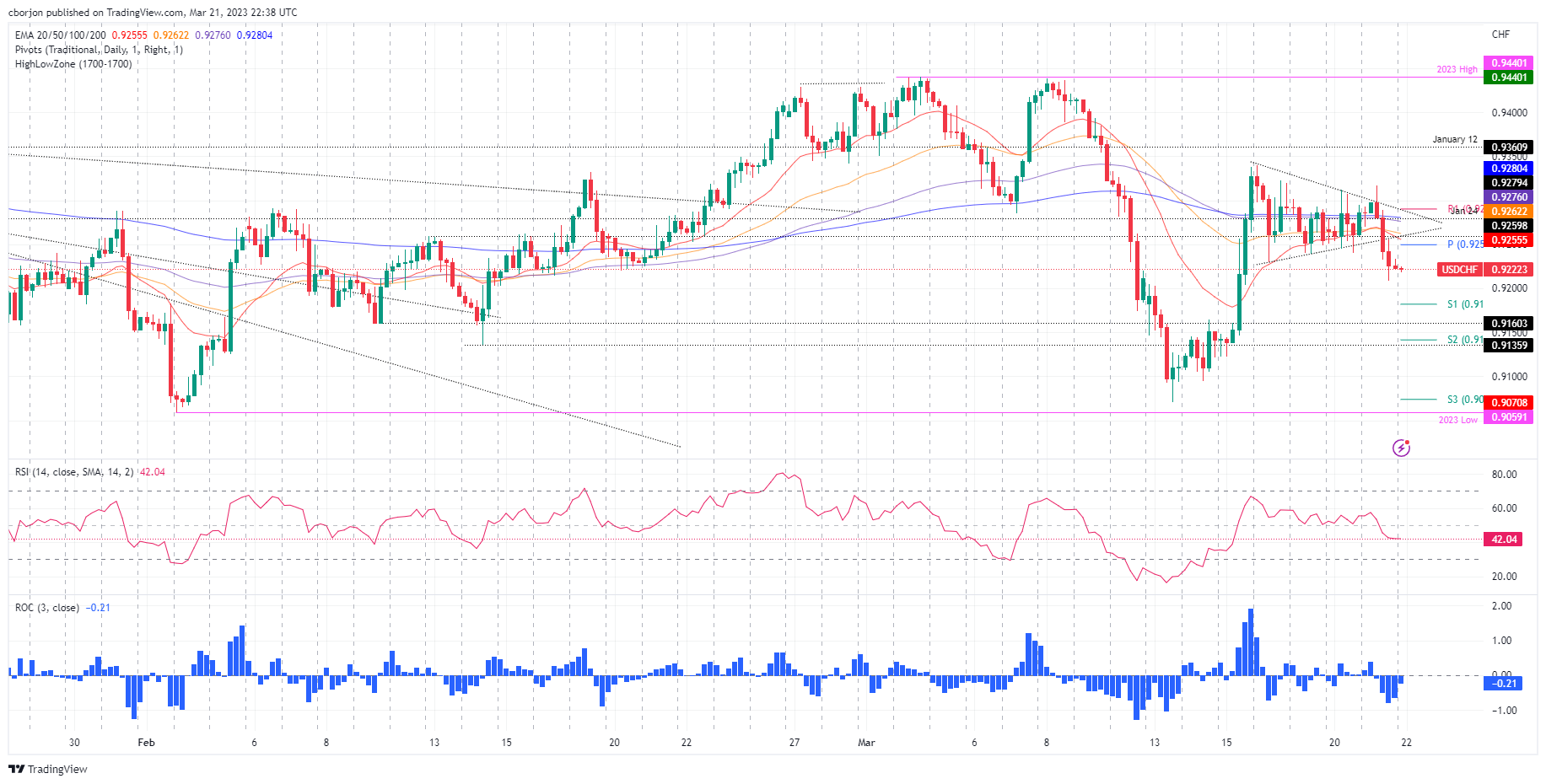
USD/CHF Technical levels
- USD/CAD struggles to defend the bounce off two-week low inside short-term triangle.
- Convergence of 50-SMA, triangle’s top line challenge Loonie pair buyers.
- Bears have a bumpy road to travel before retaking control.
- Sustained trading beyond key SMA, bullish chart pattern and absence of momentum-negative oscillators favor buyers.
USD/CAD grinds near 1.3715-20 as it resists welcoming bulls during the initial hours of the Federal Reserve (Fed) day. In doing so, the Loonie pair struggles to extend the previous day’s recovery moves from the lowest levels in a fortnight inside a two-week-old descending triangle formation.
That said, the quote’s latest hesitance could be linked to the failure to cross the 1.3730 resistance confluence including the 50-SMA and upper line of the stated triangle.
However, the Loonie pair’s ability to provide successful trading above the key SMAs joins the bullish MACD signals and firmer RSI (14), not overbought, keeps the USD/CAD bulls hopeful of overcoming the 1.3730 hurdle.
In that case, the buyers could aim for the monthly high surrounding 1.3865, with the 1.3800 round figure acting as an intermediate halt, before portraying a run-up towards the previous yearly top of 1.3977 and then to the 1.4000 psychological magnet.
On the flip side, the USD/CAD bears need validation from the stated triangle’s lower line, close to 1.3650. Even so, the 200-SMA support near 1.3575 appears a crucial challenge for the sellers to tackle. It’s worth noting that the 100-SMA can offer immediate support near 1.3695.
Overall, USD/CAD is likely to remain firmer but the immediate pullback can’t be ruled out.
USD/CAD: Four-hour chart
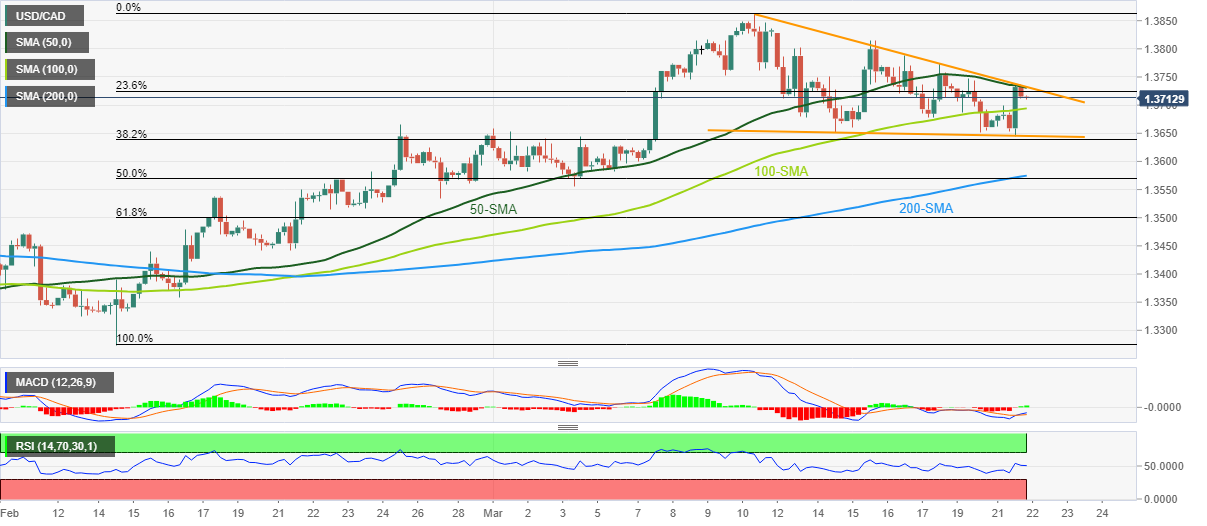
Trend: Further upside expected
- Gold bulls are being squeezed in a strong bearish correction.
- All eyes turn to the Fed as the next catalyst.
Gold price sold off nicely on Tuesday in textbook fashion as the technical analysis below illustrates. The yellow metal dropped from a high of $1,970 and melted into a low of $1,935. The fall follows a move up above $2,000 intraday Monday, the highest level since Russia's invasion of Ukraine early last year.
Gold prices are pressured with the 10-year government bond rebounding on Tuesday, making it more appealing to hold Treasurys than gold as we head into the Federal Reserve interest rate decision on Wednesday. The central bank is expected to raise interest rates by a quarter-percentage point which could further cool gold's rally even further.
All in all, it was a risk on tone across markets that has weighed on the Gold price whereby the market now sees a roughly 80% chance of a 25bp hike. However, analysts at ANZ Bank argued that ´´this would ultimately support the precious metals sector.´´
Meanwhile, analysts at TD Securities argued that, ´´looking forward, we still could see substantial CTA buying activity above the $2,045 mark, but the journey towards this key trigger level will require additional discretionary interest. This puts the focus on the Fed meeting, where we expect a dovish 25bp hike.´´
´´In contrast,´´ they said, ´´we could see some marginal selling activity below the $1,950 mark, but expect that the combination of strong physical demand and resurgent investor flows should keep prices from tumbling.´´
Gold technical analysis
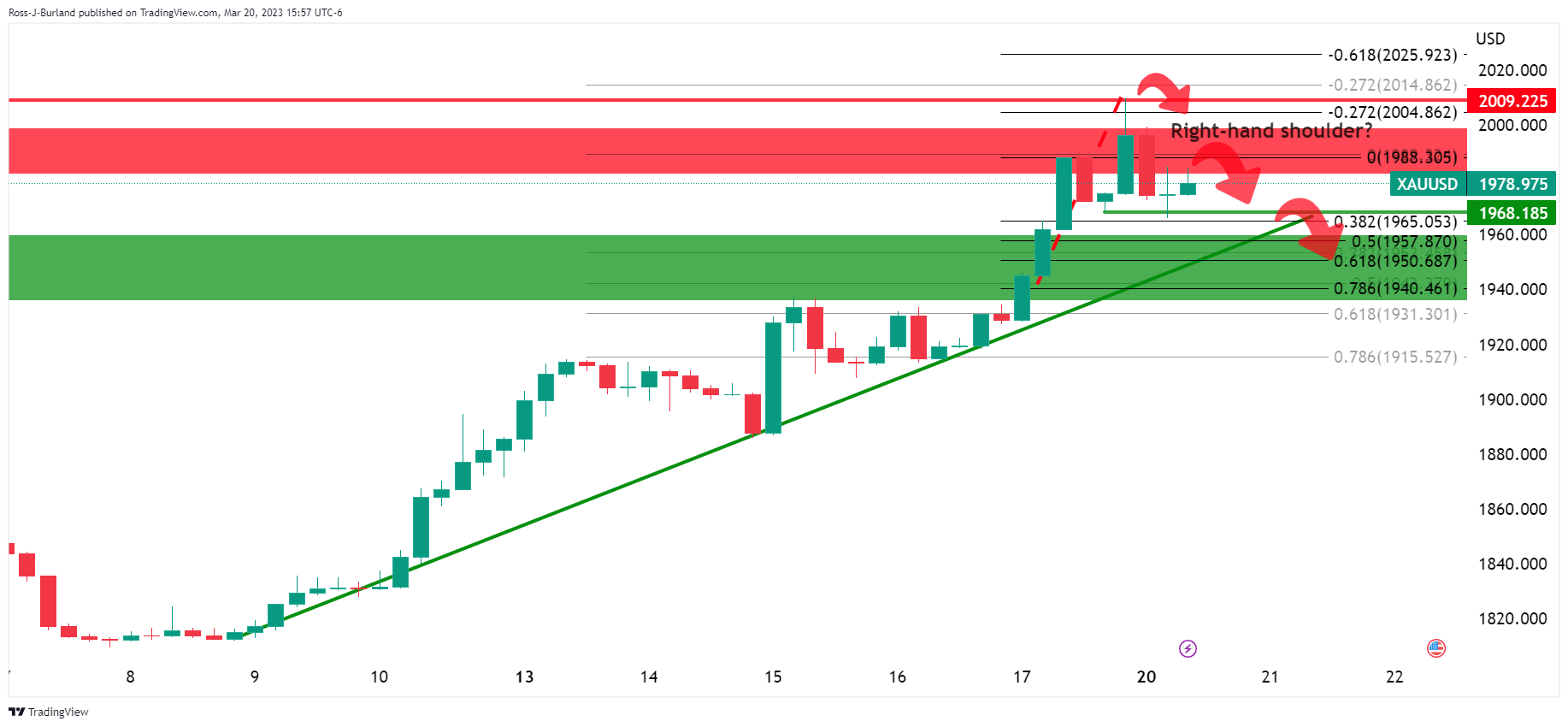
In the prior analysis, above, it was stated that ´´the Gold price could be forming a topping pattern in the right-hand shoulder of the head and shoulders on the 4 and 1-hour charts:
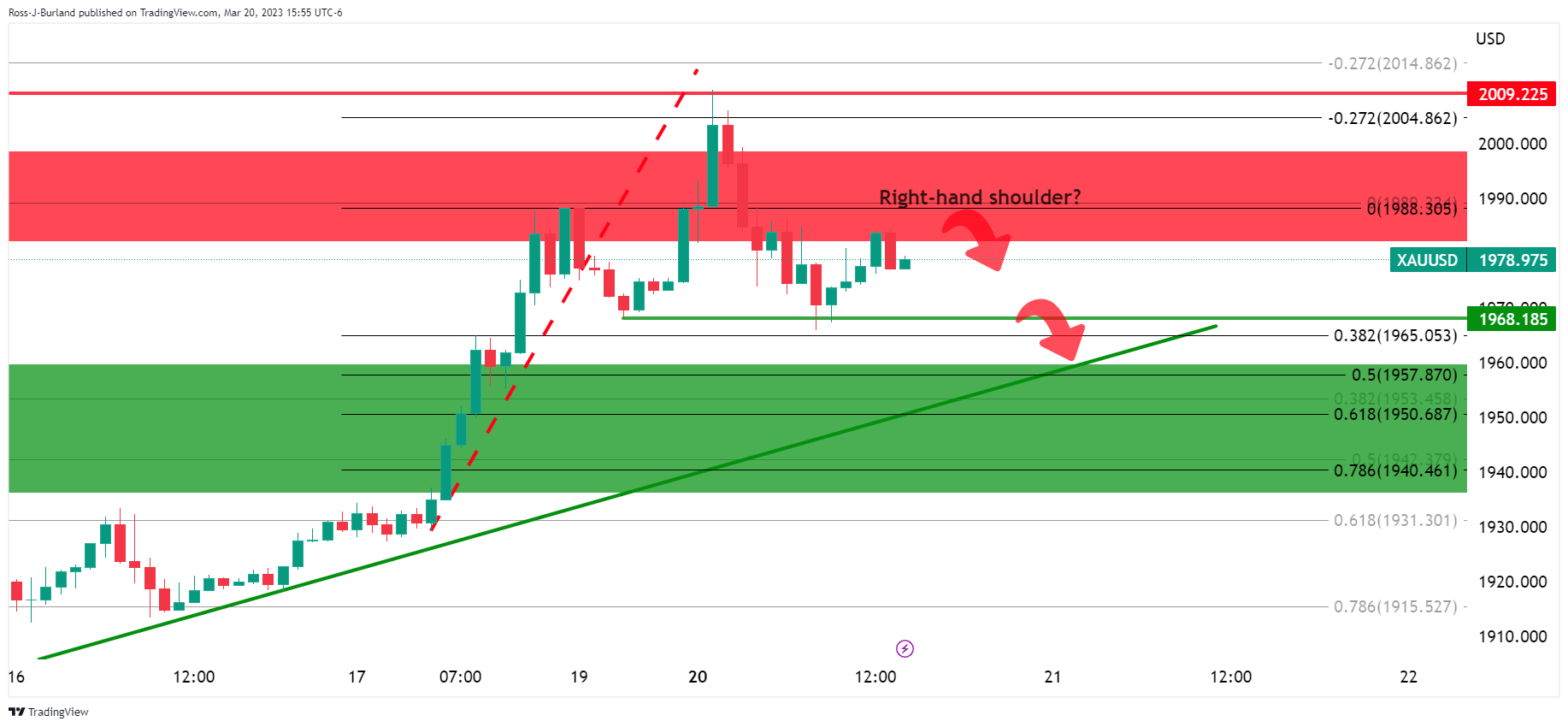
Gold price update
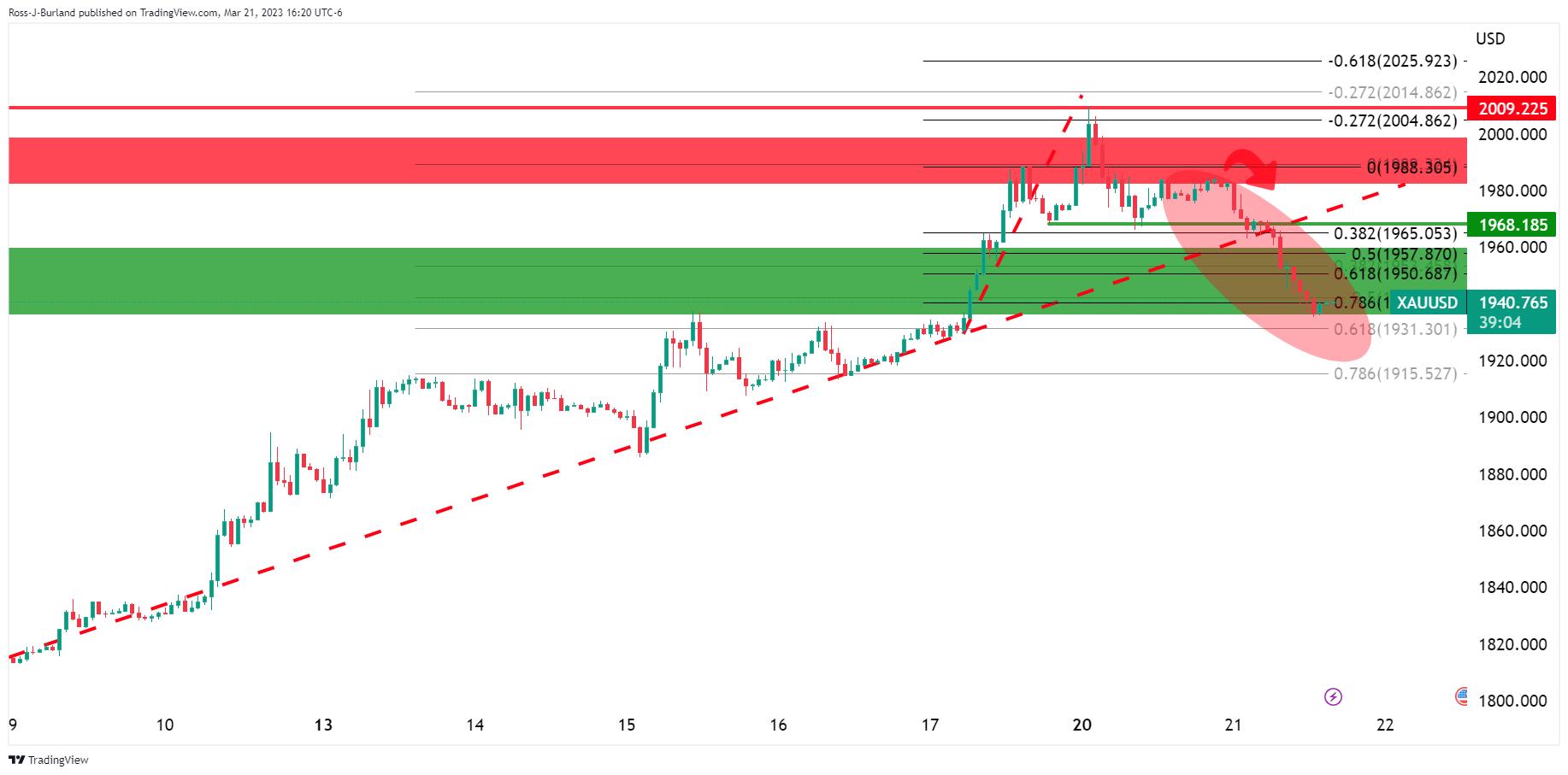
The head and shoulders played out and now the price is on the backside of a critical trendline.

However, there are prospects of a meanwhile correction into the Fibonacci scale prior to the next surge to the downside.
- EUR/USD is juggling around 1.0780, gathering strength for a fresh upside.
- Odds are favoring that the Fed would go for hiking rates despite knowing the banking sector debacle.
- Eurozone-ZEW Survey dropped to 10.0 after a five-month rising spell.
The EUR/USD pair has turned sideways in the early Tokyo session after printing a fresh five-week high at 1.0788 on Tuesday. The major currency pair has been underpinned despite the odds favoring a 25 basis point (bp) rate hike by the Federal Reserve (Fed). As per the CME Fedwatch tool, more than 87% chances are in favor of a 25 bps rate hike, which would push rates to 4.75-5.00%.
The context that has spooked the market’s sentiment is that Fed chair Jerome Powell would go for hiking rates despite knowing the banking sector debacle whose consequences are yet to be faced ahead.
Meanwhile, a two-day winning spell by S&P500 has shown that the market is trying hard to revive itself from the banking sector shakedown. The risk appetite theme has also weighed on the US Dollar Index (DXY). The USD Index looks vulnerable above 103.00 and is prone to further downside.
On the Eurozone front, the banking sector debacle has hurt the sentiment of the market participants. Eurozone-ZEW Survey that considers the sentiment of institutional investors dropped to 10.0 after a five-month rising spell.
EUR/USD is struggling to extend the 50% Fibonacci retracement (placed from February 01 high at 1.1033 to March 15 low at 1.0516) at 1.0776 on a four-hour scale. Usually, a perpendicular rally in an asset is followed by a mean reversion to near the 20-period Exponential Moving Average (EMA), which is hovering around 1.0711, at the time of writing.
The Relative Strength Index (RSI) (14) is oscillating in the bullish range of 60.00-80.00, which indicates that the upside momentum is active.
For further upside, the shared currency pair needs to surpass the immediate resistance plotted from January 20 low at 1.0802, which will drive the asset toward January 18 high at 1.0887 and the round-level resistance at 1.0900.
On the flip side, a downside break below March 17 low at 1.0612 would drag the shared currency pair toward March 16 low at 1.0551, followed by March 15 low at 1.0516.
EUR/USD four-hour chart
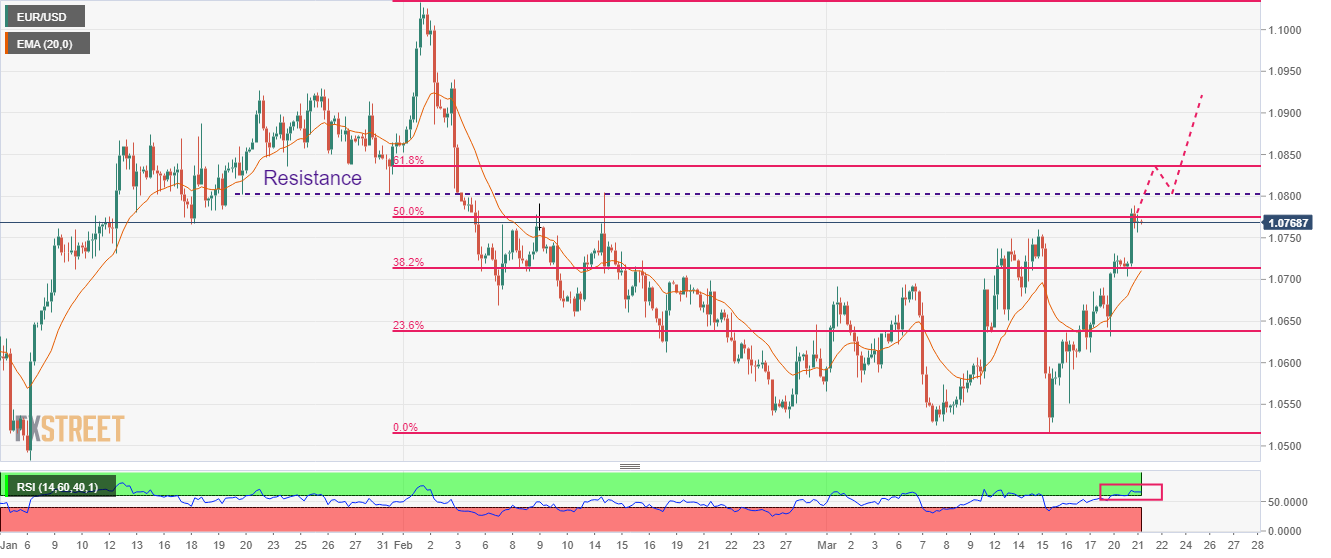
- GBP/USD picks up bids to reverse the first daily negative close in four, grinds higher of late.
- Improvement in market sentiment, US Treasury bond yields allow US Dollar to stabilize near multi-day low.
- Mixed concerns over Brexit deal’s acceptance, hawkish Fed bets tease sellers.
- UK inflation data for February will be the key ahead of “Super Thursday”.
GBP/USD stays defensive around 1.2220-10 as the Cable bears struggle to keep the reins after entering the ring for the first time in four days. Also challenging the quote could be the market’s cautious mood ahead of the key data/events as the Federal Reserve (Fed) decision data begins.
The Cable pair’s latest losses could be linked to the improvement in the market’s sentiment and a rebound in the US Treasury bond yields that allowed the US Dollar to pro recent south-run at the five-week low.
Behind the moves could be the comments from the US policymakers, as well as actions, to tame the fears emanating from the latest banking fallouts.
Among them, US Treasury Secretary Janet Yellen’s comments gained major attention as she said, "Treasury, Fed, FDIC actions reduced risk of further bank failures that would have imposed losses on deposit insurance fund." Earlier on Tuesday, Bloomberg shared the news stating that the “US officials are studying ways they might temporarily expand Federal Deposit Insurance Corporation (FDIC) coverage to all deposits, a move sought by a coalition of banks arguing that it’s needed to head off a potential financial crisis.”
Amid these plays, the benchmark Wall Street indices closed with more than 1.0% daily gains each whereas the US 10-year and two-year Treasury bond yields stretched late Monday’s bounce off the lowest levels since September 2022 to 3.60% and 4.18% respectively.
Looking ahead, the GBP/USD pair appears more interesting to watch as Brexit voting in the UK’s House of Commons will be crucial amid recent rejections from the European Research Group (ERG) and the Democratic Unionist party (DUP).
Also important will be the UK’s Consumer Price Index (CPI) data for February, expected 9.8% YoY versus 10.1% prior, as the same could hint at the Bank of England’s (BoE) action on the “Super Thursday”.
Above all, the Federal Reserve’s (Fed) reaction to the banking crisis will be crucial to watch for clear directions as the 0.25% rate hike is already priced in.
Also read: Federal Reserve Preview: Powell to persevere and raise rates, US Dollar set to (temporarily) rise
Technical analysis
A four-month-old horizontal resistance area surrounding 1.2270-90 challenges the GBP/USD bulls cheering a sustained break of the 50-DMA hurdle surrounding 1.2145.
- AUD/USD is struggling in extending its recovery above 0.6670 ahead of Fed policy.
- RBA policymakers still believe that Australian inflation could show volatility in the inflation monthly figures.
- A two-day winning spell in S&P500 is conveying confidence among investors despite fears of potential banking shakedown.
The AUD/USD pair is facing barricades in extending its recovery move above the immediate resistance of 0.6670 in the early Asian session. The Aussie asset is expected to remain volatile ahead as investors are awaiting the Federal Reserve (Fed) monetary policy for fresh impetus. The Australian Dollar remained in action on Tuesday after the release of the Reserve Bank of Australia (RBA) monetary policy minutes.
According to the RBA minutes, policymakers were considering a pause in the tightening process just after a two-month fall in the monthly Consumer Price Index (CPI) numbers. However, RBA policymakers still believe that Australian inflation could show volatility in the inflation figures on a month-on-month basis. Also, the surety lacks that inflation has peaked now.
Meanwhile, S&P500 continued its recovery move firmly on Tuesday, portraying a steep rise in the risk appetite of the market participants. A two-day winning spell is conveying confidence among investors despite fears of potential banking shakedown after the collapse of three mid-size United States banks in a span of one week.
The US Dollar Index (DXY) has shown a recovery move from the cushion of 103.00 and sheer volatility is expected as investors are likely to react to changing odds for the interest rate decision by the Fed. Odds for an unchanged policy are solid as the street anticipates that further rate hikes by the fed would be unable to restore the confidence of investors after banking sector fiasco. Also, investors are worried that a liquidity influx of $30 billion into First Republic Bank is unable to get the institution out of trouble.
- The S&P 500, the Dow Jones, and the Nasdaq 100 advanced sharply in the day.
- US Treasury bond yields climbed ahead of the FOMC’s meeting.
- Investors focus shifted toward the Federal Reserve’s monetary policy decision.
Wall Street finished the day with gains, spurred by optimism in the financial markets, which triggered gains in the S&P 500, the Dow Jones, and the heavy-tech Nasdaq Composite. As the New York session ended, the S&P 500 gained 1.3%, 4,002.87, while the Dow Jones climbed 0.98%, 32,560.60. The Nasdaq Composite led the pack, up 1.58%, at 11,860.11.
US equities rose, sponsored by a risk-on impulse
Investors had shrugged off the banking system’s woes. On Tuesday, the Secretary of Treasury Janet Yellen stated that if regulators perceive a potential run on the banking system, the federal government could intervene to safeguard depositors at more banks. Data-wise, Existing Home Sales in the United States (US) rose above the prior’s month figures as lower mortgages boosted sales. Existing Home Sales in February rose by 14.5% MoM, crushing the 5% consensus, and ended a 12-month run of declines in sales.
Aside from this, US Treasury bond yields jumped, with 2s and 10s gaining 18 and 12 basis points, respectively, ahead of tomorrow’s Federal Reserve’s decision. The US 2-year Treasury bond yield is 4.179%, while the 10-year rate is 3.607%.
Traders focus shifted toward the US Federal Reserve monetary policy decision, with investors expecting a 25 bps rate hike by the Fed. However, tomorrow’s spotlight would be Fed Chair Jerome Powell’s press conference, which would be scrutinized by investors expecting Powell to deliver any forward guidance.
Sector-wise, Energy, Consumer Discretionary, and Financials led the pack, each up 3.45%, 2.71%, and 2.54%. Contrarily, Utilities, Real Estate, and Consumer Staples finished with losses of 2.05%, 0.66%, and 0.12%m respectively.
In the FX space, the US Dollar Index (DXY), a measure that tracks the buck’s value against a basket of six currencies, lost 0.09%, down at 103.214, after hitting a YTD low of 103.000.
What to watch?
The US calendar will feature the Federal Reserve Open Market Committee (FOMC) monetary policy meeting, alongside the Fed Chairman Jerome Powell press conference, at around 18:00 and 18:30 GMT.
S&P 500 Daily chart
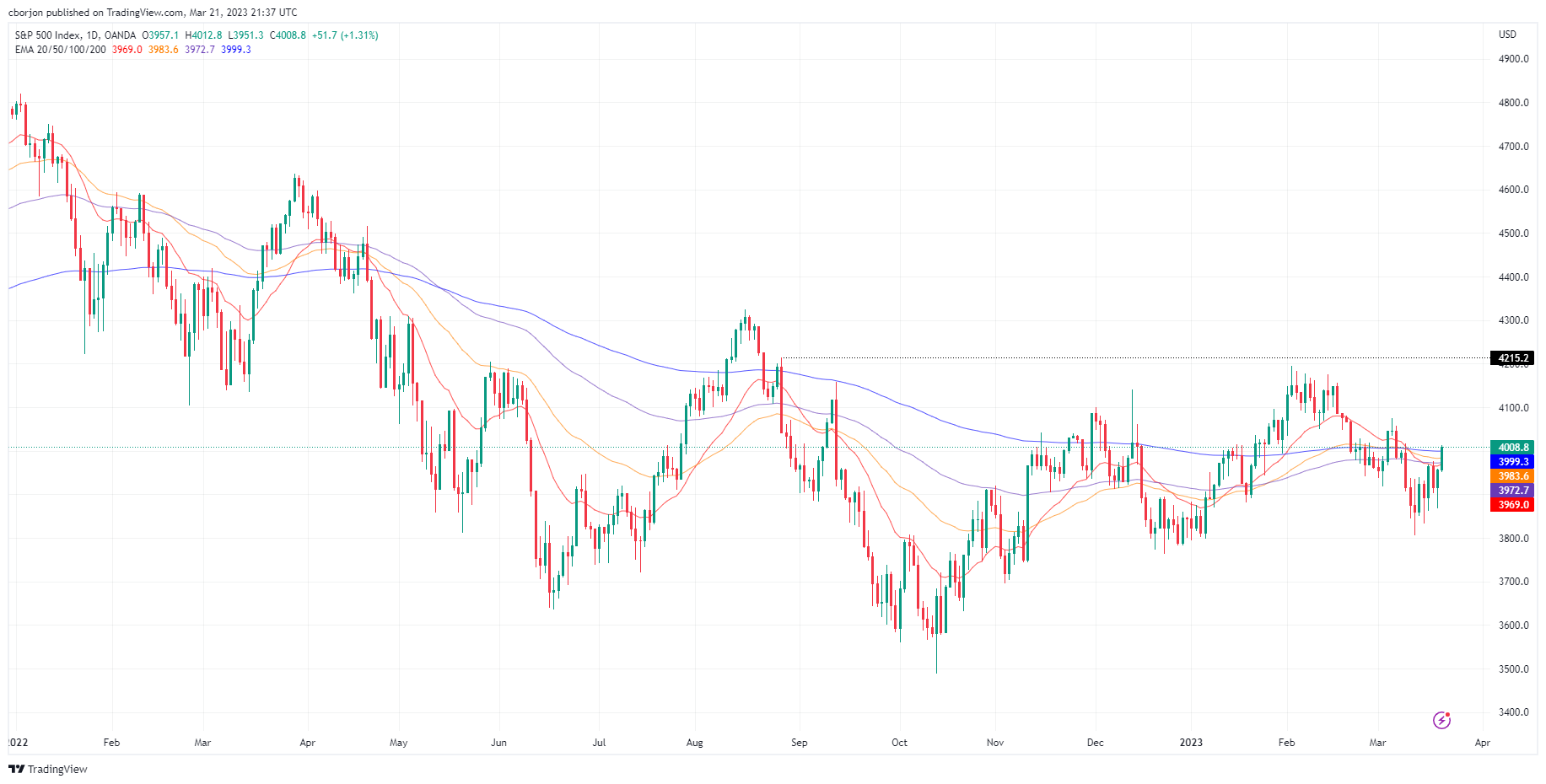
- Crude is higher as investors regained some confidence in the economic outlook
- WTI traders turn to the Fed for the next catalyst.
West Texas Intermediate WTI crude is trading up by some 2.4% towards the close on Wall Street and rallied from a low of $66.96 to a high of $69.72 as investors regained some confidence in the economic outlook following the weekend rescue of Credit Suisse.
Meanwhile, the Federal Reserve will announce the interest rate decision on Wednesday after it began its two-day meeting on Tuesday whereby markets are pricing in the likelihood that it will end with a quarter-point hike to interest rates. Swiss authorities helped to calm market fears of an extended banking crisis and crude prices are now 3.9% higher since the week began after dropping by 13% last week. The black gold has also rallied as investors rushed back into risk assets following more assurances from regulators on support for the US banking sector. T
´´The potential expansion of FDIC’s coverage to all deposits soothed concerns of further bank runs. The support was aided by further supply-side issues. Russian extended its 500kb/d crude output cut through June,´´ analysts at TANZ Bank explained.
´´This was based on current market conditions, according to Deputy Prime Minister Alexander Novak. This is despite tanker tracking data showing little sign of reduction in trade. Broader sentiment remains bullish, with top traders saying oil’s fundamentals are getting stronger. There are concerns that supply may also get hit more than demand amid the banking crisis. US shale output is most at risk from tighter credit conditions from regional US banks.´´
Meanwhile, we have the pair of weekly US oil inventory reports starting with trade group API today followed by the official EIA inventory data on Wednesday. The API has shown a large headline build vs. the draw expected.
Apart from that, traders are unlikely to position too heavily one way or another before the Federal Reserve makes its highly anticipated announcement on interest rates tomorrow. The central bank is still expected to continue to try and slow the US economy to lower inflation, despite the banking crisis and the fears it could spur a demand-destroying recession.
The Fed is expected to hike and take the Fed Funds rate to 4.75%-5.00%. There will also be the dot plot and the post-meeting communication is likely to emphasize that the Fed is not done yet in terms of tightening.
Analysts at TD Securities argued that the officials will likely be flagging the more uncertain economic environment.
´´Treasuries will react to the Fed's messaging around future hikes and the dot plot. Any hint that the Fed will stop hikes due to stability worries could create an outsized market reaction,´´ the analysts said. ´´Messaging and dot-plot will be critical. Our base case is hawkish which poses a risk that STIR vol persists, (The short-term interest rate (STIR) analytics)´´
Here is what you need to know on Wednesday, March 22:
Wall Street indexes rose sharply on Tuesday ahead of the Federal Reserve decision, led by shares of regional banks. First Republic stock rose 29%. The Dow Jones gained 0.98%, and the Nasdaq advanced 1.58%. Banking fears keep easing, paving the way for more tightening from central banks.
US Treasury Secretary Janet Yellen said the US banking system is sound and mentioned the government is ready to take more action to help bank depositors.
US yields rose sharply, with the 10-year reaching 3.60% and the 2-year 4.17%. The German 10-year yield jumped almost 8% to 2.29%.
Data released in the US showed Existing Home Sales jumped 14.5% in February, above the 5% of market consensus, to a 4.58 million-unit pace, the largest monthly increase since December 2015, excluding the volatile pandemic era. The Philly Fed Non-Manufacturing dropped to -12.8 in March.
On Wednesday, the Fed is expected to raise rates by 25 bps; however, there are also calls for a no change and even for a rate cut. Analysts will watch the decision, the projections, the statement and Powell’s words closely. As a result, traders should expect high volatility during the American session.
Federal Reserve Preview: Powell to persevere and raise rates, US Dollar set to (temporarily) rise
EUR/USD rose for the fourth consecutive day, approaching 1.0800 on Tuesday. The pair reached monthly highs before losing momentum. The Euro was among the biggest gainers as the banking crisis eased, suggesting the European Central Bank (ECB) could raise rates further if needed.
GBP/USD pulled back from six-week highs near 1.2300 to 1.2178 and then climbed back above 1.2200. On Wednesday, key inflation data and retail sales are due in the UK. On Thursday, the Bank of England (BoE) will announce its policy decision.
USD/JPY rose to the 132.50 area, having the best day in two weeks, boosted by higher government bond yields. The Japanese Yen was also affected by risk-on flows.
USD/CHF fell from above 0.9300 toward 0.9200. The Swiss National Bank (SNB) will announce its monetary policy decision on Thursday. Market consensus if for a 50 bps rate hike; however some analysts forecast a smaller hike given recent market volatility and uncertainty around the Swiss banking system.
USD/CAD rebounded sharply from weekly lows under the critical 1.3650 area toward 1.3740. Inflation data in Canada showed the Consumer Price Index dropped from 5.9% to 5.2%, the lowest level in 13 months. The Loonie rose for the second day in a row versus AUD and NZD.
AUD/USD and NZD/USD pulled back from weekly highs to 0.6175 and 0.6650, respectively, despite the improvement in global market sentiment. Reserve Bank of Australia (RBA) minutes suggested the central bank is considering a pause at the next meeting.
XRP rose 30% and Bitcoin gained 1.50% on Tuesday and settled at $28,280. So far, in 2023, the largest cryptocurrency has risen 70%.
Gold corrected further to the downside, losing $30 and bottomed around $1,935, weighed by surging US yields.
Crude oil prices rose again, extending the recovery from multi-month lows. The WTI barrel gained 2.49%, approaching $70.00, helped by the better mood across financial markets.
Like this article? Help us with some feedback by answering this survey:
- EUR/GBP bulls capped at the day´s highs ahead of key central bank meetings.
- Eyes are on the BoE, UK data and the Fed.
EUR/GBP is up some 1% on the day but is running into offers at the high of 0.8840. The British Pound came under pressure ahead of the Federal Reserve and Bank of England (BoE) which are both due to meet this week.
Interest rate expectations have shifted dramatically during a tumultuous few weeks in financial markets owing to the risks of contagion in the banking sector. First of all, the Federal will announce its next rate decision on Wednesday, while the Bank of England will convene on Thursday.
As of Tuesday morning, markets were pricing in a 44% chance of no change from the Bank of England, and a 56% chance of a 25 basis-point increase. We will have the United Kingdoms' inflation data on Wednesday also and traders will be looking to this for prospects of some easing.
Analysts at TD Securities say that headline inflation likely fell 0.2ppts in March, in line with the MPC's forecast, on the back of another decline in petrol prices. ´´A shortage of certain vegetables and fruits adds some upside risk to the print. We also expect a rebound in hotel prices and continued strong core goods momentum to keep core inflation elevated.´´
Meanwhile, the Federal Reserve is expected to hike buy maybe just 25bp, taking the Fed Funds rate to 4.75%-5.00%. There will also be the dot plot and the post-meeting communication is likely to emphasize that the Fed is not done yet in terms of tightening.
Analysts at TD Securities argued that the officials will likely be flagging the more uncertain economic environment.
´´Treasuries will react to the Fed's messaging around future hikes and the dot plot. Any hint that the Fed will stop hikes due to stability worries could create an outsized market reaction,´´ the analysts said. ´´Messaging and dot-plot will be critical. Our base case is hawkish which poses a risk that STIR vol persists, (The short-term interest rate (STIR) analytics)´´
- USD/JPY is on the backside of the prior bear trend which gives a bullish bias.
- A 50% mean reversion comes in at 131.80 meeting the neckline structure.
USD/JPY is up on the day by some 0.9% as the pair moves in on prior resistance near 132.60, making its way to the backside of the prior bearish trend. This leaves the outlook bullish for the days ahead.
Meanwhile, the Federal Reserve began a two-day meeting earlier on Tuesday and the central bank is expected to raise interest rates by 25 basis points on Wednesday, or skip a chance at raising borrowing costs this month.
The following illustrates the technical outlook as per the falling wedge on the 4-hour charts and the W-formation:
USD/JPY H4 charts
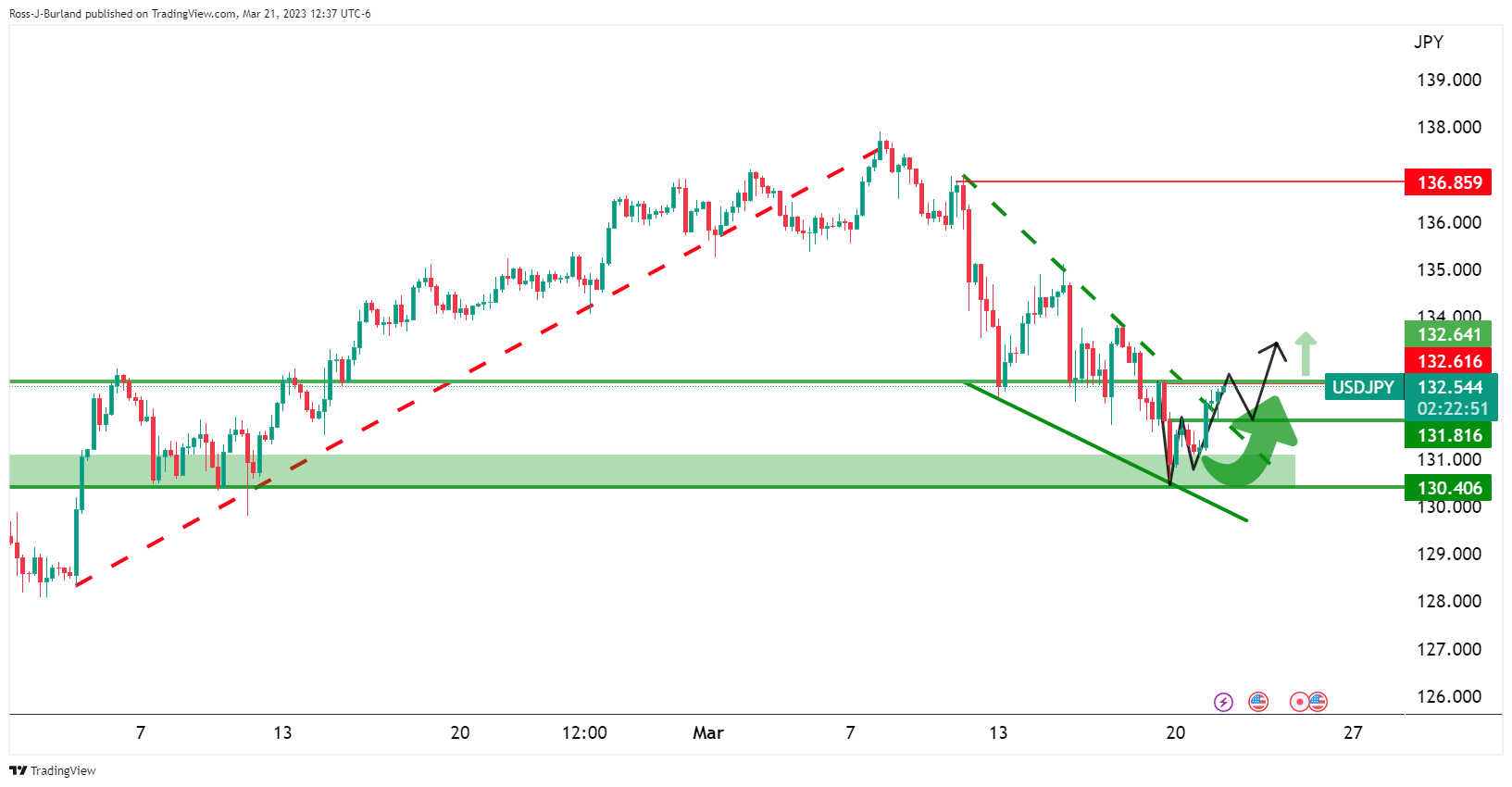
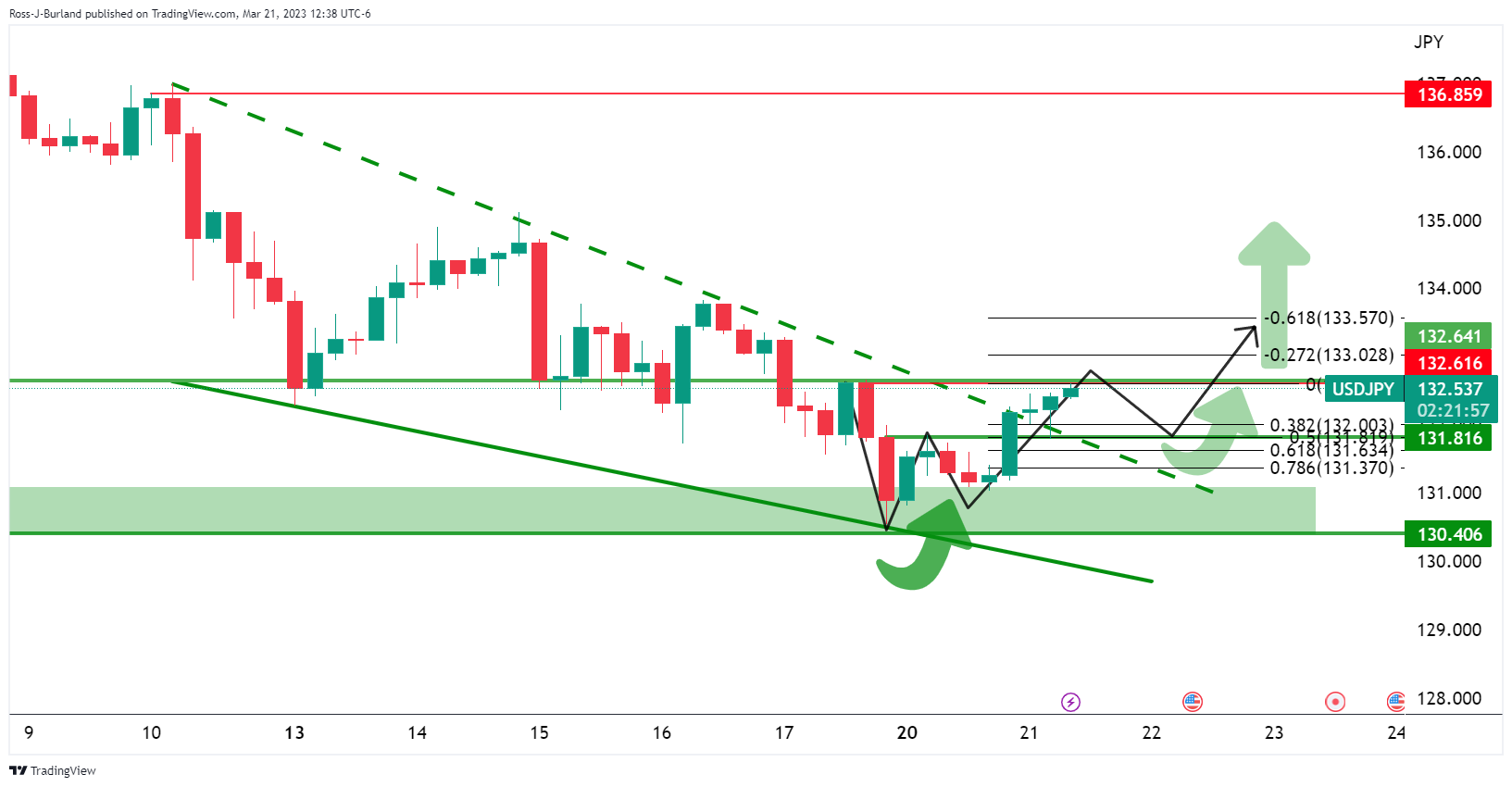
The W-formation shows the price meeting prior resistance and a restest of the neckline, which would be expected to act as support, could be the final show from the bears as bulls take control.
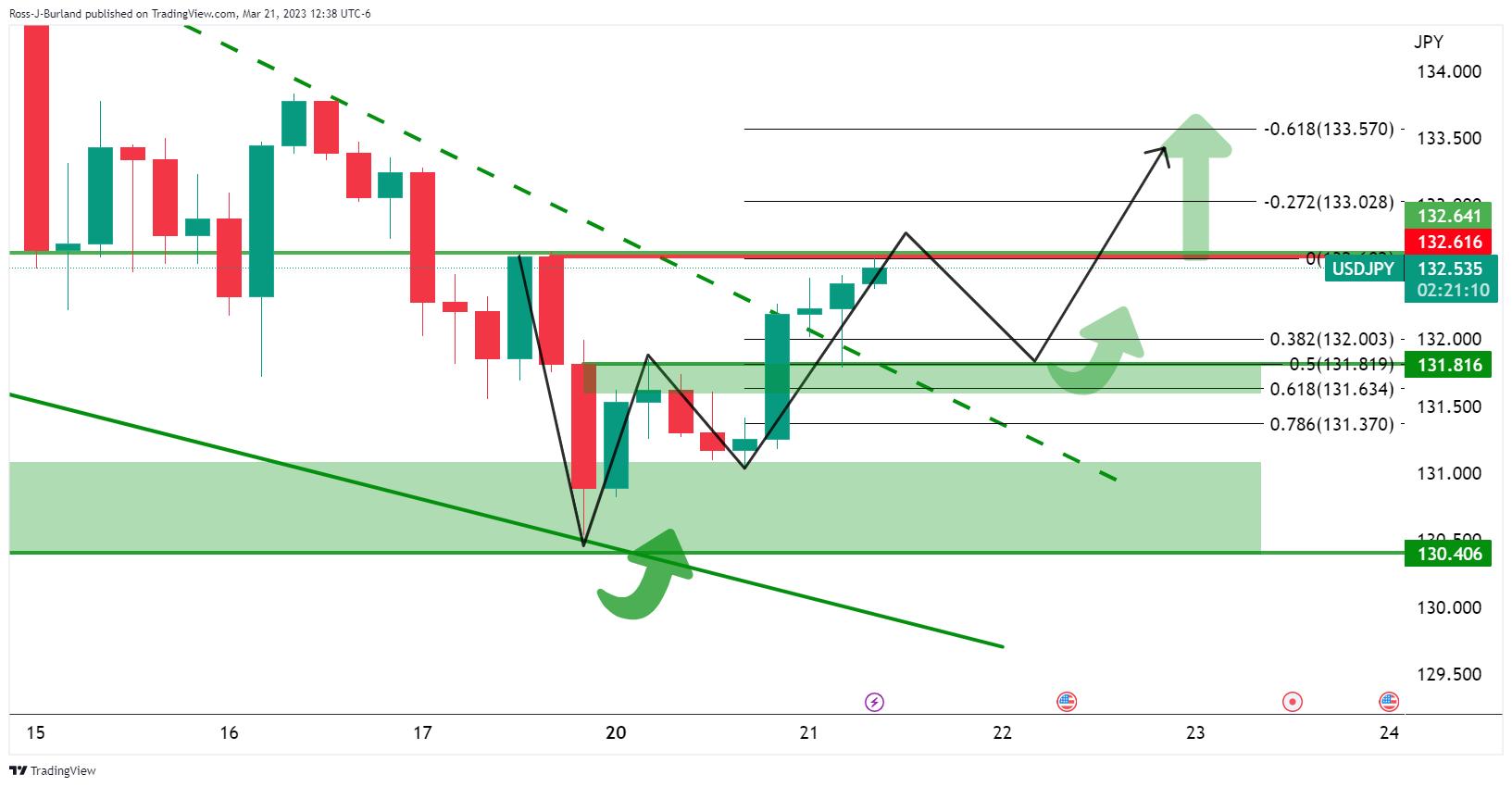
The price is on the backside of the prior bear trend and a 50% mean reversion comes in at 131.80 meeting the necklines structure.
- XAG/USD drops on risk-on mood and technical factors as a dragonfly doji emerges.
- If the XAG/USD drops below $22.00, sellers would face support barricades in the $21.80-90 area.
- XAG/USD Price Analysis: To consolidate around familiar levels ahead of the FOMC’s decision.
Silver price reversed its bullish course, dropping around 1.20% late in the mid-North American session. After hitting a seven-week high of $22.71 on Monday, the XAG/USD has retraced some of those gains, trading nearby March’s 20 daily low of $22.22. At the time of writing, the XAG/USD is trading at $22.29, down 0.27 percent.
XAG/USD Price action
The week began with the white metal printing a new multi-week high before reversing and closing above $22.50. On its way north, the XAG/USD reclaimed the 200-day EMA, shifting the white metal bias to neutral upwards. Nevertheless, a dragonfly doji emerged at the daily, exacerbating Silver’s fall toward the $22.20 area.
If XAG/USD tumbles below $22.00, that would pave the way for a dip to the 50-day EMA at $21.91, immediately followed by the 100-day EMA At $21.89. Once cleared, the 200-day EMA at $21.81 would be next, ahead of falling to the 20-day EMA at $21.60.
Conversely, the XAG/USD first resistance would be the March 17 daily high at $22.59, followed by the March 20 high at $22.71. Upside risks remain above $23.00.
XAG/USD Daily chart
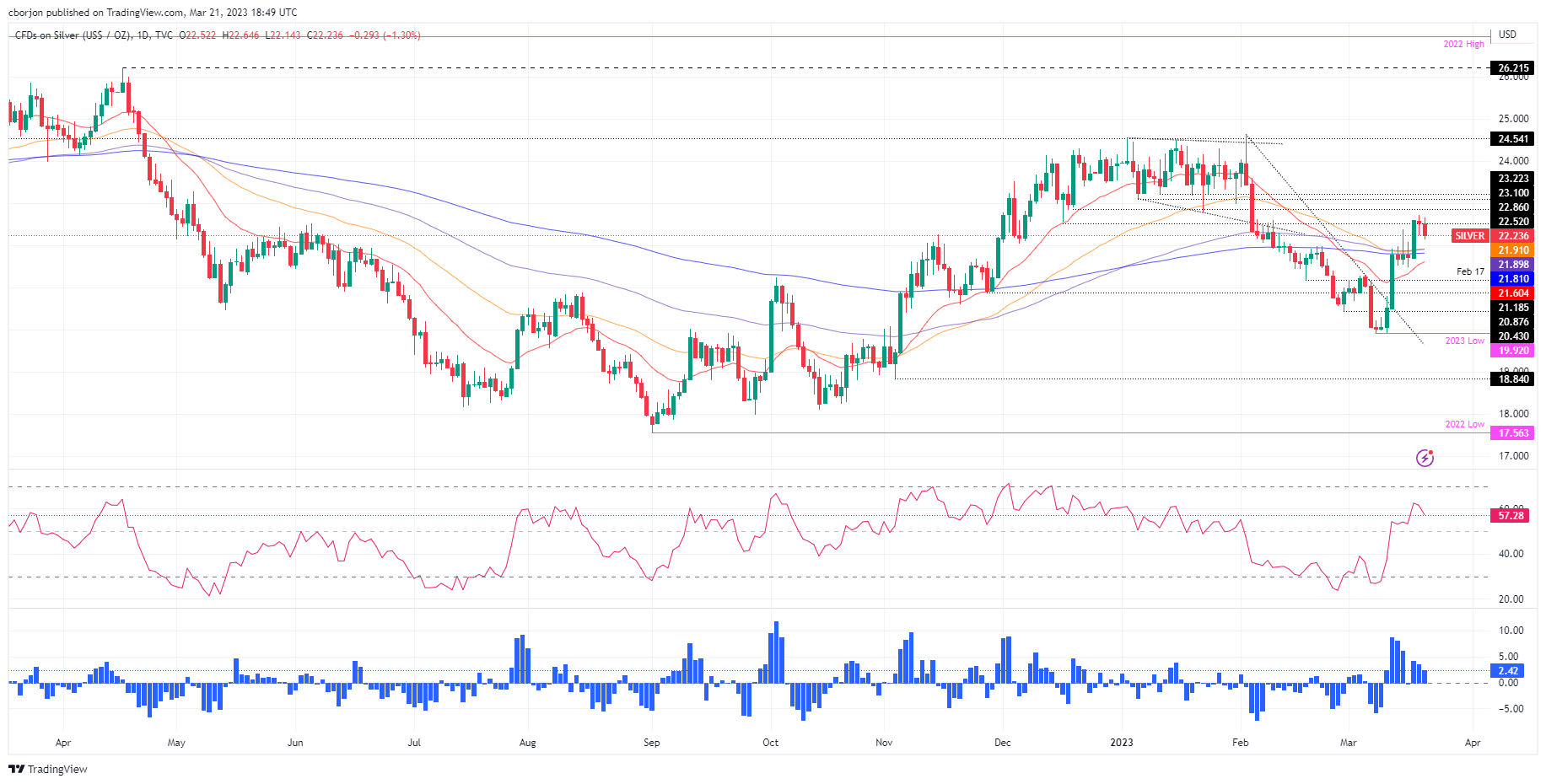
XAG/USD Technical levels
- GBP/USD bulls are in the market ahead of the central banks.
- Bulls are the front side of the bullish trend leaving the bias bullish near and longer term.
GBP/USD is grappling with the 1.22 area on Tuesday, keeping close to an almost seven-week high as traders reckoned banking stress could keep the Federal Reserve and the Bank of England from hiking rates much further.
The pair is on the front side of the bullish trend as we head into the central bank meetings this week and a multi-timeframe analysis determines a bullish bias for both the near-term and longer term as follows:
GBP/USD H1 chart

From an hourly perspective, the bulls are in control but the recent drop leaves prospects of some consolidation for the foreseeable sessions into the Federal Reserve event on Wednesday.
GBP/USD monthly chart
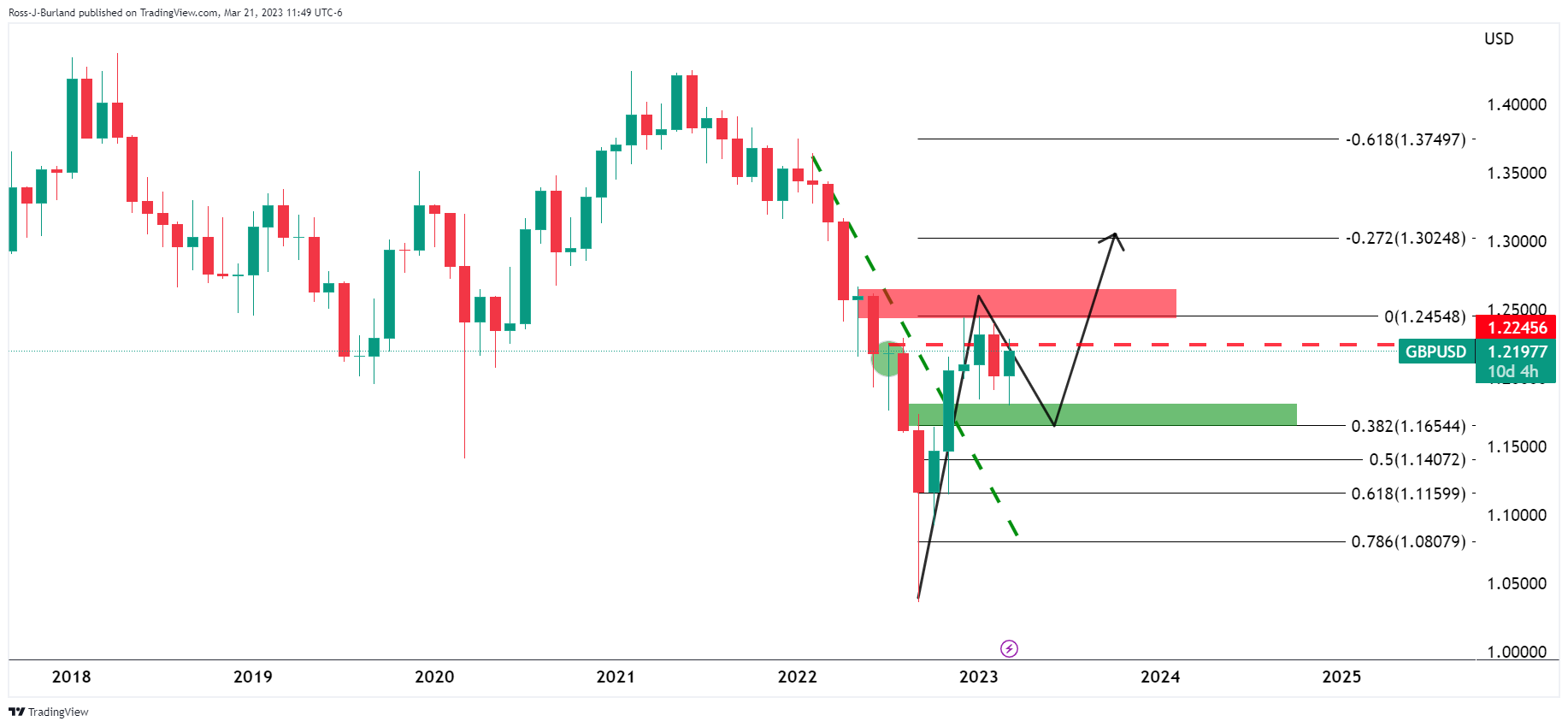
Zooming all the way out, the monthly chart shows that the market broke structure near 1.2245 but failed to hold above. The correction was relatively shallow so there are risks of a deeper move into the Fibonacci scale to at least test the 1.1650s and a 38.2% ratio. With that being said, there is just as much chance that the bulls will stay committed.
GBP/USD weekly charts
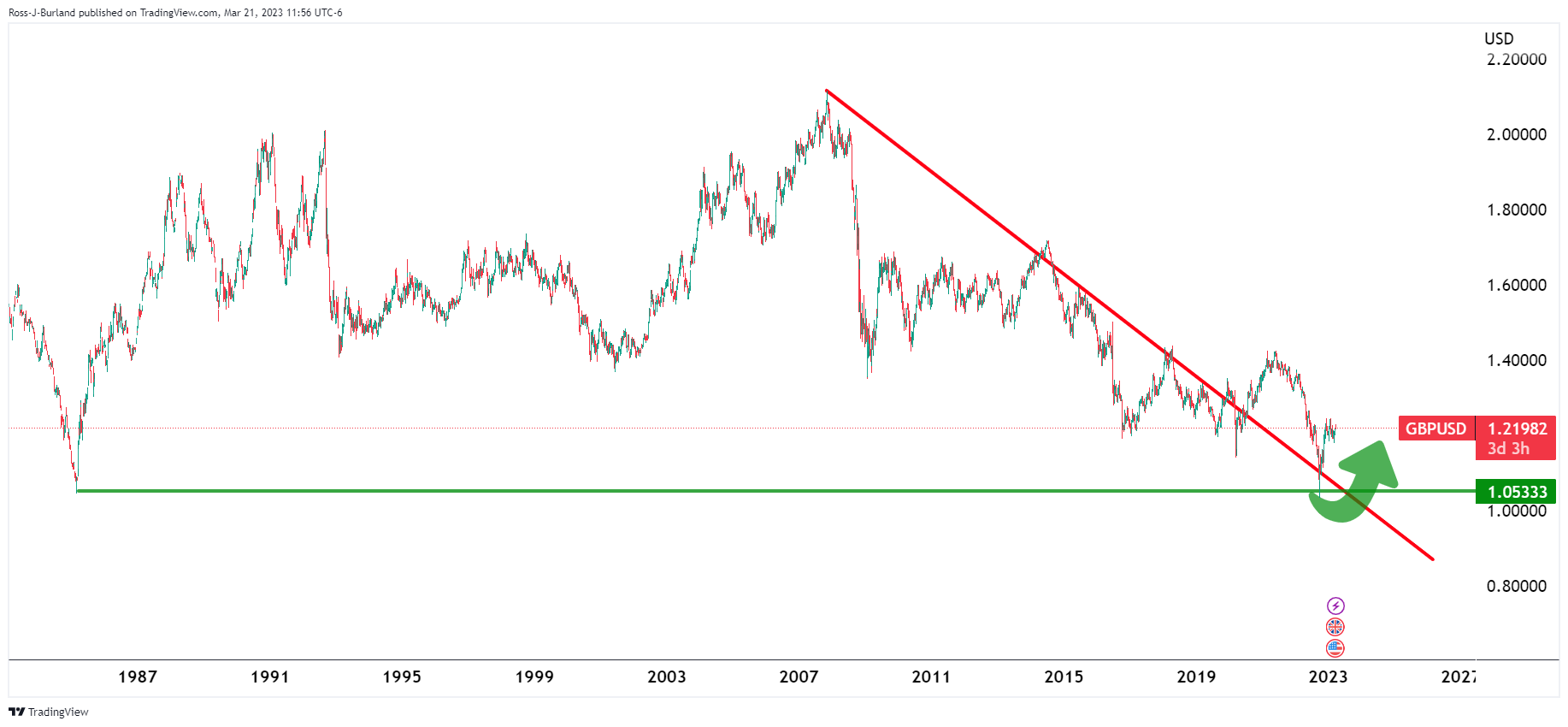
Afterall, on the weekly chart, the bear trend was broken and support has held so far.
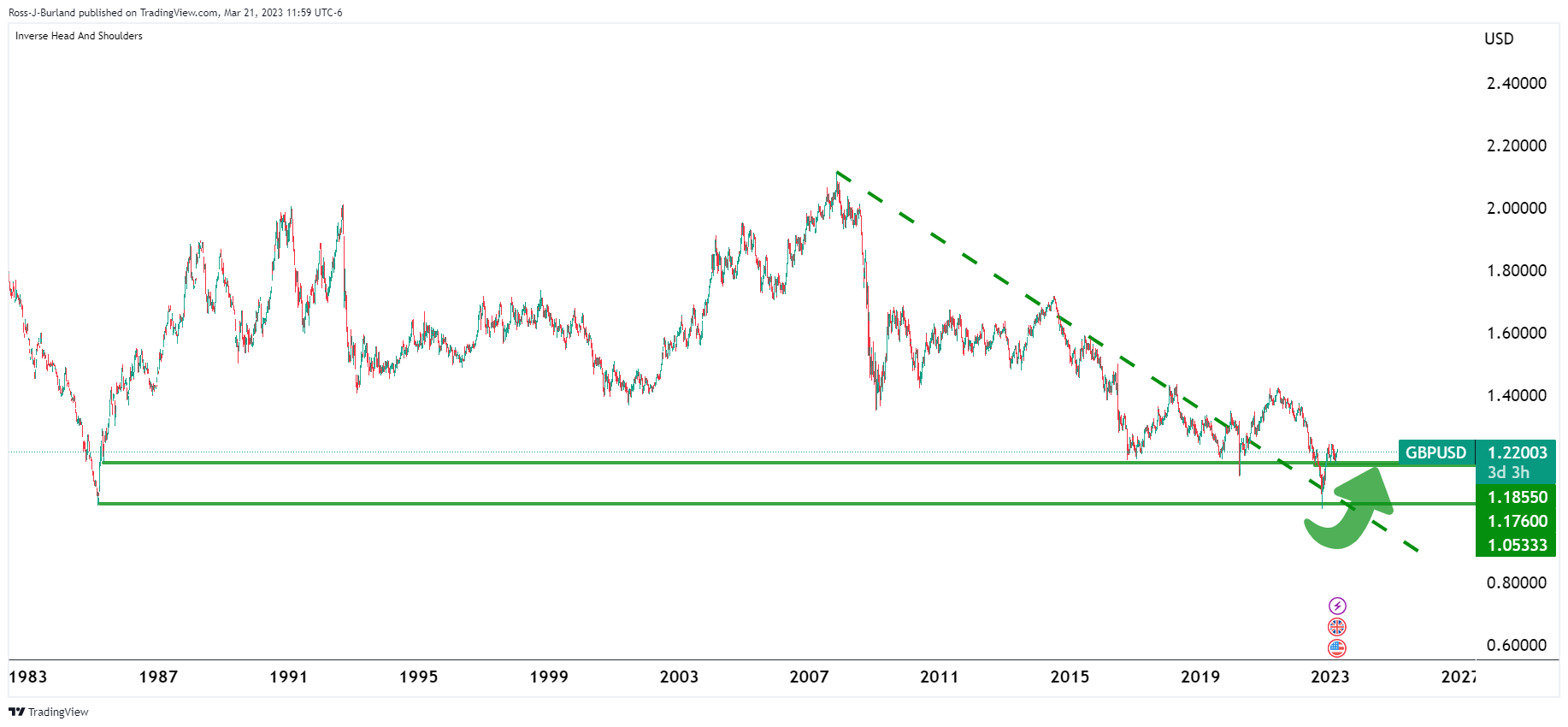
This leaves an upside bias for the weeks ahead.

The price is in a box and there are equal highs and lows on both sides with liquidity above and below. However, the bullish bias persists while the price is on the backside of the prior bearish trend and in a phase of accumulation.
GBP/USD daily chart

There are also inverse head and shoulders on both the daily and 4-hour charts.
GBP/USD H4 charts
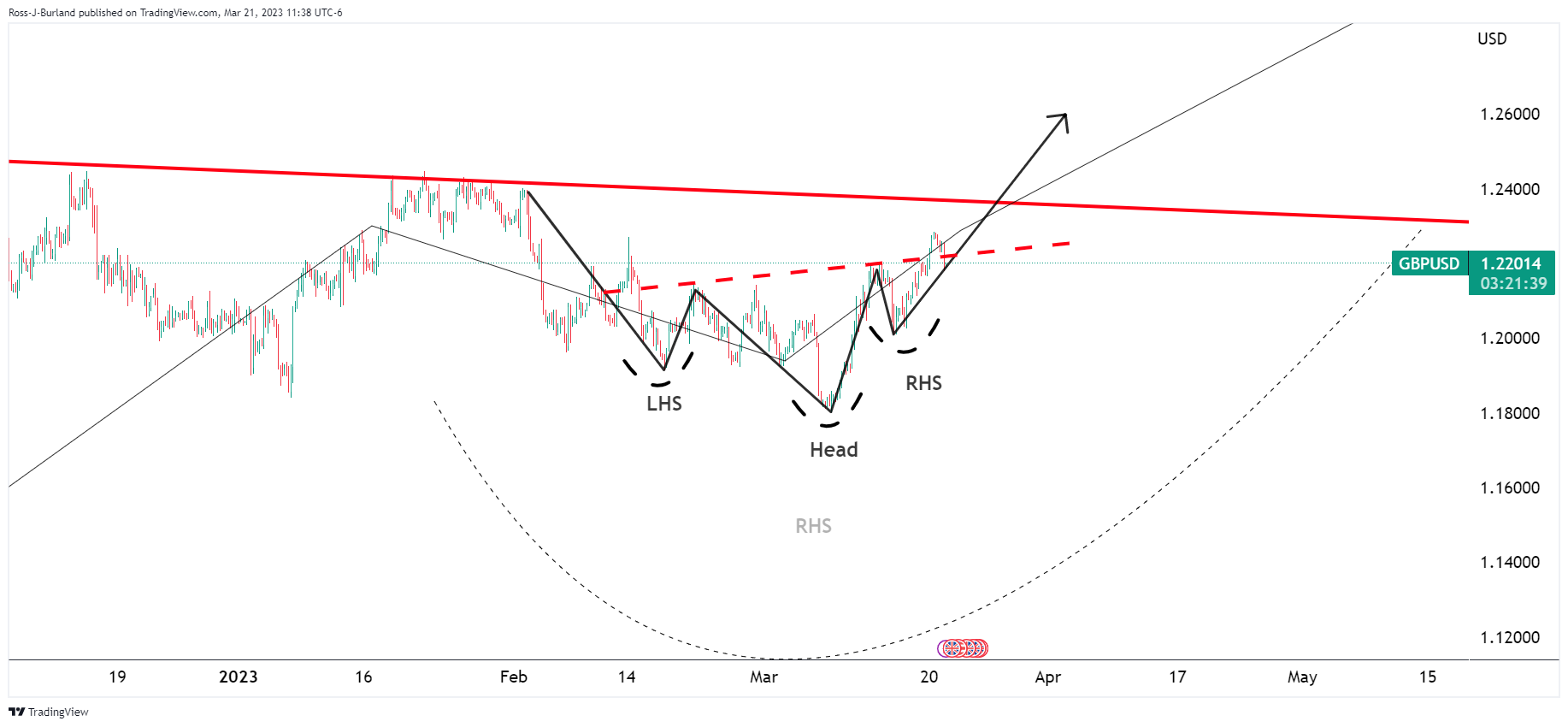
The 4-hour chart´s H&S´s neckline is already broken.
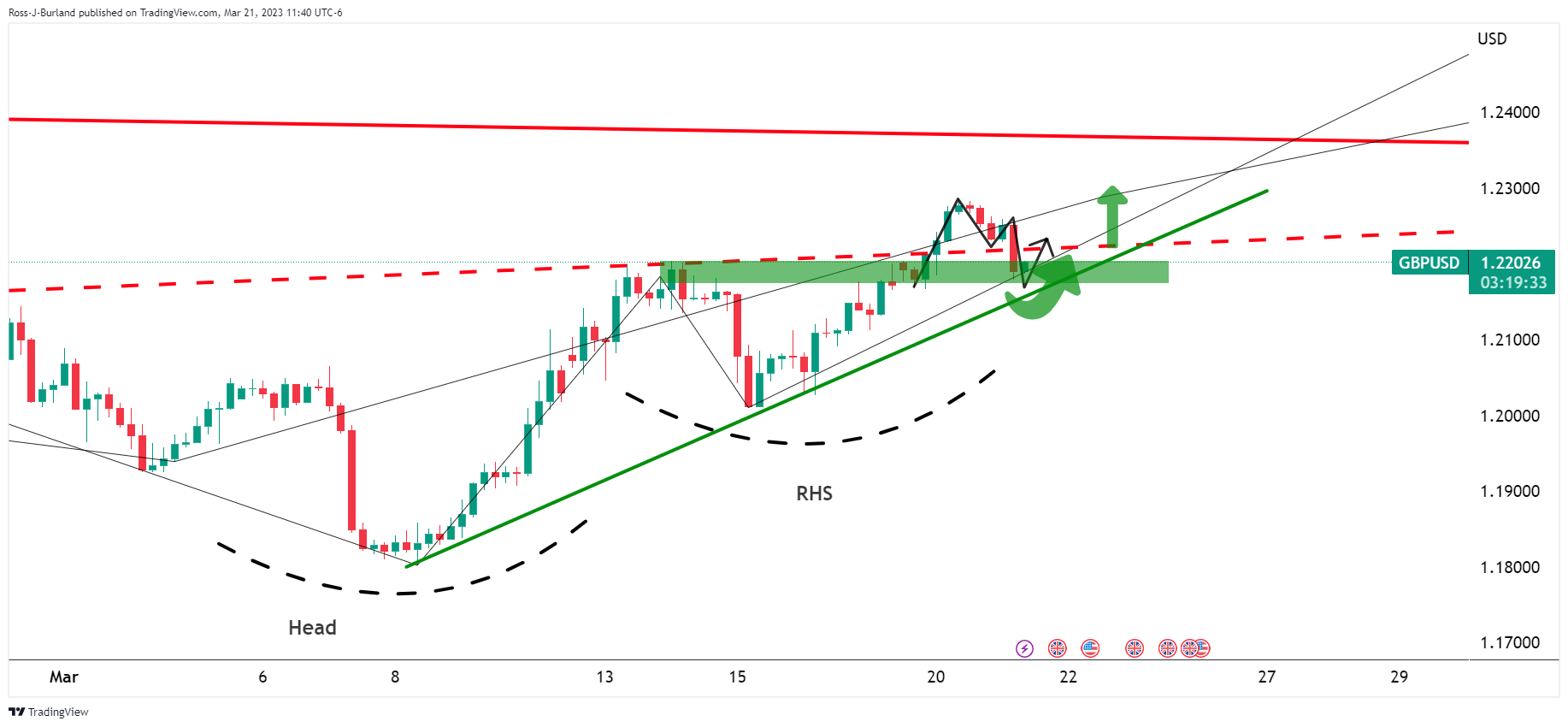
The M-formation is a reversion pattern and the price is being supported on the front side of the bullish trend.
- EUR/USD stays firm above 1.0750s ahead of the Federal Reserve’s March meeting.
- ECB policymakers have not expressed on monetary policy and stayed focused on banks.
- Traders are expecting a 25 bps rate hike by the Fed at its March meeting.
EUR/USD extends its rally to four consecutive days, spurred by an improvement in market sentiment after a two-week turbulence in the financial markets. Woes linked to the banking system crisis eased after UBS took over Credit Suisse, and US banks provided aid to First Republic Bank. At the time of writing, the EUR/USD is trading at 1.0774 after hitting a low of 1.0703.
EUR/USD advances amidst the lack of fresh catalyst, soft USD
Wall Street extends its recovery to two consecutive days, with the major stock indices gaining between 0.51% and 0.96%. Global authorities stepping in to reassure that the crisis would not blow up and trigger another financial crisis increased the appetite for risk-perceived assets. The US Dollar (USD), a safe-haven play, continues to drop, as shown by the US Dollar Index (DXY). The DXY is down 0.05%, at 103.253.
The EUR/USD continued to rally to a five-week high of 1.0788 but fell shy of testing the 1.0800 mark. European Central Bank (ECB) policymakers have been crossing newswires, mainly discussing the Eurozone’s (EU) banking system and liquidity conditions amidst a period of higher interest rates.
US data-wise, the economic docket revealed that Existing Home Sales exceeded estimates in February, due to falling mortgage rates, after dropping for 12 straight months, evidence that the housing market could be stabilizing.
Meanwhile, traders focus shifted to the FOMC’s monetary policy decision. The Fed has the challenge of providing stable prices and financial stability. Given that inflation stays at three times the Fed’s target, the Fed could take a page of the Bank of England’s (BoE) blueprint for handling financial stability.
Last year, the BoE had to step up and provide liquidity to calm the markets. Yet the BoE tightened monetary policy in November and hiked rates by 75 bps. Therefore, if the Federal Reserve follows that path and delivers a hawkish hike, the EUR/USD might reverse course and erase some of the last four days’ gains below 1.0700.
EUR/USD Technical analysis
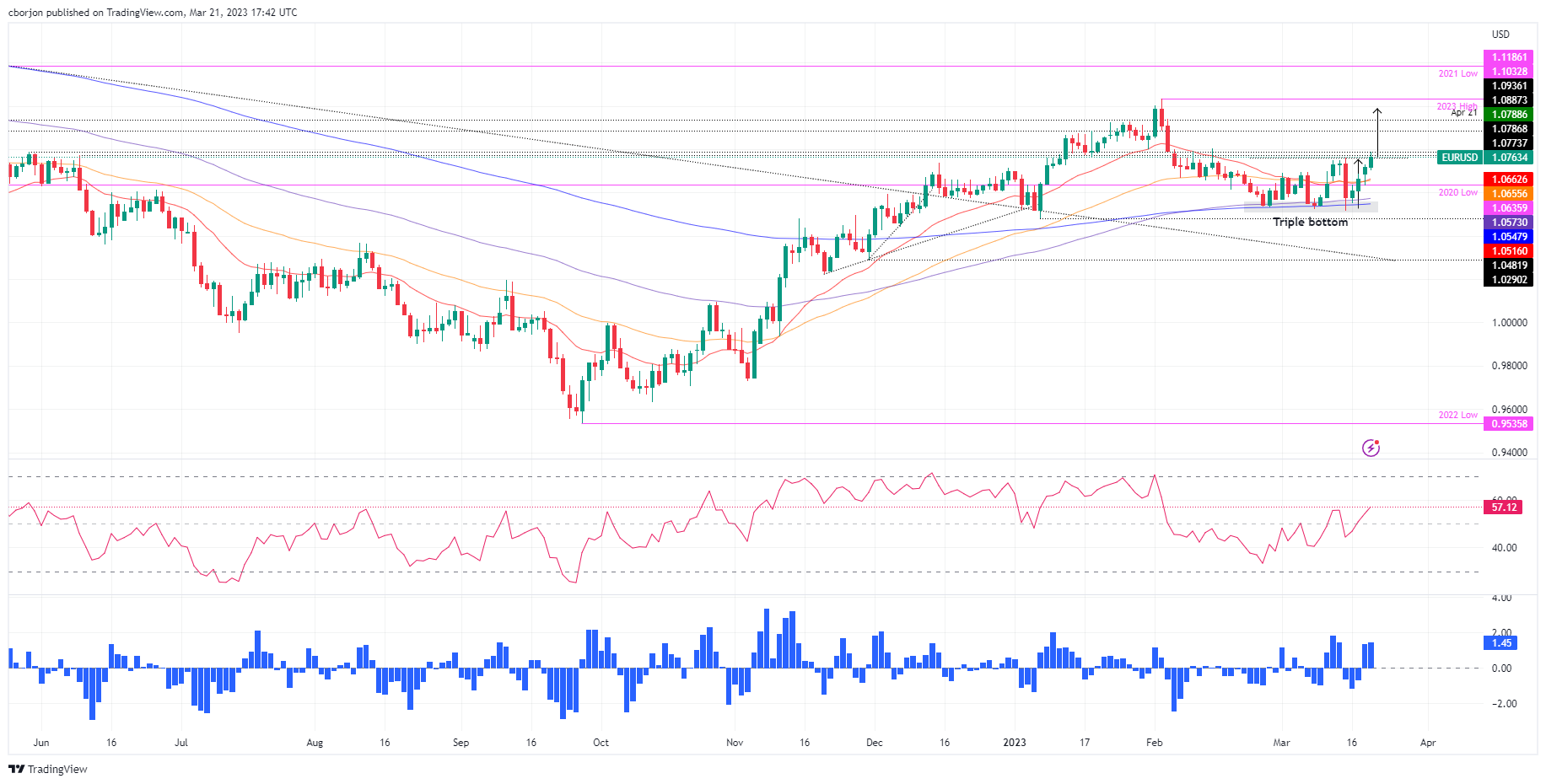
The EUR/USD formed a triple bottom at the daily chart. Since then, the shared currency (EUR) rallied above the March 15 high of 1.0759 and validated the pattern. Therefore, the EUR/USD initial target profit would be 1.1000, but the EUR/USD needs to hurdle some resistance levels on its way north.
The first resistance would be 1.0800, followed by the 1.0900 figure. Once cleared, the next stop would be the February 3 daily high at 1.0940, followed by the 1.1000 mark.
- US Dollar gains momentum as US yields rise ahead of FOMC decision.
- Canada: CPI rose 0.4% in February, core up 0.5%.
- USD/CAD support at 1.3650 remains in place.
The USD/CAD bottomed at 1.3643 following the release of Canadian inflation, the lowest since March 7 and then rebounded sharply amid a stronger US Dollar, approaching 1.3740.
The move to the upside occurred amid rising US yields that boosted the Greenback. The US 10-year yield approached 3.60% and the 2-year is back above 4.00%.
The Federal Reserve started on Tuesday it's two-day meeting. On Wednesday, the US central bank is expected to announce a 25 bps rate hike to 4.75% - 5.00%. Attention is set on how the Fed assess current development regarding the banking sector. Ahead of the decision, the US Dollar is posting mixed results.
Canada's inflation keeps slowing
Data released on Tuesday showed the Consumer Price Index dropped to the lowest level in 13 months from 5.9% to 5.2%, below the 5.4% of market consensus; the core rate fell from 5% to 4.7%. The Loonie rose marginally after the report.
Despite falling versus the US Dollar on Tuesday, CAD is up for the second day in a row versus AUD and NZD.
The USD/CAD peaked during the American session at 1.3736 and it is hovering around 1.3730. It rose almost a hundred pips from the daily low.
The pair was rejected from under the key support area of 1.3350. If the Loonie consolidates below, more losses seem likely. On the upside, USD/CAD is testing a downtrend line, and above 1.3740, the upside could extend further.
USD/CAD 4-daily chart
-638150150344193554.png)
- Gold price drops on risk-appetite improvement, and US Treasury bond yields rising.
- US Treasury bond yields rise, with 10-year TIPS, a proxy for real yields advancing above 1.30%.
- The Federal Reserve will commence its two-day monetary policy meeting, expected to deliver a 25 bps rate increase.
Gold price is tumbling across the board, down more than $30.00 or 1.59%, as US Treasury bond yields rise, while risk appetite improvement dented Gold’s demand. Hence, US equities climb moderately as the Federal Reserve’s Open Market Committee (FOMC) meeting begins soon. At the time of writing, XAU/USD is trading at $1947.26 after hitting a daily high of $1985.08
Gold price tumbles on high US Real Yields, and traders booking profits
Traders’ fears calmed in the last 48 hours after the UBS takeover of Credit Suisse, and US banks continued to try to stabilize First Republic Bank. The Federal Reserve (Fed) would begin its March monetary policy meeting, with traders expecting the Fed to raise rates by 25 bps as Powell and Co. continued their efforts to curb stubbornly high inflation.
The XAU/USD retreated most of its gains after reaching a YTD high on Monday at $2009.75. Since then, the yellow metal plunged 3.09%, as traders apparently booked profits ahead of the FOMC’s meeting.
Money market futures anticipate an 83.4% chance for a quarter percent increase in the Federal Funds Rate (FFR), according to CME FedWatch Tool. However, there is still uncertainty around the potential outcome of Fed Chair Jerome Powell’s press conference, which could cause instability in financial markets.
Another reason for XAU/USD’s fall is that US Treasury bond yields are climbing. The US 10-year Treasury bond yield is 3.58%, up nine bps. The 10-year Treasury Inflation-Protected Securities (TIPS), a proxy for US Real Yields, stands at 1.351% after tumbling as low as 1.142% on March 16.
In the meantime, the US Dollar Index, a gauge of the buck’s value against six peers, is trimming some of its earlier losses after hitting a low of 103.00, down 0.03%, at 103.274.
Gold technical analysis
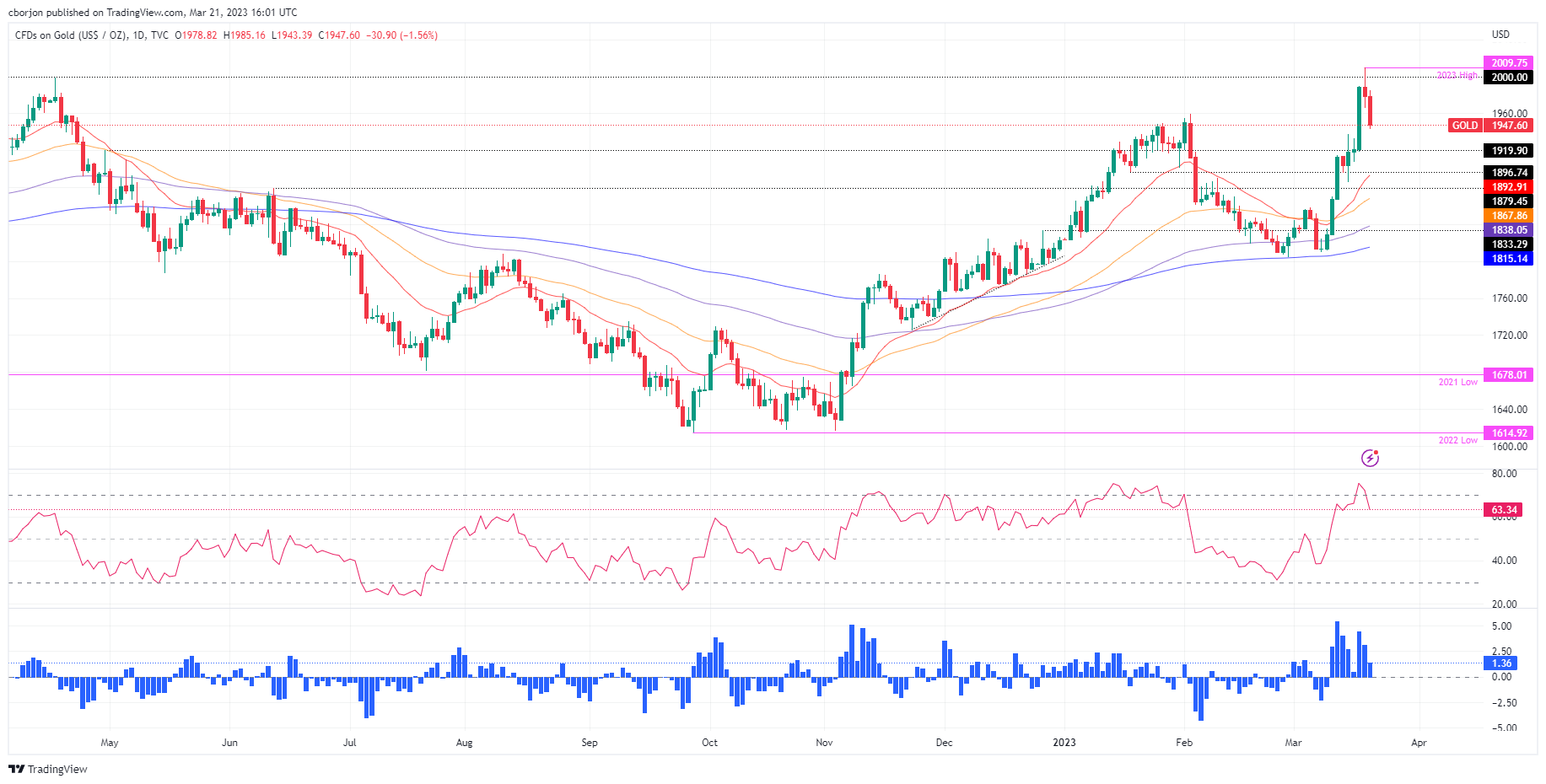
XAU/USD’s daily chart portrays a bullish bias in the yellow metal. However, price action in the last three days could form an evening star candlestick chart pattern. This means that Gold can drop in the near term. The first support would be the March 15 daily high turned support at $1937.31, followed by the $1900 barrier. Once cleared, the 20-day Exponential Moving Average (EMA) at $1892.89 is next, followed by the 50-day EMA at $1867.89.
What to watch?
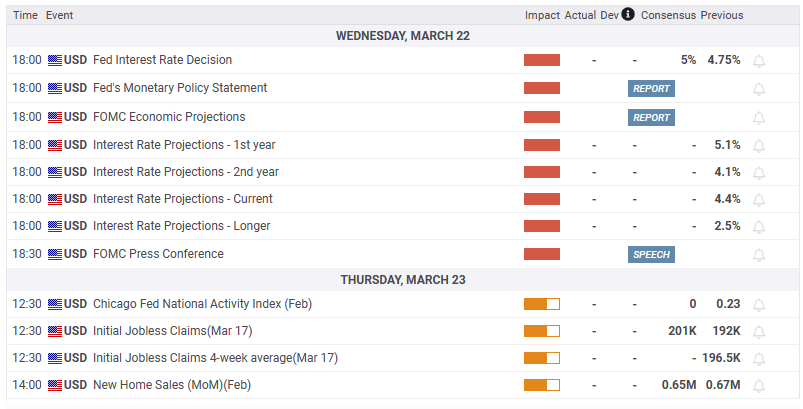
Gold briefly exceeds $2,000 again for the first time in a year. Market’s expectations with respect to the Fed’s monetary policy are set to drive the yellow metal price action, economists at Commerzbank report.
Gold to rise towards $2,000 again if Powell fails to dampen rate cut expectations
“The gold ETFs tracked by Bloomberg registered inflows of just shy of 22 tons last week. The majority of last week’s inflows were registered in the world’s largest and most liquid gold ETF in the US, which is the preferred choice of professional investors.”
“What statements the Fed makes in its communiqué tomorrow about its future monetary policy, and what Fed Chair Powell says in the subsequent press conference about the interest rate outlook, are likely to play a key role. If they manage to dampen rate cut expectations, Gold is likely to fall. Otherwise, another rise towards the $2,000 mark is on the cards.”
See – Fed: Banks Preview, no pause yet, going ahead with 25 bps hike
How risky are EM currencies? Economists at Commerzbank analyze which currencies are more vulnerable to a coming crisis of the financial system.
For currencies with high-interest rates, central banks have more room to cut rates
“It would be presumptuous to explain, for example, the negative performance of LatAm currencies with inherently higher risk. I rather think one has to state a very simple correlation: For currencies with high-interest rates, central banks have more room to cut rates. Thus, if you want to arm yourself against a coming crisis of the financial system, you have to get out of such currencies.”
“Among the biggest losers, tragically, are the currencies whose central banks have so far pursued a particularly sound monetary policy and have been particularly aggressive in raising their key interest rates in response to the global inflation shock.”
The US Federal Reserve will announce its monetary policy decision on Wednesday, March 22 at 18:00 GMT and as we get closer to the release time, here are the expectations as forecast by analysts and researchers of 15 major banks.
Markets expect the Fed to raise its policy rate by 25 basis points to the range of 4.75-5% but there are too many uncertainties surrounding Fed's policy outlook after the Silicon Valley Bank (SVB) crisis.
ANZ
“Inflation remains a major problem for the Fed. We favour a 25 bps increase. The FOMC will debate the suitable course of action given recent developments. A pick-up in volatility, and thus tighter financial conditions, going into the meeting could force a pause. We think the Fed will stress that future rate decisions will depend on both the data and the functioning of the financial system. We expect Powell to stress that the Fed will do whatever is required to preserve financial stability to raise 75 bps on way to 5.0%, pivot data dependent.”
Commerzbank
“We now assume that the Fed will raise key rates by 25 bps. Otherwise, the markets would probably already safely assume that the interest rate cycle is at an end and that it is only a matter of time before the Fed cuts again. Then the Fed would first have to convince market participants again that it will continue to raise rates after a pause in order to fight inflation. This poses the risk of additional volatility in the markets. As for the outlook going forward, the current turmoil shows that the tighter monetary policy is having an impact and is leading to negative consequences in parts of the economy. Accordingly, the Fed is likely to proceed more cautiously and raise interest rates in 25 bp steps to 5.50% (previously, we expected 6.00%). Moreover, we see our forecast confirmed that the US economy will slide into recession in the second half of the year, to which the Fed is likely to respond with the first interest rate cuts in early 2024.”
Swedbank
“We stick to our call that the Fed will hike by 25 bps both this week and at its May meeting. The Fed will however face a difficult balancing act between on the one hand being ready to support the financial sector, while also signal further tightening is on the cards to tame inflation.”
ING
“With the ECB hiking rates by 50 bps without causing too many market ructions, this is likely to embolden the Fed to move by 25 bps.”
Erste Group Research
“We expect the following: In addition to a 25 bps hike in policy rates, the new survey of FOMC members should see rates peaking at about the same level as in December. This corresponds to rate hikes of another 50 bps from current levels. If the rate peak is seen higher, we expect to see accompanying softening statements that emphasize the high level of uncertainty and highlight the possibility of pauses in the ongoing process of monetary tightening. Anything that indicates a more cautious approach by the FOMC should be received positively by the markets.”
Danske Bank
“We like our call of a 25 bps rate hike this week and a terminal rate at 5.00-5.25% in May. Hence, we see modest upside risks to short-term rates from current levels.”
TDS
“We expect a 25 bps rate hike taking the Fed funds target range to 4.75%-5.00%. We anticipate that post-meeting communication will: (i) stress that the Fed is not done yet in terms of further tightening of its policy stance, (ii) acknowledge the more uncertain economic environment, with a large emphasis on data dependence, and (iii) underscore a willingness to guarantee sufficiently liquid market conditions.”
BMO
“We are holding to our call that the Fed will lift rates 25 bps to 4.75%-to-5.00%, assuming no major new news breaks before the meeting. We are also maintaining the view that they will deliver one final hike in May, and then hold at that 5.00%-to-5.25% range through the second half of the year.”
CIBC
“Our base case is that the Fed opts for a quarter point hike, dialing down what would have been a 50 bps move in the absence of the past week’s banking events, but likely showing a follow up quarter point move in the ‘dots’.”
Standard Chartered
“On balance, a 25 bps policy rate hike is more likely than flat; a 50 bps roll of the dice is unlikely. We expect the Fed to hold to QT for now but possibly open a door to slowing or a pause.”
SocGen
“We expect a 25 bps hike, although that expectation is conditioned on a gradual restoring of calm since the seizure of the three banks. The economic evidence validates a hike. Fear among depositors might demand a pragmatic response, which might be to pause. Powell warned in 2022 that the inflation fight could be painful. The Fed’s resolve is now being tested. It’s time to follow-up on those words with action.”
NBF
“We’ll be looking for a 25 bps rate increase. More important than the decision itself will be updated FOMC guidance. Until last week, it was clear that March’s new ‘dot plot’ would signal higher policy rates for the coming years. That has now been thrown into question in light of recent financial events. Markets are expecting rate cuts in the second half of the year, though we don’t think policymakers will be willing to signal this yet.”
CitiBank
“We expect a 25 bps rate hike to take the Fed Funds rate to 4.75-5.0%. Chair Powell is likely to emphasize inflation can be addressed through policy rates, while financial stability can be addressed through other tools. No hike might be interpreted as the Fed being aware of more problems in the banking sector than the public. We also expect median dot for year-end 2023 to rise 25 bps from 5.00-5.25 to 5.25-5.5% and 2024 dot to rise 25 bps. Fed will also update its quarterly economic forecasts.”
Wells Fargo
“We forecast that the FOMC will raise its target range for the federal funds rate to 5.00%-5.25% by June from its current setting of 4.50%-4.75%. But as the pace of economic contraction that we forecast gathers pace in the fourth quarter of this year and as inflation recedes, then we look for the FOMC to begin an easing cycle that lasts until the third quarter of next year.”
BofA
“We expect the Fed to hike by 25 bps, but the decision and outlook for any tightening depend on financial stability. We retain our outlook for monetary policy, including a terminal target range of 5.25-5.5%, and a mild recession in the US beginning in Q3 of 2023. We now see a greater risk of Fed tightening and balance sheet reduction ending sooner; we saw risks that both would last longer previously. For USD, we expect some Dollar appreciation on the back of a 25 bps hike, but acknowledge that the range of USD outcomes is wide; it largely depends on the financial sector headlines.”
The British Pound remains the second-best performing G10 currency on a one-month view after the safe-haven Japanese Yen. Economists at Rabobank target the EUR/GBP pair at 0.88 on a three-month view.
0.90 target pushed further away
“Whilst the lineup of UK fundamentals is not great, it is better than the market had been expecting. In our view, this will push the EUR/GBP 0.90 target further away.”
“We have pared back our EUR/GBP forecasts and expected the pair at 0.88 on a three-month view.”
- The Mexican Peso appreciates against the US Dollar ahead of the FOMC’s meeting.
- An upbeat sentiment in the financial markets was one of the main reasons the USD/MXN fell.
- The US Treasury bond yield recovery began to reflect a 25 bps rate hike by the Fed.
- USD/MXN Price Analysis: Could resume downwards if it conquers 18.60; otherwise, upside risks remain.
The Mexican Peso (MXN) strengthens against the US Dollar (USD) courtesy of an upbeat sentiment amongst investors after Wall Street’s three major indices opened with gains. Therefore, the USD/MXN pair extended its losses below Monday’s low of 18.7857, though the 50-day EMA at 18.6820 capped the US Dollar losses. At the time of writing, the USD/MXN is trading at 18.7673, down 0.24%.
USD/MXN drops on risk-appetite, traders eyeing Fed’s decision
Sentiment remains upbeat. The financial markets narrative changed from inflation to a banking and credit crisis after the failure of two banks in the United States and another at the brisk of default. That has shifted global central banks’ interest rate increases expectations, with traders foreseeing that the Fed could cut rates in the year.
Money market futures expect the Fed to hike 25 bps, with odds at 83.4%, compared to Monday’s 73.8%. Nevertheless, uncertainty around how Fed Chair Jerome Powell’s press conference will go could rock the boat in the financial markets.
Societe Generale economists foresee a 25 bps rate hike
Delving a little deep into Jerome Powell’s press conference, Societe Generale analysts said, “the language around inflation and guidance on interest rates will take precedence over the next 48 hours. The Fed must err on the side of caution, and this means toning down the hawkish narrative until confidence in bank liquidity has been restored. SG economists forecast a +25bp hike, while the market is pricing in nearly 26% probability of a pause.”
Given the backdrop, the USD/MXN might consolidate around current exchange rates. The lack of economic data from Mexico would keep traders leaning into the dynamics of the US Dollar.
The US Dollar Index continues to edge lower, down 0.17%, at 103.132. US Treasury bond yields responded to expectations for a rate hike, with 2s and 10s up 16 and 9 bps each, at 4.148% and 3.579%, respectively.
Of late, Existing Home Sales in the United States in February rose 14.5% MoM, above estimates of 5%, the biggest increase since July 2020, and finished one full year of declines in sales.
USD/MXN Technical analysis
After failing to hold to gains above 19.0000, the USD/MXN resumed its downtrend, clearing the 100-day Exponential Moving Average (EMA) support at 18.9846. However, it should be said that the USD/MXN moved from trading within the low 18.00s to 18.10s towards the 18.60-18.90s area. Oscillators like the Relative Strength Index (RSI) and the Rate of Change (RoC) are still bullish, but RSI’s slope shifted downwards, suggesting that buying pressure is waning.
If the USD/MXN resumes upwards, the first resistance would be the 100-day EMA at 18.9848, followed by the $19.00. A breach of the latter will expose the weekly high at 19.2327. for a bearish resumption, the USD/MXN needs to crack $18.60, so sellers could have a chance to test the 20-day EMA at 18.5635 before diving toward $18.00.
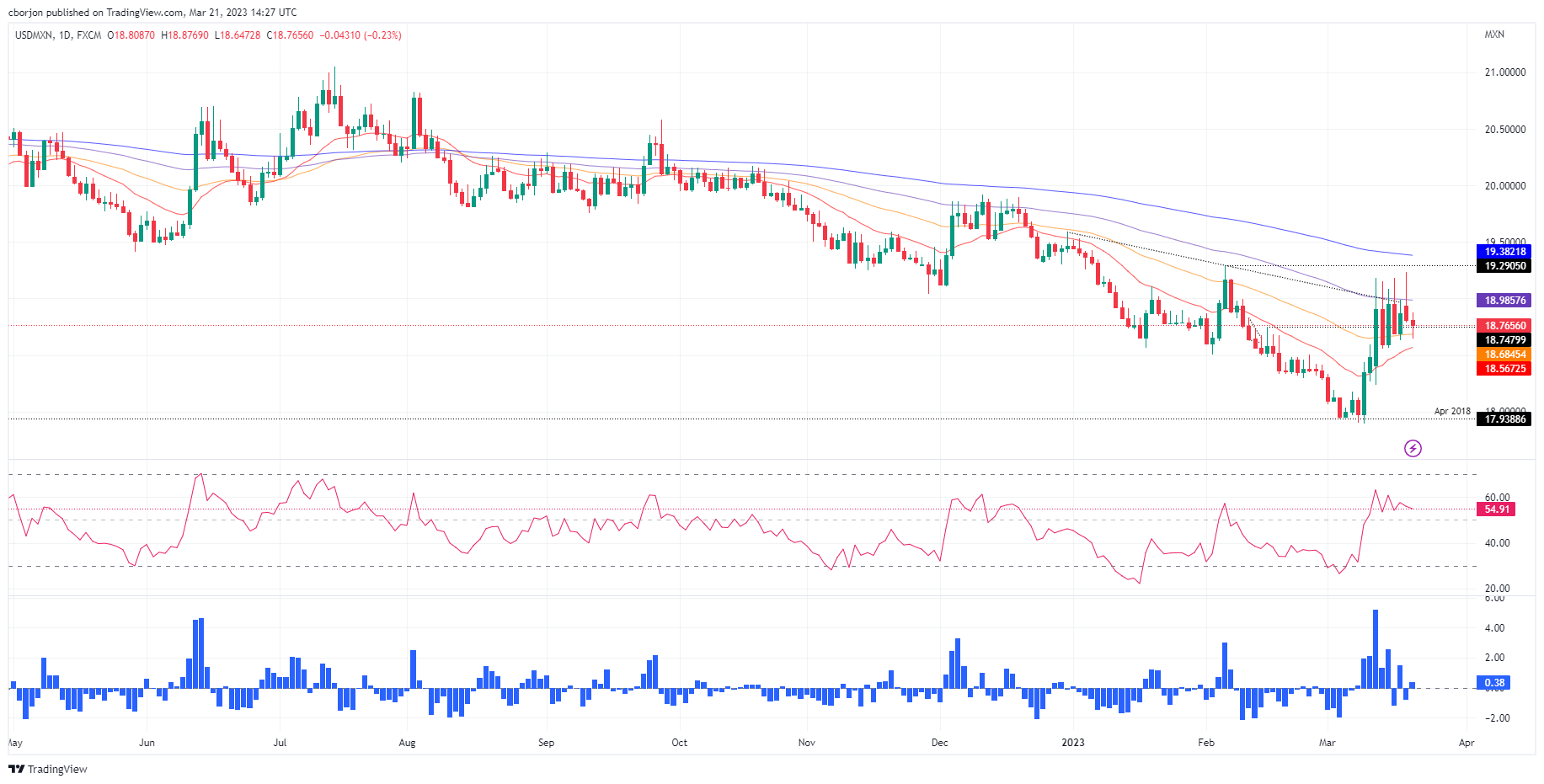
- Existing Home Sales in the US rose sharply in February.
- US Dollar Index recovers from daily lows after the data.
Existing Home Sales in the US rose by 14.5% in February to an adjusted annual rate of 4.58 million, the National Association of Realtors (NAR) reported on Tuesday. This reading followed January's contraction of 0.7% and came in much better than the market expectation of 0%.
"The median existing-home sales price decreased 0.2% from the previous year to $363,000," the NAR further noted.
Commenting on the data, "conscious of changing mortgage rates, home buyers are taking advantage of any rate declines," said NAR Chief Economist Lawrence Yun. "Moreover, we're seeing stronger sales gains in areas where home prices are decreasing and the local economies are adding jobs."
Market reaction
The US Dollar Index recovered modestly with the initial reaction to the upbeat data and was last seen losing 0.1% on the day at 103.20.
- EUR/USD advances further and approaches 1.0800.
- Immediately to the upside comes the weekly top at 1.0804.
EUR/USD climbs to 5-week tops in the 1.0785/90 band on Tuesday, extending the upside momentum for the fourth session in a row.
The continuation of the recovery could now see the weekly high at 1.0804 (February 14) revisited in the near term, while the surpass of this level should face the next obstacle not before the 2023 peak near 1.1030 (February 2).
Looking at the longer run, the constructive view remains unchanged while above the 200-day SMA, today at 1.0327.
EUR/USD daily chart

Nod by Fed Chair Powell to tighter financial conditions and downside growth risks could accelerate Dollar profit taking, economists at Société Générale report.
Dovish Fed hike could trip up the Dollar
“A smaller 25 bps rate increase by the Fed and minor revision to the dot plot poses downside risk for the Dollar this week.”
“A 50 bps increase would be a surprise but could backfire for the Dollar if the dot-plot shows no significant compared to December.”
“Even if the Fed raises rates, a nod by Fed Chair Powell to the downside growth risks could accelerate Dollar profit taking.”
- USD/JPY gains strong positive traction on Tuesday and recovers further from a multi-week low.
- The risk-on impulse undermines the JPY and lends support, though weaker USD caps the upside.
- The technical setup warrants some caution before placing directional bets ahead of the FOMC.
The USD/JPY pair once again shows some resilience below the 61.8% Fibonacci retracement level of the January-March rally and attracts fresh buying near the 131.00 round-figure mark on Tuesday. Spot prices recover further from the lowest level since February 10, around the 130.55-130.50 area touched on Monday, and climb back closer to mid-132.00s during the early North American session.
The risk-on impulse - as depicted by a further strong rally in the equity markets - undermines the safe-haven Japanese Yen (JPY) and acts as a headwind for the USD/JPY pair. Bulls further take cues from the widening of the US-Japan rate differential, led by a solid recovery in the US Treasury bond yields over the past two sessions. That said, the prevalent US Dollar selling might cap any meaningful gains for the major.
The aforementioned mixed fundamental backdrop warrants caution before confirming that the USD/JPY pair's recent rejection slide from a technically significant 200-day Simple Moving Average (SMA) has run its course. Traders might also refrain from placing aggressive bets and prefer to move to the sidelines ahead of the highly-anticipated two-day FOMC monetary policy meeting, starting this Tuesday.
From a technical perspective, the intraday positive move stalls near 50% Fibo. level. This is closely followed by the overnight swing high, around the 132.65 region, which should now act as a pivotal point. Some follow-through buying could trigger a short-covering rally and push the USD/JPY pair further beyond the 133.00 round figure, towards testing the 38.2% Fibo. level, around the 133.80-133.85 region.
Heading into the key central bank event risk, the latter should keep a lid on any further upside for the USD/JPY pair. That said, a sustained move beyond the said barrier will negate any near-term negative outlook and shift the near-term bias in favour of bullish traders. This, in turn, will set the stage for a further appreciating move towards the 135.00 psychological mark, which coincides with the 100-day SMA.
On the flip side, 61.8% Fibo. level, around the 131.35 region, now seems to protect the immediate downside ahead of the 131.00 mark and the overnight swing low, around the mid-130.00s. Failure to defend the said support levels will make the USD/JPY pair vulnerable to challenging the 130.00 psychological mark. Spot prices could eventually drop to the 129.55-129.50 intermediate support en route to the 129.00 round figure.
USD/JPY daily chart

Key levels to watch
Economist at UOB Group Lee Sue Ann suggests the Fed is likely to raise the Fed Funds Target Range by 25 bps at both its March and May gatherings.
Key Quotes
“The latest FOMC minutes strongly suggest that we are not quite near the end of the current tightening cycle, despite the improving inflation trajectory.”
“While the Fed retained its pledge that ‘ongoing increases’ remaining appropriate; the minutes also showed that the view of downshifting to 25bps hike is the majority of the FOMC policy makers, we continue to expect the Fed to hike for the next two meetings in clips of 25-bps hikes at the Mar and May 2023 FOMC meetings, bringing our terminal FFTR level to 5.25%.”
Gold crossed 2,000 on safe-haven buying amid the ongoing US banking crisis. The sharp fall in US Treasury yields has been supportive of the yellow metal, strategists at ANZ bank report.
Central banks’ purchases remain resilient
“Changing market expectations around the fed funds rate continue to drive Gold prices amid the US banking crisis. The sharp fall in US Treasury yields has been supportive of Gold.”
“Inflation expectations over the next 12 months have retreated to 4%, but the Fed’s determination to tame inflation remains a key short-term risk.”
“Speculative positions have fallen, but ETF holdings are seeing net inflows.”
“Central banks continue to add more Gold to their reserves to hedge against geopolitical and economic risks.”
- DXY remains well on the defensive and threatens 103.00.
- Further losses could see the weekly low at 102.58 revisited.
DXY adds to the ongoing decline and puts the 103.00 region to the test on Tuesday.
The bearish mood appears unabated for the time being. Against that, there is a minor support at the weekly low at 102.58 (February 14), while the loss of this region could spark a deeper pullback to the 2023 low near 101.80 (February 2).
Looking at the broader picture, while below the 200-day SMA, today at 106.62, the outlook for the index is expected to remain negative.
DXY daily chart
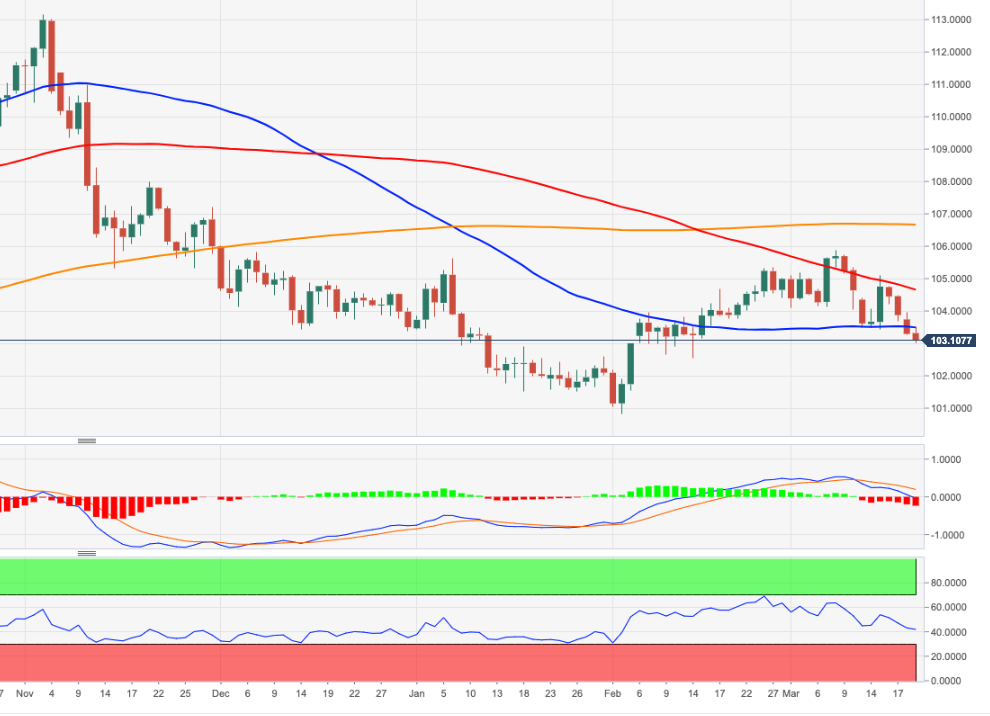
Senior Economist at UOB Group Alvin Liew reviews the latest performance of the non-oil domestic exports (NODX) in Singapore.
Key Takeaways
“Singapore’s non-oil domestic exports (NODX) continued to fall, albeit less sharply by -15.6% y/y in Feb (from -25.0% y/y in Jan), the fifth straight month of contraction after 22 months of unabated expansion. On a seasonally adjusted sequential basis, NODX fell sharply by -8.0% m/m in Feb (compared to +0.9% m/m gain in Jan), the deepest m/m fall since Sep 2020 (-9.2%). The nominal value of NODX fell further to S$13.0bn (S$13.3bn seasonally adjusted) in Feb, the lowest since Jun 2019.”
“Jan exports to major destinations continued to reflect the weak global demand backdrop, but there were some positive developments as 1) there were three markets (US, Japan and Thailand) reporting positive y/y outcomes in Feb versus two in Jan, 2) NODX to US returning to growth, at 8.7% (from -31.5% in Jan) and 3) while demand weakness persisted in China the magnitude of decline is much more moderate at -11.3% y/y (from -41.1% y/y in Jan), and similar moderation in demand weakness was seen in most of ASEAN (such as NODX to Malaysia which contracted -10.5% y/y vs. -23.5% y/y in Jan and NODX to Indonesia which declined by -2.0% y/y vs. -17.5% in Jan).”
“NODX Outlook – The broad-based weakness in both electronics and nonelectronics performance continues to weigh negatively on NODX momentum and manufacturing demand for Singapore. The improvement (in the form of less negative prints on NODX declines from major export destinations of China and the ASEAN region) is encouraging but we caution against prematurely calling this to be the start of an uptrend. We continue to expect weakness in global demand on the back of further monetary policy tightening and worries about economic slowdown in the developed markets. It should also be noted that high base effect will continue to work against the NODX in early 2023, as seen in the months of Jan and Feb. We keep our view that we are likely to see a few more months of y/y declines in NODX for 1H 2023 before factoring some improvement in the second half of the year. We still expect full year NODX to contract by 5.5% in 2023.”
- GBP/USD comes under some selling pressure on Tuesday and snaps a three-day winning streak.
- The downside remains limited amid sustained USD selling and ahead of the FOMC/BoE meetings.
- The technical setup still favours bulls and supports prospects for the emergence of dip-buying.
The GBP/USD pair stalls a three-day-old uptrend on Tuesday and retreats from its highest level since early February touched the previous day. The pair maintains its offered tone through the early North American session and is currently placed just below the mid-1.2200s, though lacks follow-through.
The pullback could be attributed to some repositioning trade ahead of this week's key central bank event risks - the crucial FOMC policy decision on Wednesday, followed by the Bank of England (BoE) meeting on Thursday. In the meantime, the prospects for a less hawkish Federal Reserve (Fed), along with a strong follow-through rally in the equity markets, drag the safe-haven US Dollar (USD) to a fresh five-week low and lends support to the GBP/USD pair.
From a technical perspective, the overnight breakout through the 1.2200 mark, or the 61.8% Fibonacci retracement level of the January-March downfall was seen as a fresh trigger for bulls. Moreover, oscillators on the daily chart are holding in positive territory and are still far from being in the overbought zone. This suggests that the path of least resistance for the GBP/USD pair is to the upside and supports prospects for the emergence of some dip-buying at lower levels.
That said, it will still be prudent to wait for some follow-through buying beyond the monthly top, around the 1.2285 region set on Monday, before positioning for any further gains. The GBP/USD pair might then climb to test the next relevant hurdle near the 1.2320 region before eventually aiming to reclaim the 1.2400 round-figure mark. The momentum could get extended further towards the double-top resistance near the 1.2450 region, or the YTD peak touched in January.
On the flip side, 61.8% Fibo. level, around the 1.2200 mark, now seems to protect the immediate downside. Sustained weakness below might prompt some technical selling and drag the GBP/USD pair towards the 1.2125 confluence support. The latter comprises 50% Fibo. level and the 200-day Exponential Moving Average (SMA), which if broken decisively might shift the near-term bias back in favour of bearish traders and pave the way for deeper losses.
GBP/USD daily chart
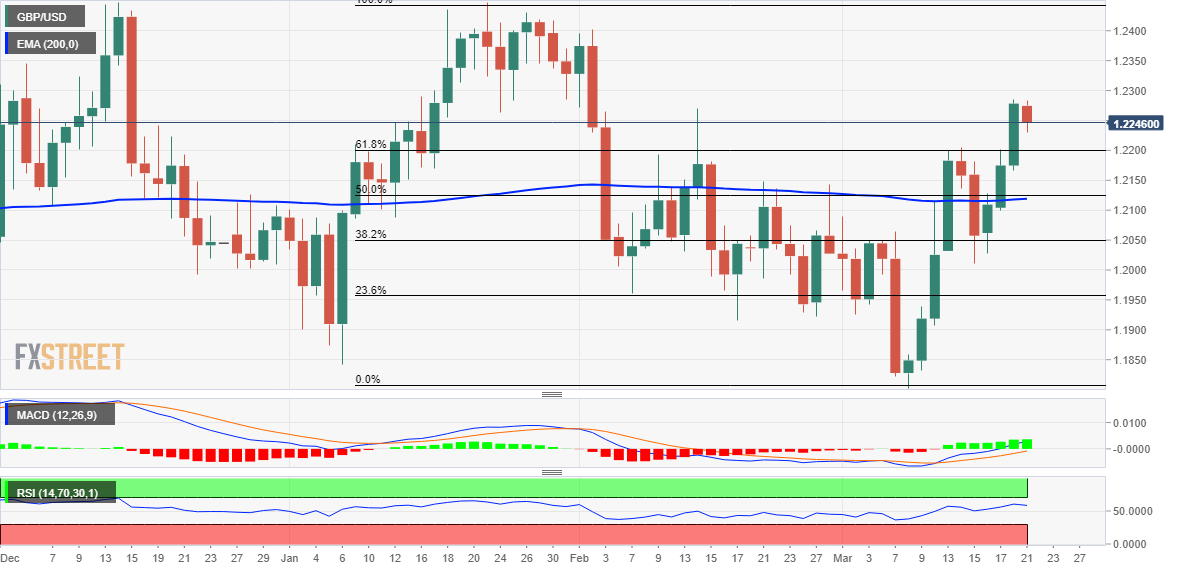
Key levels to watch
The ball for EUR/USD moves to the court of the Fed this week. Economists at Société Générale analyze how the FOMC meeting could impact the world’s most popular currency pair.
A smaller 25 bps rate increase or a pause by the FOMC to help EUR/USD
“A smaller 25 bps rate increase or a pause by the FOMC on Wednesday and minor (upward) revision of the dot-plot should, in theory, help EUR/USD to return to the upward trajectory of January.”
“A 50 bps increase by the Fed and/or significant upward revision of the dots would be a major surprise and would backfire for risk assets and smother the bullish EUR/USD argument.”
The collapse of Silicon Valley Bank has created turmoil in the US banking system, prompting comparisons with the global financial crisis. Economists at UBS do not see the current bank failures and government action as a precursor to a systemic crisis
US banking system is better capitalized than prior to the 2008 global financial crisis
“While we are monitoring unfolding events, we do not see the current bank failures and government action as a precursor to a systemic crisis.”
“The US banking system is better capitalized than prior to the 2008 global financial crisis: The industry’s Tier 1 risk-based capital ratio stood at 10.11% at the end of 2007 compared with 13.65% at the end of 2022.”
“Silicon Valley Bank was in some ways unique. It had a high exposure to VC startups experiencing cash burn, leaving it vulnerable to deposit outflows. It had the highest ratio of securities to total assets in the industry and so was virtually the only US bank that had close to negative equity if mark-to-market losses were included.”
“Where US regulators let Lehman Brothers fail in 2008, they have stepped in proactively this time to make depositors whole.”
Economist Ho Woei Chen at UOB Group comments on the latest interest rate decisions by the PBoC.
Key Takeaways
“From 27 Mar, banks’ reserve requirement ratio (RRR) will be lowered by 25 bps to bring the effective RRR to 7.6%.”
“The 25 bps cut to the RRR is estimated to release CNY500 bn of long-term liquidity into the system. This is in addition to net injections of CNY559 bn via the 1Y medium-term lending facility (MLF) since the start of the year.”
“Banks have issued a record CNY6.71 tn of new loans in the first two months of the year (vs. CNY5.21 tn in the same period of 2022) and there may be concerns that the pace of credit expansion could ease sharply in the later part of the year.”
“The 1Y and 5Y loan prime rates (LPR) were unchanged at 3.65% and 4.30% respectively in Mar for the 7th straight month.”
“We now see the 1Y MLF rate to remain steady at 2.75% and consequently the 1Y LPR at 3.65%, for the rest of 2023. More important to watch will be the 5Y LPR as a reduction to the rate will signal stronger government support to the real estate sector. However, another RRR reduction later this year cannot be ruled out.”
- Annual inflation in Canada declined more than expected in February.
- USD/CAD trades with marginal daily gains above 1.3650.
Annual inflation in Canada, as measured by the Consumer Price Index (CPI), declined to 5.2% in February from 5.9% in January, Statistics Canada reported on Tuesday. This reading came in below the market expectation of 5.4%. On a monthly basis, CPI rose 0.4% in February, compared to analysts' estimate of 0.6%.
Additionally, the Bank of Canada's Core CPI, which excludes volatile food and energy prices, dropped to 4.7% on a yearly basis from 5% in January.
Market reaction
USD/CAD edged higher with the initial reaction and was last seen rising 0.05% on the day at 1.3672.
- EUR/JPY extends the upside momentum sparked on Monday.
- Next on the upside comes the YTD peak near 145.60.
EUR/JPY adds to the uptick seen at the beginning of the week and trades closer to the 143.00 region on Tuesday, an area coincident with the 100-day SMA.
The rebound appears strong and the continuation of this price action should target the 2023 high at 145.56 (March 2) ahead of a potential visit to the December 2022 peak at 146.72 (December 15).
In the meantime, extra losses remain on the cards while the cross trades below the 200-day SMA, today at 141.78.
EUR/JPY daily chart
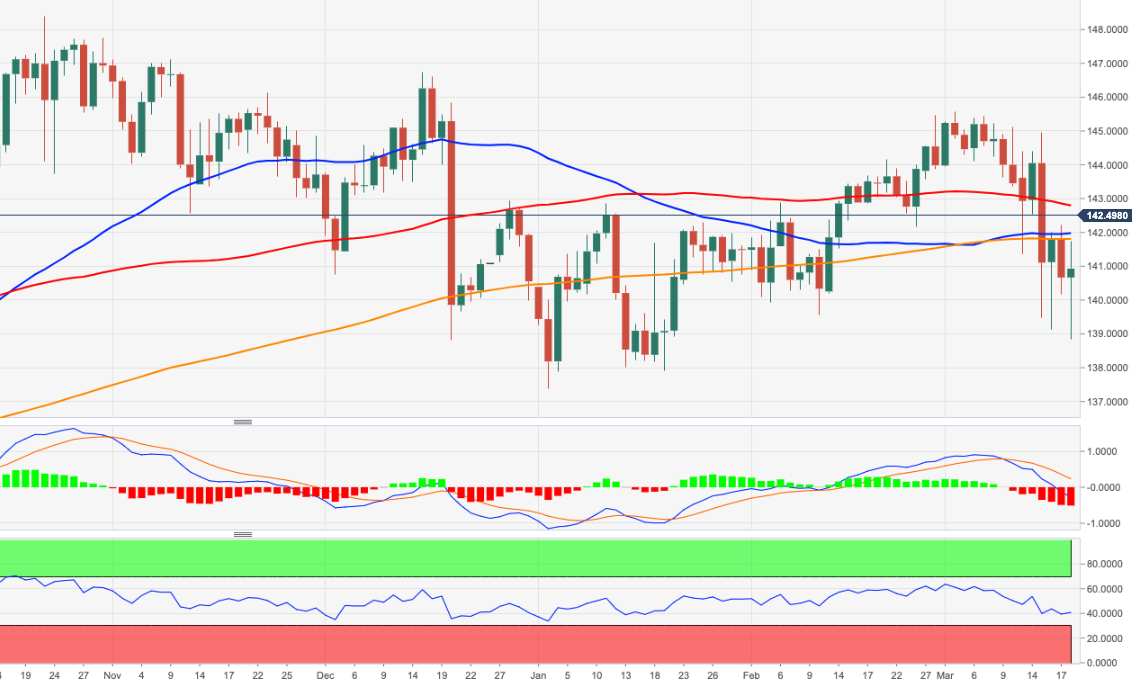
EUR/CHF has rebounded after retesting last November's low of 0.9710/0.9670. The pair must surpass the 1.0010/40 resistance zone to enjoy further gains, analysts at Société Générale report.
Break of 0.9710/0.9670 to result in an extended decline
“Daily MACD posted negative divergence and has dipped below equilibrium line denoting lack of steady upward momentum.”
“The pair is now challenging the 50-DMA; multi month trend line at 1.0010/1.0040 remains a crucial resistance zone. Failure to cross this would mean persistence in consolidation.”
“Break of recent trough near 0.9710/0.9670 is likely to result in an extended decline.”
Canada CPI Overview
Statistics Canada will release the consumer inflation figures for February later during the early North American session on Wednesday, at 12:30 GMT. The headline CPI is expected to have risen by 0.6% during the reported month as compared to the 0.5% increase in January. The yearly rate, however, is expected to decelerate further from 5.9% to 5.4% in February. More importantly, the Bank of Canada's (BoC) Core CPI, which excludes volatile food and energy prices, is estimated to climb by 0.8% in February and ease to 4.6% on a yearly basis as compared to 0.3% MoM and 5% YoY, respectively, in January.
Analysts at NBF offer a brief preview of the key macro data and explain: “A slight decline in gasoline prices, combined with a drop in the natural gas segment, should have benefited consumers during the month. The increase in food costs, meanwhile, could have moderated following January’s surge. Headline inflation could nonetheless have increased 0.5% MoM (0.2% after seasonal adjustment) on gains in several services categories. If we’re right, the 12-month rate could still drop six ticks to 5.3% on account of a strongly negative base effect. The annual rate of core measures should have moderated as well, with CPI-trim likely easing from 5.1% to 4.9% and CPI-median moving from 5.0% to 4.8%.”
How Could it Affect USD/CAD?
Given that the Bank of Canada (BoC) became the first major central bank to pause its rate-hiking cycle earlier this month, a softer domestic CPI print could weigh on the Canadian Dollar and assist the USD/CAD pair to regain positive traction. The upside, however, is likely to remain capped amid the prevalent US Dollar selling bias, led by expectations that the Federal Reserve will soften its hawkish stance.
Adding to this, a further recovery in Crude Oil prices from a fresh 15-month low touched on Monday is more likely to offset any disappointment from the Canadian consumer inflation figures. This, in turn, suggests that the path of least resistance for the USD/CAD pair is to the downside. Bearish traders, however, might refrain from placing aggressive bets ahead of the highly-anticipated FOMC meeting, starting this Tuesday.
Key Notes
• Canadian CPI Preview: Forecasts from five major banks, inflation growth to decelerate
• USD/CAD Forecast: 38.2% Fibo. level holds the key for bulls ahead of Canadian CPI
• USD/CAD: Canadian inflation may have a very limited impact on the Loonie – ING
About Canadian CPI
The Consumer Price Index (CPI) released by Statistics Canada is a measure of price movements by the comparison between the retail prices of a representative shopping basket of goods and services. The purchasing power of CAD is dragged down by inflation. The Bank of Canada aims at an inflation range (1%-3%). Generally speaking, a high reading is seen as anticipatory of a rate hike and is positive (or bullish) for the CAD.
GBP/USD is now probing recent pivot high at 1.2270/1.2300. A move beyond here would open up the December peak near 1.2450 and perhaps projections of 1.2610, analysts at Société Générale report.
Defending last week low of 1.2010 crucial for continuation in up move
“Daily MACD has entered positive territory denoting regain of upward momentum.”
“If the pair crosses above 1.2270/1.2300, the bounce could persist towards December peak near 1.2450 and perhaps even towards projections of 1.2610.”
“Defending last week low of 1.2010 would be crucial for continuation in up move.”
Lee Sue Ann, Economist at UOB Group, assesses the latest GDP figures in New Zealand.
Key Takeaways
“GDP came in much weaker than expected, contracting by 0.6% q/q in 4Q22, in contrast to the revised 1.7% q/q gain in 3Q22, and lower than expectations for a print of -0.2% q/q. The latest GDP outcome was also sharply weaker than the Reserve Bank of New Zealand (RBNZ)’s Feb MPC projection of +0.7% q/q.”
“The impacts of severe weather and flooding earlier this year will cloud the economic outlook. Our view is that the economy is likely to experience further weakness ahead. We have lowered our GDP growth forecast for 2023 to 1.3%, from 1.5% previously.”
“We now think the RBNZ will have to dial back on further rate hikes, especially in light of the looming policy-induced recession and surging migration domestically, as well as on the back of current global financial stability concerns. The next RBNZ meeting is on 5 Apr, where we are penciling in a 25bps hike in the OCR to 5.00%, after which we expect a pause in the current tightening cycle.”
The US Dollar Index (DXY) has moved below the 103.25/35 region. A sustained break under this zone would signal more losses ahead, economists at Scotiabank report.
Seasonal patterns turn more USD-negative through Q2
“Seasonal patterns turn more USD-negative through Q2.”
“The DXY charts show the index is on the cusp of a bearish break under retracement/moving average support (in the 103.25/35 range); a sustained break below this zone would signal more weakness ahead.”
See: FOMC meeting will be a rollercoaster for the Dollar – Commerzbank
EUR/USD has so far defended the 100-Day Moving Average and low of January near 1.0520/1.0480 resulting in an initial bounce. Economists at Société Générale note that reclaiming 1.0800 would negate Head and Shoulders pattern.
Break below 1.0520/1.0480 to trigger an extended down move
“It is worth noting that the pair is evolving within a possible Head and Shoulders; the pattern towards downside should a breakdown below neckline materialize. Recent pivot high near 1.0800 is a short-term resistance, this must be reclaimed to negate the formation.”
“If the pair breaks the neckline at 1.0520/1.0480, an extended down move is not ruled out. Next objectives would be at 1.0330 and September 2022 peak of 1.0220/1.0200.”
GBP/USD edges modestly lower but the undertone remains positive, economists at Scotiabank report.
Price action looks consolidative ahead of another push higher
“Cable has drifted a little from yesterday’s late session high of 1.2285 but losses have been relatively limited and price action looks consolidative ahead of another push higher.”
Spot gains through the 55-Day Moving Average (1.2139) and developing bullish trend momentum on the intraday and daily studies suggest scope for more GBP gains towards the 1.25 area in the short run on a break above 1.23.”
“Support on dips to the mid/upper 1.21 area should be firm.”
- USD/CHF comes under some renewed selling pressure on Tuesday amid sustained USD selling.
- Bets for a less hawkish Fed offset a further recovery in the US bond yields and weigh on the USD.
- The risk-on environment could undermine the safe-haven CHF and lend some support to the pair.
- Investors might also prefer to move to the sidelines ahead of the crucial central bank event risks.
The USD/CHF pair attracts fresh sellers following an early uptick to the 0.9315 area on Tuesday and extends the sharp intraday downfall through the first half of the European session. The pair drops to the 0.9250-0.9245 area in the last hour and reverses a major part of the previous day's positive move.
The Swiss Franc (CHF) draws support from the latest optimism led by the news that UBS will rescue Credit Suisse in a $3.24 billion deal, which helps ease fears of widespread contagion risk. This, along with sustained US Dollar selling for the fourth successive day amid expectations that the Federal Reserve (Fed) will soften its hawkish stance, is seen exerting downward pressure on the USD/CHF pair.
In fact, the markets have been pricing in a smaller 25 bps rate hike in March and the possibility that the US central bank might even start cutting rates during the second half of the year. This, to a larger extent, offsets a further recovery in the US Treasury bond yields and drags the USD Index, which tracks the Greenback against a basket of currencies, to its lowest level since February 14 in the last hour.
It, however, remains to be seen if bears can maintain their dominant position amid a generally positive tone around the equity markets, which tends to undermine the safe-haven CHF. Traders might also refrain from placing aggressive directional bets and prefer to wait for the outcome of the highly-anticipated two-day FOMC monetary policy meeting, scheduled to be announced during the US session on Wednesday.
The key focus, however, will remain on the accompanying policy statement and updated economic projections. This, along with Fed Chair Jerome Powell's comments at the post-meeting press conference, will be closely scrutinized for clues about the future rate-hike path. This, in turn, will influence the USD and provide a fresh impetus to the USD/CHF pair ahead of the Swiss National Bank (SNB) meeting on Thursday.
Technical levels to watch
The Federal Reserve's new Bank Term Funding facility and discount window lending are working to provide liquidity to the banking system, US Treasury Secretary Janet Yellen will tell at the American Bankers Association conference on Tuesday. Yellen will further note that aggregate deposit outflows from regional banks have stabilized following these measures.
Additional takeaways via Reuters
"US actions on banking stability show resolute commitment to ensure depositors' savings, banking system are safe."
"Treasury, Fed, FDIC actions reduced risk of further bank failures that would have imposed losses on deposit insurance fund."
"Similar actions to protect depositors could be warranted if smaller institutions suffer deposit runs that pose risk of contagion."
"Steps to protect SVB, signature depositors were aimed at protecting the US banking system, not specific banks or classes of banks."
"A dynamic and diverse banking system - with large, mid-sized and small banks - is critical to the US economy."
Market reaction
The US Dollar Index stays on the back foot following these comments and was last seen losing 0.2% on the day at 103.10.
USD/CAD achieved projections near 1.3860 earlier this month and has embarked on an initial pullback. A break under 1.3500/1.3420 would mean onset of a deeper downtrend, analysts at Société Générale report.
Overcoming recent peak near 1.3860 would affirm extension in up
“Break below a short-term channel highlights possibility of a down move towards 1.3630 and the 50-DMA at 1.3500/1.3420 which is also the ascending trend line drawn since June last year. This is an important support; only a break below would mean onset of a deeper downtrend.”
“Overcoming recent peak near 1.3860 would affirm extension in up move towards last year high of 1.3980/1.4040.”
Barring clearly positive developments in the banking sphere, economists at ING suspect the approaching Fed announcement could favour some defensive Dollar positions today.
FOMC risk event draws closer
“What is undoubtful is that tomorrow’s rate announcement will be a big risk event, and markets are only pricing in a 60% chance of a hike.”
“From an FX perspective, we wouldn’t be surprised to see the Dollar – which fell yesterday as risk sentiment rebounded – find some support into the FOMC announcement as markets turn more defensive and potentially factor in a greater risk of a hawkish scenario.”
The FOMC meeting tomorrow will be a rollercoaster for the Dollar, rather weighing on it, in the opinion of Antje Praefcke, FX Analyst at Commerzbank.
If the Fed is determined to continue with its measures against inflation that would be positive for the USD
“If the Fed is similarly determined as the ECB to continue with its measures against inflation that would be positive for the Dollar, as the market would have to adjust its key rate expectations to the upside.”
“To my recollection, the expectations before a Fed rate meeting have never been so far apart, from 0 to 25 to 50 bps. Nobody really knows what we will get tomorrow, it is a bit like taking a pick from a chocolate box. Perhaps at this stage, not even the central bankers themselves know at this stage, who, if they had a wish, would probably wish not to have a meeting this week.
“I fear that Powell will have to run the gauntlet at the press conference tomorrow and that the FOMC meeting will be a rollercoaster for the Dollar, rather than weighing on it.”
- AUD/USD retreats from a nearly two-week high in reaction to the dovish RBA meeting minutes.
- A further recovery in the US bond yields lends support to the USD and contributes to the slide.
- Bets for a less hawkish Fed cap the upside for the Greenback amid a generally positive risk tone.
The AUD/USD pair comes under heavy selling pressure on Tuesday and snaps a three-day winning streak to a nearly two-week high, around the 0.6730 area touched the previous day. The pair maintains its offered tone through the first half of the European session and is currently placed around the 0.6675-0.6670 region, down nearly 0.70% for the day.
The Australian Dollar weakens a bit in reaction to the release of the dovish-sounding Reserve Bank of Australia (RBA) meeting minutes, which indicated that a pause in the rate-hiking cycle may be on the cards next month. The Australian central bank, however, warned that it will continue to do whatever is necessary to bring inflation back into line, though did little to impress bulls or lend any support to the AUD/USD pair. This, along with a modest US Dollar bounce from a five-week low touched on Monday, further contributes to the offered tone surrounding the major.
A further recovery in the US Treasury bond yields - bolstered by easing fears of a widespread contagion risk - turns out to be a key factor lending some support to the USD. That said, firming expectations for a less aggressive policy tightening by the Federal Reserve (Fed) could cap any meaningful upside for the US bond yields. Apart from this, a generally positive risk tone, supported by the news that UBS will rescue Credit Suisse in a $3.24 billion deal, keeps a lid on the safe-haven Greenback and might help limit deeper losses for the risk-sensitive Aussie, at least for the time being.
Traders might also refrain from placing aggressive bets and prefer to move to the sidelines ahead of the highly-anticipated two-day FOMC meeting, starting this Tuesday. The Fed will announce its decision on Wednesday and is widely expected to deliver a smaller 25 bps rate hike. Market participants also expect that the US central bank might even cut rates during the second half of the year. Hence, investors will look for fresh clues about the Fed's future rate-hike path, which will influence the near-term USD price dynamics and determine the near-term trajectory for the AUD/USD pair.
Heading into the key central bank event risk, traders on Tuesday might take cues from the release of the US Existing Home Sales data, due later during the early North American session. This, along with the US bond yields, will drive the USD demand and provide some impetus to the AUD/USD pair. Apart from this, the broader risk sentiment could further contribute to producing short-term opportunities.
Technical levels to watch
After hitting $2,031 for the first time in nearly a year, Gold has slid below $2,000. Neverthless, a rout is not expected, economists at TD Securities report.
There is support near $1,953
“While the yellow metal is expected to trend lower, a rout is not expected as the US central bank will be very measured in its signaling and rates are unlikely to go up much from current levels.”
“For now, there is support near $1,953.”
“Before any move above $2,000 becomes sustainable, there will need to be evidence that rates will drop and that the US central bank will allow inflation to stay above a target for a while, but much closer to 2 percent.”
- Germany’s ZEW Economic Sentiment deteriorated in March.
- EUR/USD bulls remain unperturbed by the downbeat ZEW surveys, near 1.0750.
The German ZEW headline number showed that the Economic Sentiment Index worsened in March, arriving at 13.0 from 28.1 in January, missing the market expectation of 16.4.
Meanwhile, the Current Situation Index came in at -46.5 from -45.1, worse than the market expectation of -45.8.
During the same period, the Eurozone ZEW Economic Sentiment Index slumped to 10.0 from 29.7, compared to the estimates of 23.2.
Key points
The international financial markets are under strong pressure.
This high level of uncertainty is also reflected in the ZEW indicator of economic sentiment.
The assessment of the earnings development of banks has deteriorated considerably, although it still remains slightly positive.
Estimates for the insurance industry have also declined significantly.
Market reaction
The EUR/USD pair has ignored the downbeat data, keeping its range near 1.0750, up 0.22% on the day.
- USD/JPY regains strong positive traction on Tuesday and draws support from a combination of factors.
- A positive risk tone undermines the safe-haven JPY and acts as a tailwind amid a modest USD strength.
- Bets for a less hawkish Fed warrant caution for USD bulls and might cap any further gains for the pair.
The USD/JPY pair builds on the previous day's recovery from the vicinity of mid-130.00s, or its lowest level since February 10 and gains strong follow-through traction on Tuesday. The positive momentum remains uninterrupted through the first half of the European session and lifts spot prices to a fresh daily high, around the 132.25-132.30 region in the last hour.
A generally positive risk tone undermines demand for the safe-haven Japanese Yen (JPY) and turns out to be a key factor acting as a tailwind for the USD/JPY pair. The news that UBS will rescue Credit Suisse in a $3.24 billion deal helps ease fears of widespread contagion risk and boosts investors' confidence. This is evident from a further recovery in the equity markets, which, along with a modest US Dollar bounce from a five-week low touched on Monday, remains supportive of the intraday move up.
The USD draws some support from a further recovery in the US Treasury bond yields, though expectations that the Federal Reserve (Fed) will adopt a less hawkish stance keeps a lid on any meaningful upside. In fact, the current market pricing indicates a greater chance of a 25 bps Fed rate hike on Wednesday. Investors also expect that the US central bank might even cut rates during the second half of the year and the speculations were fueled by the recent collapse of two mid-size US banks.
Hence, the market focus will remain glued to the outcome of the highly-anticipated two-day FOMC monetary policy meeting, starting this Tuesday. Investors will closely scrutinize the accompanying statement and Fed Chair Jerome Powell's comments at the post-meeting press conference for clues about the future rate-hike path. This, in turn, will play a key role in influencing the USD price dynamics in the near term and help investors to determine the next leg of a directional move for the USD/JPY pair.
In the meantime, traders on Tuesday will take cues from the release of the US Existing Home Sales data, due later during the early North American session. This, along with the US bond yields, will drive the USD demand and provide some impetus to the USD/JPY pair. Apart from this, the broader risk sentiment could further contribute to producing short-term opportunities.
Technical levels to watch
Inflation data for February will be published in Canada today. But the CPI report is unlikely to impact significantly the Loonie, economists at ING report.
Inflation a secondary factor
“Today’s inflation may have a very limited impact on CAD given the BoC's recent stance.”
“CAD should continue to lag other pro-cyclicals on any rebound in risk sentiment unless there is a clear stabilisation in market sentiment on the US banking sector.”
“At the same time, the BoC's dovishness is likely lowering the medium-term attractiveness of CAD: we continue to expect a drop below 1.30 in USD/CAD by the second half of this year, but that should primarily be a consequence of USD weakness rather than idiosyncratic CAD strength.”
See – Canadian CPI Preview: Forecasts from five major banks, inflation growth to decelerate
Economist at UOB Group Lee Sue Ann reviews the latest jobs report in Australia.
Key Takeaways
“Australia’s seasonally adjusted unemployment rate fell to 3.5% in Feb, hovering around a 50-year low, from 3.7% in Jan, and against expectations of 3.6%. Seasonally adjusted employment increased by 64,600 people, from a revised fall of 10,900 people (11.500 fall previously). Full-time employment increased by 74,900, while part-time employment fell by 10,300.”
“The latest jobs data underscores the economy’s resilience, with labour market strength a key factor in the Reserve Bank of Australia (RBA)’s confidence that the economy can avoid a recession despite the aggressive monetary tightening cycle. The RBA expects unemployment to hold around 3.5%-3.6% through mid2023.”
“We are keeping our view of one more 25bps hike in Apr, which will take the OCR to 3.85%. Any changes to our forecasts will depend on incoming economic data. Financial stability concerns will also be a crucial factor given the current problems in the banking sectors in the US and Europe.”
- EUR/USD adds to the recent breakout of 1.0700.
- Germany, EMU Economic Sentiment due next in the docket.
- The Fed is widely expected to hike rates by 25 bps on Wednesday.
The better tone in the dollar does not prevent EUR/USD from climbing further, this time hitting new multi-session highs around 1.0740 on Tuesday.
EUR/USD looks bid ahead of data, FOMC
EUR/USD trades with gains for the fourth session in a row and pushes higher following the recent breakout of the key 1.0700 barrier.
The daily improvement in the pair comes despite the tepid rebound in the greenback and seems to follow the persevering hawkish narrative from some ECB-speakers, who appear to favour a 25 bps rate raise at the May event.
Further support for the European currency comes in response to another daily uptick in the German 10-year Bund yields, this time regaining the 2.20% barrier and beyond, a move that echoes the ongoing bounce in their US peers.
An interesting docket in the euro area will see the Economic Sentiment tracked by the ZEW institute in both Germany and the broader Euroland ahead of another speech by Chairwoman Lagarde.
Across the pond, Existing Home Sales and the start of the 2-day FOMC gathering will take centre stage.
What to look for around EUR
EUR/USD keeps the bid bias well in place and climbs to fresh tops well north of 1.0700 the figure, extending at the same time the auspicious start of the new trading week on Tuesday.
In the meantime, price action around the European currency should continue to closely follow dollar dynamics, as well as the potential next moves from the ECB in a context still dominated by elevated inflation, although amidst dwindling recession risks for the time being.
Key events in the euro area this week: EMU, Germany ZEW Economic Sentiment, ECB Lagarde (Tuesday) - ECB Lagarde (Wednesday) – EMU Flash Consumer Confidence, European Council Meeting (Thursday) - European Council Meeting, EMU, Germany Flash PMIs (Friday).
Eminent issues on the back boiler: Continuation, or not, of the ECB hiking cycle. Impact of the Russia-Ukraine war on the growth prospects and inflation outlook in the region. Risks of inflation becoming entrenched.
EUR/USD levels to watch
So far, the pair is gaining 0.18% at 1.0736 and the break above 1.0759 (monthly high March 15) would target 1.0804 (weekly high February 14) en route to 1.1032 (2023 high February 2). On the flip side, there is initial support at 1.0516 (monthly low March 15) seconded by 1.0481 (2023 low January 6) and finally 1.0327 (200-day SMA).
The Kiwi is lower. But analysts at ANZ Bank are not reading too much into it given how volatile markets have been of late.
Lots of balls in the air
“Fears about the instability of the US banking system continue to linger, and may for some time, denting the USD. One also wonders whether a Fed hike will be cheered (better carry) or booed (destabilising) by USD pundits this week.”
“Lots of balls in the air, but NZ does seem more remote from the world’s troubles, and that may allow the RBNZ to just keep hiking.”
“Support 0.5750/0.5900/0.6090 – Resistance 0.6540/0.6675.”
- Gold price peaked on Monday right above $2,000 before bulls took some profit.
- Silver is following the same trend, still far from its all-time highs.
- Precious metals have benefitted from the international banking crisis.
Precious metals are continuing the retracement initiated on Monday as the financial markets try to settle down from the huge stress seen over the last few days. Gold price (XAU/USD) has pulled back to trading below $1,970 at the time of writing, from a peak above $2,000 early on Monday. Silver price action (XAG/USD) has been a bit quieter, with a relative monthly high below $23 achieved on Monday and a 1% retracement since.
UBS agreement to buy Credit Suisse and coordinated central bank action to inject liquidity into the system are the actions that have somewhat relieved the extreme risk-off mood seen since the collapse of Sillicon Valley Bank.
Gold price rally can keep going on any Federal Reserve dovish hint
Tensions are far from over, though, as the Federal Reserve interest rate decision on Wednesday is a crucial one to understand how the biggest central bank in the world understands the dilemma between combating relentless inflation and alleviating the stress the international banking system is suffering.
Institutional market strategists believe that precious metals, particularly Gold, have more room to continue rallying, as any dovish hints in the FOMC statement and projections (also known as the dot plot) will provide a bullish impetus for the bright metal. ANZ Bank analysts write:
“Despite banking regulators rushing to shore up market confidence, the uncertain macro backdrop continues to entice buying.”
“All eyes now shift to the Fed’s two-day meeting. Any dovish commentary should help support the precious metals sector.”
Gold trading volume on the rise
The huge rally (around 10% in the span of a week) seen in Gold price has been highlighted by surging open interest and volume in the futures markets. According to data from the CME Group, the volume of contracts negotiated rose from levels around 13K in the first week of March to an average above 40K in the past seven trading days.
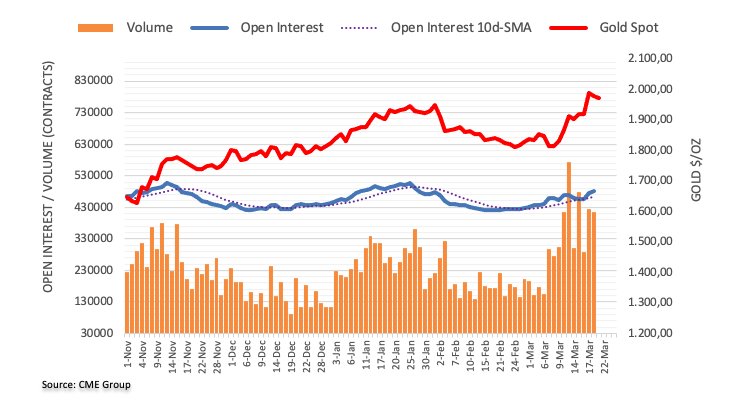
Silver price technical outlook is also bullish
Silver price has not made the same headlines as its brightest counterpart in Gold, but the second-highest traded metal has also profited from the banking crisis. The technical scenario in XAG/USD remains with bullish potential intact despite the recent retracement. Haresh Menghani, Market Analyst at FXStreet, writes:
“The recent breakout through the $21.65-$21.70 confluence resistance was seen as a fresh trigger for bullish traders. Furthermore, a subsequent move and acceptance above the 50% Fibonacci retracement level of the recent sharp pullback from a multi-month peak further add credence to the constructive outlook. This, along with bullish oscillators on 4-hour and daily charts, suggests that the path of least resistance for the XAG/USD is to the upside.
Hence, any subsequent dip towards the overnight swing low, around the $22.20 area, which coincides with the 50$ Fibo. level, could be seen as a buying opportunity.”
- GBP/USD snaps a three-day winning streak and is pressured by a modest USD bounce.
- A further recovery in the US bond yields is seen as a key factor benefitting the buck.
- Bets for a less hawkish Fed and a positive risk tone to act as a headwind for the USD.
- Traders now look to the FOMC decision on Wednesday ahead of the BoE on Thursday.
The GBP/USD pair comes under some selling pressure on Tuesday and snaps a three-day winning streak to its highest level since early February, around the 1.2285 region touched the previous day. The pair maintains its offered tone through the first half of the European session and is currently placed near the lower end of its daily range, around the 1.2235-1.2230 zone.
A strong follow-through recovery in the US Treasury bond yields assists the US Dollar (USD) to regain some positive traction and reverse a part of the overnight losses to a five-week low, which, in turn, exerts downward pressure on the GBP/USD pair. The US bond yields breathed a sigh of relief on Monday after the news that UBS will rescue Credit Suisse in a $3.24 billion deal helped ease fears of widespread contagion risk. That said, rising bets for a less aggressive policy tightening by the Federal Reserve (Fed) could act as a headwind for the US bond yields and cap any meaningful upside for the Greenback.
In fact, the markets now seem convinced that the Fed will soften its hawkish stance and deliver a smaller 25 bps rate hike at the end of a two-day policy meeting on Wednesday. Market participants also expect that the US central bank might even cut rates during the second half of the year. The speculations were fueled by the collapse of two mid-size US banks - Silicon Valley Bank and Signature Bank. Hence, investors will closely scrutinize the accompanying monetary policy statement and Fed Chair Jerome Powell's comments during the post-meeting presser for fresh clues about the future rate-hike path.
This will be followed by the Bank of England (BoE) policy meeting, which will play a key role in influencing the British Pound and provide a fresh directional impetus to the GBP/USD pair. In the meantime, a generally positive tone might hold back traders from placing bullish bets around the safe-haven buck and lend some support to the major. Traders now look to the US economic docket, featuring the release of the US Existing Home Sales data later during the early North American session. This, along with some repositioning trade ahead of the key central bank event risks, might produce short-term opportunities.
Technical levels to watch
Dr. Marcel Rohner, Switzerland’s Banking Association Chairman, said on Tuesday, “credibility in Swiss banking has not been destroyed by the Credit Suisse crisis, but the situation is not good.”
“The Swiss credit supply is not a problem, our banking environment is increasingly competitive,” Rohner added.
Market reaction
Risk sentiment is in a firmer spot so far this Tuesday, with the US S&P 500 futures up 0.31% on the day. Meanwhile, the US Dollar Index is posting 0.12% on the day to trade at 103.40.
GBP/USD has continued to trade in a very tight range for the past month, hovering around the 1.20 level. Economists at Morgan Stanley maintain a neutral stance with a bearish tilt.
BoE to pause this week
“We stay tactically neutral on GBP but continue to see risks skewed to the downside.”
“We see the BoE remaining on the back foot, as 1) the budget was largely supply side focused, 2) private sector pay cooled a touch more than we had expected, and 3) the global backdrop now includes elevated uncertainty and financial stability concerns.”
“We now expect the BoE to be the first among its G3 peers to pause at its upcoming meeting, in contrast with the Fed and the ECB where they see a string of 25 bps hikes in the upcoming meetings.”
- USD/CAD regains positive traction on Tuesday and draws support from a combination of factors.
- Bearish Oil prices undermine the Loonie and lend some support amid a modest USD strength.
- Bets for a less hawkish Fed cap gains for the buck and the pair ahead of the Canadian CPI report.
The USD/CAD pair attracts some buying in the vicinity of the 1.3650 region on Tuesday and stick to its modest intraday gains through the early part of the European session. Spot prices, however, struggle to capitalize on the move and retreat a few pips from the 1.3700 neighbourhood, or a fresh daily high touched in the last hour.
Crude Oil prices come under some renewed selling pressure and languish just above a 15-month low touched the previous day amid worries that a deeper global economic downturn will dent fuel demand. This, in turn, is seen undermining the commodity-linked Loonie, which, along with a modest US Dollar recovery from its lowest level since February 14, acts as a tailwind for the USD/CAD pair. That said, a combination of factors keeps a lid on any meaningful upside for the buck and the major, at least for the time being.
The news that UBS will rescue Credit Suisse in a $3.24 billion deal helps ease fears of widespread contagion risk and boosts investors' confidence, which is evident from a generally positive tone around the equity markets. Apart from this, expectations that the Federal Reserve (Fed) will soften its hawkish stance to prevent any further economic pressure from high borrowing costs further contribute to capping the safe-haven Greenback. In fact, the current market pricing indicates a greater chance of a 25 bps Fed rate hike in March.
Market participants also expect that the US central bank might even cut rates during the second half of the year. The speculations were fueled by the collapse of two mid-size US banks - Silicon Valley Bank and Signature Bank. This, in turn, should act as a headwind for the US bond yields and might hold back traders from placing aggressive bullish bets ahead of the key central bank event risk. The Fed is scheduled to announce its monetary policy decision at the end of a two-day meeting on Wednesday and drive the USD demand.
In the meantime, traders on Tuesday will take cues from the release of the latest Canadian consumer inflation figures, due later during the early North American session. The data, along with Oil price dynamics, will influence the Canadian Dollar and provide some impetus to the USD/CAD pair. Apart from this, the US economic docket - featuring Existing Home Sales data - will also be looked upon to grab short-term opportunities.
Technical levels to watch
EUR/USD closed above 1.0700. The ability of European regulators to restore some calm to the AT1 bond market appears a necessary condition to keep the pair supported, according to economists at ING:
Impact on the Euro of ECB speakers is probably not very significant at the moment
“The impact on the Euro of ECB speakers is probably not very significant at the moment. First, unlike in other instances, it seems like there has been no communication gap between markets and Lagarde at last week’s press conference. Second, higher rate expectations on the back of hawkish rhetoric are not a short-term EUR driver in the short-term at the moment, as the common currency is trading strictly in line with risk sentiment and on news about the banking sector.”
“The ability of European regulators to restore some calm to the AT1 bond market appears a necessary condition to keep EUR/USD supported, even though we think some USD recovery is possible into the Fed meeting.”
- Gold price continues retreating from year-to-date highs.
- Markets settle as banking crisis fears fade following Credit Suisse rescue.
- US Dollar rebounds in run up to Federal Reserve meeting on Wednesday.
Gold price pulls back from its yearly high as global banking jitters pass (for now) and US Treasury yields find a floor, supporting a stronger US Dollar. The precious metal trades at $1,972 at the time of writing as it continues to consolidate within a technical uptrend.
Gold news: Safe-haven flows ease on banking rescue
The dust settles after the latest casualty of the current neo-financial crisis, Credit Suisse, was swallowed up by rival UBS on Monday, and Gold – the safe-haven par excellence – loses the upside momentum that propelled it to YTD highs above $2,000.
In the United States, treasury staff are looking at ways for regulators to insure more than the current Federal Deposit Insurance Cap (FDIC) of $250,000 for bank deposits, to increase confidence in the banking system, according to a report by Bloomberg News on Monday. This provides further evidence to reassure investors that authorities are willing to step in to save the day.
US Dollar rallies before FOMC
The US Dollar is on the rise, reflected in the 0.20% gain seen in the US Dollar Index on the day, which tracks the world’s reserve currency against a basket of counterparts. Since Gold is priced in US Dollars, it tends to have an inverse relationship – when the Dollar strengthens it takes less of them to buy the same quantity of Gold, all other things being equal.
The next big event for both Gold and the US Dollar is the FOMC meeting on Wednesday, March 22 at 18:00 GMT, at which the US Federal Reserve will make its next monetary policy decision. The odds currently favor a more-modest-than-was-previously-expected 0.25% increase in interest rates.
If the Fed decides to go big with a 0.50% rate hike, however, it will boost the Dollar and push down Gold price – no cut at all will have the opposite effect.
Making the decision a little more complicated this time, however, is the recent banking crisis which was triggered in part by rising interest rates. Whilst the Fed wants to battle inflation, it must now also take into consideration the impact of higher interest rates on financial stability.
Another factor to consider is what the board of governors expects the terminal rate to be, which is reflected in the dot plot, within its Summary of Economic Projections. As Eren Sengezer, European Session Lead Analyst at FXStreet, points out in his Fed meeting preview, a modest hike accompanied by signs rates might be peaking soon could still be interpreted as dovish.
“In case the Fed raises the policy rate by 25 basis points but the dot plot shows at least one rate cut before the end of the year, that could also be assessed as a dovish shift in the policy outlook,” says Sengezer.
Gold price technical analysis: Pullback within an uptrend
From a technical perspective Gold price remains in an uptrend both on the short and medium timeframe. It was ascending in a steep channel but now appears to be pulling back down after peaking on Monday.
The Average Directional Indicator (ADX) on the 4-hour chart is at 55, which is a very high reading. ADX measures how strongly an asset’s price is trending and when it reaches above 50 it is often a sign the trend is close to exhaustion. Given the high reading was accompanied by a two bar reversal pattern from Monday’s highs and a steady decay since, it may be a sign Gold price could pull back further, probably to the base of the channel in the $1,960 region.
Overall the trend is bullish, however, suggesting that once it has finished its correction it will probably continue rising. It could require a decisive break and close below the lower channel line to indicate a deeper correction or reversal of the uptrend was taking place.
-638149836031015330.png)
Gold price: 4-hour Chart
Gold breached $2,000 as investors continued to increase their exposure to the precious metal. Improved risk appetite should not dissuade investors to place bets on the yellow metal, in the view of strategists at ANZ Bank.
Any dovish Fed commentary to support Gold
“Improved risk appetite should see gains across the sector. This isn’t expected to deter further inflows into Gold.”
“Despite banking regulators rushing to shore up market confidence, the uncertain macro backdrop continues to entice buying.”
“All eyes now shift to the Fed’s two-day meeting. Any dovish commentary should help support the precious metals sector.”
Further losses remain on the cards while USD/CNH trades below the 6.8550 level, comment UOB Group’s Economist Lee Sue Ann and Markets Strategist Quek Ser Leang.
Key Quotes
24-hour view: “Yesterday, we expected USD to trade sideways between 6.8550 and 6.9000. USD then traded between 6.8728 and 6.9054. The underlying tone has softened somewhat and USD is likely to edge lower today. However, a clear break of 6.8550 is unlikely. Resistance is at 6.8920, followed by 6.9020.”
Next 1-3 weeks: “We have expected USD to weaken since early last week. USD has not been able to make any headway on the downside. Downward momentum is waning rapidly and USD has to break and stay below 6.8550 in the next 1-2 days or it is unlikely to weaken further. Conversely, a breach of 6.9100 (‘strong resistance’ level) would suggest USD could trade sideways for a period of time.”
- The index bounces off recent lows near 103.30.
- The Fed’s 2-day meeting starts later in the session.
- Existing Home Sales will be the only release in the US docket.
The greenback, in terms of the USD Index (DXY), manages to regain some tepid upside traction and rebounds from Monday’s lows in the 103.30/25 band.
USD Index focuses on the FOMC event
The index so far reverses three consecutive daily pullbacks, including Monday’s drop to multi-week lows around 103.30, amidst some mild selling pressure in the risk complex and the flat performance in US yields across the curve.
In the meantime, and according to CME Group’s FedWatch Tool, the probability of a 25 bps rate hike by the Fed on Wednesday hovers around the 80%, although investors are expected to closely follow any suggestion by the Committee that the Fed could pause its tightening cycle in the relatively near term.
The above appears somehow justified by the loss of momentum in some US fundamentals as of late and the persistent disinflation witnessed since July 2022.
Data wise in the US, the only release of note will come from the Existing Home Sales for the month of February.
What to look for around USD
The index remains under pressure and keeps the trade well in the sub-104.00 region amidst a broad-based range bound theme in the rest of the markets.
The risk aversion derived from banking jitters appears diminished and supports the selling bias in the dollar amidst firmer conviction among investors of a 25 bps rate hike by the Federal Reserve at the next meeting on March 22.
So far, reinvigorated bets of a Fed’s pivot in the short-term horizon could keep the price action around the dollar somewhat depressed. However, the still elevated inflation and the resilience of the US economy should continue to play against that view.
Key events in the US this week: Existing Home Sales (Tuesday) – MBA Mortgage Applications, FOMC Interest Rate Decision, Powell press conference (Wednesday) – Initial Jobless Claims, Chicago Fed National Activity Index, New Home Sales (Thursday) – Durable Goods Orders, Advanced PMIs (Friday).
Eminent issues on the back boiler: Rising conviction of a soft landing of the US economy. Persistent narrative for a Fed’s tighter-for-longer stance. Terminal rates near 5.5%? Fed’s pivot. Geopolitical effervescence vs. Russia and China. US-China trade conflict.
USD Index relevant levels
Now, the index is advancing 0.13% at 103.44 and faces the next resistance at 105.88 (2023 high March 8) seconded by 106.62 (200-day SMA) and then 107.19 (weekly high November 30 2022). On the other hand, the breach of 103.27 (monthly low March 20) would open the door to 102.58 (weekly low February 14) and finally 100.82 (2023 low February 2).
These are tough times for the Norwegian Krone. Will Norges Bank be able to give NOK some strength? Economists at Commerzbank analyze what should do the central bank to support the currency.
It would be disastrous not to hike the key rate further
“It would be disastrous not to hike the key rate further in view of the broad-based inflation pressure, even less so signalling an end of the rate cycle. Even though Norges Bank was one of the first central banks to hike its key rate while inflation pressure does not show any signs of easing Norges Bank will have to keep a tight grip on the situation and keep the door open for further hikes.”
“If Norges Bank, who seems less restrictive compared to the ECB anyway, chooses this approach it can help NOK to gain new strength as the market, contrary to the analysts’ opinions, is expecting unchanged key rates and significant rate cuts in the autumn and would therefore have to adjust its expectations significantly. Otherwise, it will be difficult for NOK to record notable gains against the Euro in the near future and downside potential will then dominate instead.”
In the opinion of UOB Group’s Economist Lee Sue Ann and Markets Strategist Quek Ser Leang, further decline in USD/JPY should meet the next relevant contention around 129.80 in the short term.
Key Quotes
24-hour view: “Our view for USD to trade sideways was incorrect as it plunged to 130.52 before rebounding to close at 131.31 (-0.36%). The rapid decline is oversold but with no sign of stabilization yet, USD is likely to test the major support at 130.45. A sustained drop below this level is unlikely today (next support is at 130.00). On the upside, a breach of 132.00 (minor resistance is at 131.60) would suggest the weakness in USD has stabilized.”
Next 1-3 weeks: “Yesterday (20 Mar, spot at 132.40), we noted that the outlook for USD is still negative but we were of the view that it ‘has to break and stay below 131.50 before a move towards the next support at 130.45 is likely’. We did anticipate the sharp drop as USD plummeted to 130.52 in London trade. Further USD weakness appears likely. A break of 130.45 would not be surprising. The next major support is at 129.80. On the upside, a breach of 132.60 (‘strong resistance’ was at 133.80 yesterday would indicate that the USD weakness that started early last week (see annotations in the chart below) has come to an end.”
- NZD/USD drifts lower for the second straight day and retreats further from over a one-month top.
- A modest USD recovery from its lowest level since February 14 exerts some pressure on the pair.
- Sliding US bond yields, bets for a less hawkish Fed, a positive risk tone to cap gains for the buck.
The NZD/USD pair extends the overnight modest pullback from the 0.6280 area, or over a one-month high and continues losing ground for the second successive day on Tuesday. The corrective decline remains uninterrupted through the early European session, with bears now awaiting a sustained weakness below the 0.6200 round-figure mark before placing fresh bets.
The US Dollar (USD) regains some positive traction and snaps a three-day losing streak to its lowest level since February 14, which, in turn, is seen exerting downward pressure on the NZD/USD pair. That said, a fresh leg down in the US Treasury bond yields, amid diminishing odds for a more aggressive policy tightening by the Federal Reserve (Fed), could act as a headwind for the buck. Apart from this, a generally positive risk tone could help limit losses for the risk-sensitive Kiwi, at least for now.
The collapse of two mid-size US banks - Silicon Valley Bank and Signature Bank - fueled speculations that the US central bank will soften its hawkish stance to prevent any further economic pressure from high-interest rates. In fact, the markets are pricing in a greater chance of a smaller 25 bps lift-off in March and that the Fed might even cut rates during the second half of the year. This, in turn, continues to drag the US bond yields lower and should keep a lid on any meaningful upside for the Greenback.
Meanwhile, the news that UBS will rescue Credit Suisse in a $3.24 billion deal helps ease fears of widespread contagion risk and boosts investors' confidence. This is evident from a further recovery in the global equity markets, which tends to undermine traditional safe-haven assets and might further contribute to capping the buck. Market participants, however, remain worried about a full-blown banking crisis. This might hold back traders from positioning for the resumption of the NZD/USD pair's recent recovery from the 0.6085 region, or its lowest level since November 17 touched earlier this month.
Moving ahead, Tuesday's US economic docket features the release of Existing Home Sales data and might provide some impetus later during the early North American session. The focus, however, will remain glued to the outcome of the highly-anticipated two-day FOMC monetary policy meeting, scheduled to be announced on Wednesday. This will play a key role in influencing the near-term USD price dynamics and determine the next leg of a directional move for the NZD/USD pair.
Technical levels to watch
CME Group’s flash data for natural gas futures markets noted traders increased their open interest positions for the third consecutive session on Monday, now by around 10.6K contracts. On the other hand, volume went down for the third session in a row, now by around 37.3K contracts.
Natural Gas could slip back to $2.00
Prices of natural gas added to Friday’s losses at the beginning of the week. The negative price action was amidst increasing open interest and favours the continuation of the downtrend in the very near term. That said, the big magnet for bears remains at the $2.00 mark per MMBtu, or 2023 lows.
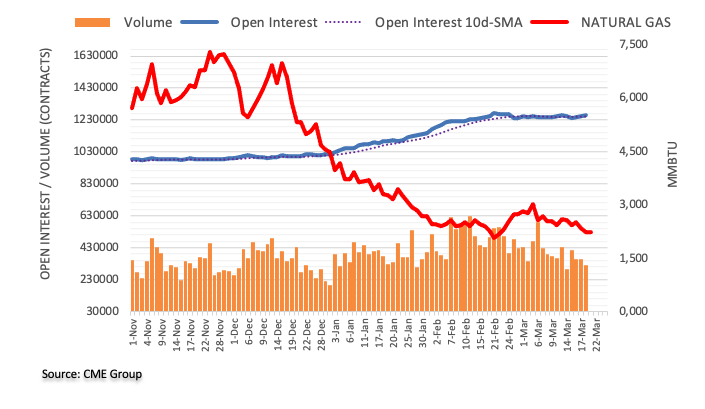
Here is what you need to know on Tuesday, March 21:
Market participants refrain from committing to large positions early Tuesday following Monday's chaotic action. ZEW Survey for the Euro area and Germany will be featured in the European economic docket. Later in the day, Statistics Canada will publish inflation figures. Finally, Existing Home Sales from the US will be looked upon for fresh impetus in the early American session.
Risk flows dominated the market action at the beginning of the week but the sharp decline witnessed in the global bond yields in the European session caused investors to take a step back. Nevertheless, Wall Street's main indexes managed to close in positive territory on Monday and the 10-year US Treasury bond yield recovered back above 3.4%. Meanwhile, the US Dollar struggled to stay resilient against its rivals.
Early Tuesday, the US Dollar Index holds steady slightly below 103.50 and the 10-year US T-bond yield fluctuates between 3.4% and 3.5%. US stock index futures are up around 0.2%, reflecting a slight improvement in risk sentiment.
EUR/USD took advantage of the broad-based US Dollar weakness and closed above 1.0700. The pair stays in a consolidation phase near Monday's closing level. "We are very confident that capital and liquidity positions of the Euro area banks are well in excess of requirements," European Central Bank (ECB) President Christine Lagarde said while testifying before the European Parliament's Committee on Economic and Monetary Affairs on Monday.
GBP/USD gained nearly 100 pips on Monday and registered its highest daily close since early February. The pair stages a technical correction early Tuesday and was last seen trading modestly lower on the day near 1.2250.
The Reserve Bank of Australia's policy meeting minutes revealed in the Asian session that policymakers agreed to reconsider the case for a pause, "recognizing that pausing would allow additional time to reassess the outlook for the economy." Although AUD/USD climbed to a daily high of 0.6720 with the initial reaction, it struggled to preserve its bullish momentum. As of writing, the pair was trading near 0.6700.
The Consumer Price Index (CPI) in Canada is expected to decline to 5.4% on a yearly basis in February from 5.9% in January. On Monday, recovering crude oil prices helped the commodity-sensitive loonie find demand and USD/CAD closed in negative territory below 1.3700. The pair consolidates Monday's losses and stays slightly below 1.3700 early Tuesday.
Gold price lost its traction after having climbed to fresh multi-month highs above $2,000 on Monday and ended the day deep in the red. XAU/USD struggles to stage a rebound in the European morning and fluctuates below $1,980.
Following last week's impressive rally, Bitcoin corrected lower and closed below $28,000. As of writing, BTC/USD was down nearly 1% on the day at around $27,600. Ethereum fell nearly 3% on Monday and continues to edge lower toward $1,700 early Tuesday.
EUR/GBP is set to trade around the 0.88 mark, in the view of analysts at Danske Bank.
EUR/GBP stuck between opposing forces
“In the very short-term, changes to systemic risk fears will remain the key driver of the cross.”
“Further out, EUR/GBP is, in our view, stuck between opposing forces. On the one hand, we expect relative rates to act as a clear tailwind, while global growth slowdown and the relative appeal of UK assets act as a headwind. At present, we do not see the relative growth outlook or global investment environment to create a significant divergence between EUR and GBP.
“We expect the cross to remain range bound around 0.87-0.88.”
According to UOB Group’s Economist Lee Sue Ann and Markets Strategist Quek Ser Leang, NZD/USD could edge higher and revisit the 0.6310 level and above in the near term.
Key Quotes
24-hour view: “Yesterday, we expected further NZD strength towards 0.6310. However, NZD traded between 0.6230 and 0.6290. NZD is likely to consolidate today, expected to be between 0.6210 and 0.6270.”
Next 1-3 weeks: “Our update from yesterday (20 Mar, spot at 0.6270) is still valid. As highlighted, after the strong rise on last Friday, upward momentum has increased. The increase in momentum is likely to lead to further NZD strength to 0.6310, possibly 0.6360. That said, overbought short-term conditions could lead to a couple of days of consolidation first. Overall, only a breach of 0.6185 (no change in ‘strong support’ level) would indicate that NZD is not ready to head higher.”
Considering advanced prints from CME Group for crude oil futures markets, open interest dropped by around 3.8K contracts after three consecutive daily builds. Volume followed suit and went down by around 365.2K contracts, leaving behind the previous daily advance.
WTI: Another visit to the vicinity of $64.00 seems favourable
Monday’s rebound in prices of the WTI was accompanied by shrinking open interest and volume, hinting at the likelihood that extra gains look not favoured for the time being. Against that, the door appears open to further weakness in the commodity in the very near term and with another visit to the so far 2023 low at $64.40 well on the cards.

Further gains could lift GBP/USD to the 1.2400 region in the next few weeks, note UOB Group’s Economist Lee Sue Ann and Markets Strategist Quek Ser Leang.
Key Quotes
24-hour view: “While we expected GBP to strengthen yesterday, we held the view that ‘a sustained rise above 1.2220 appears unlikely’. We did not anticipate the strong advance as GBP soared to 1.2286 before closing a firm note at 1.2277 (+0.79%). Strong upward momentum suggests further GBP strength towards 1.2330. The major resistance at 1.2400 is likely out of reach today. The upside risk is intact as long as GBP stays above 1.2220 (minor support is at 1.2250).”
Next 1-3 weeks: “We noted yesterday (20 Mar, spot at 1.2180) that ‘upward momentum is beginning to build’. We held the view that GBP ‘has to break and stay above 1.2220 before a sustained rise is likely (the next resistance is at 1.2270)’. We did not anticipate the rapid improvement in momentum, as GBP easily took out both 1.2220 and 1.2270 and surged to 1.2286. The price actions suggest GBP is likely to strengthen further to 1.2400. The strong support at 1.2180 (level was at 1.2095 yesterday) is likely to hold, at least for the next couple of days.”
- USD/JPY picks up bids to poke short-term key resistance during the first positive day in three.
- Ascending trend line from mid-January challenges Yen pair bears amid nearly oversold RSI.
- Sluggish MACD, likely trendline breakout on RSI (14) add strength to the bullish bias.
- 200-SMA holds the key to buyers’ entry; sellers have a bumpy road towards the south.
USD/JPY renews its intraday high near 131.70 during the first positive day in three amid early Tuesday in Europe. In doing so, the Yen pair bounces off the lowest levels in five weeks while poking a one-week-old resistance line.
That said, the sluggish MACD signals and the RSI (14) line’s battle with the fortnight-old trend line resistance suggests that the upside momentum is likely to return to the table.
Adding strength to the bullish bias could be the USD/JPY pair’s recovery from an ascending support line from January 16, close to 130.60 by the press time.
As a result, the USD/JPY pair is likely to cross the immediate trend line hurdle surrounding 131.70, which in turn could allow the buyers to aim for another upside hurdle, namely a downward-sloping resistance line from March 08, close to 133.10 at the latest.
It should, however, be noted that the USD/JPY bulls should remain cautious unless the quote remains below the 200-SMA level surrounding 134.10.
Alternatively, a clear downside break of the stated multi-day-old support line, around 130.60, isn’t an open invitation to the USD/JPY bears as multiple lows marked during February 10 and early January, respectively near 129.80 and 128.00, as well as the Year-To-Date (YTD) bottom near 127.20 could challenge the Yen pair sellers afterward.
USD/JPY: Four-hour chart
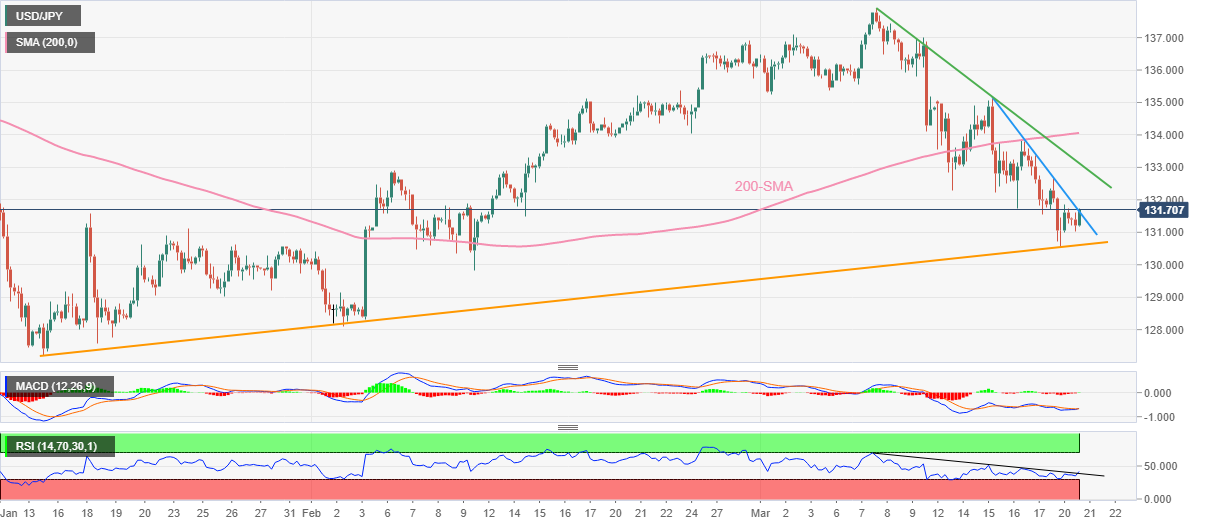
Trend: Further upside expected
Open interest in gold futures markets rose for the third straight session on Monday, this time by around 6.1K contracts according to preliminary readings from CME Group. Volume, instead, shrank by around 10.6K contracts, partially reversing the previous daily build.
Gold: Interim support comes at the 55-day SMA near $1880
Gold prices started the week on the defensive after hitting new 2023 highs past the key $2000 mark per ounce troy. The knee-jerk came in tandem with rising open interest and indicates that the continuation of the decline appears likely in the very near term. That said, the 55-day SMA at $1881 emerges as the a temporary support for the time being.
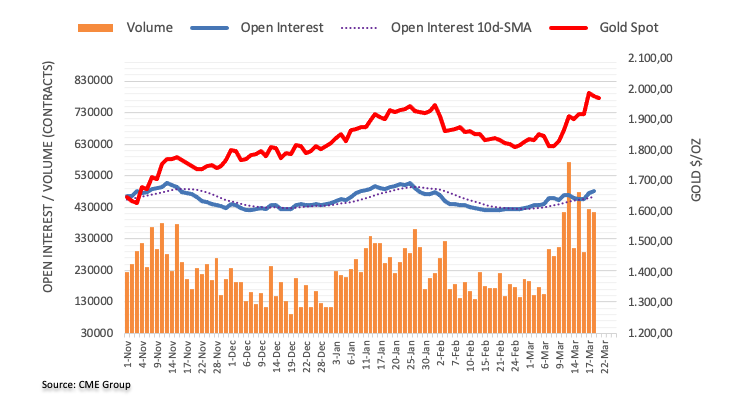
- Silver remains on the defensive for the second straight day, albeit lacks follow-through.
- The technical setup supports prospects for the emergence of dip-buying at lower levels.
- Bulls need to wait for a move beyond the 61.8% Fibo. level before placing fresh bets.
Silver extends its consolidative price move for the second straight day on Tuesday and remains well within the striking distance of its highest level since February 3 touched the previous day. The white metal trades just below the mid-$22.00s during the early European session and still seems poised to prolong its recent appreciating move witnessed over the past two weeks or so.
The recent breakout through the $21.65-$21.70 confluence resistance was seen as a fresh trigger for bullish traders. Furthermore, a subsequent move and acceptance above the 50% Fibonacci retracement level of the recent sharp pullback from a multi-month peak further add credence to the constructive outlook. This, along with bullish oscillators on 4-hour and daily charts, suggests that the path of least resistance for the XAG/USD is to the upside.
Hence, any subsequent dip towards the overnight swing low, around the $22.20 area, which coincides with the 50$ Fibo. level, could be seen as a buying opportunity. That said, some follow-through selling below the $22.00 mark could drag the XAG/USD to the $21.65-$21.70 confluence resistance break point. This comprises the 200-period Simple Moving Average (SMA) on the 4-hour chart and the 38.2% Fibo. level, which should act as a pivotal point.
A convincing break below the latter could expose the $21.00 mark, representing the 23.6% Fibo. level. The XAG/USD might then turn vulnerable to accelerate the fall towards testing the $20.55-$20.50 intermediate support en route to the $20.00 psychological mark. The downward trajectory could get extended further towards the next relevant support near the $19.60 region.
On the flip side, the $22.70 area, or a multi-week top touched on Monday, could act as an immediate hurdle ahead of the 61.8% Fibo. level, around the $22.85 region and the $23.00 mark. Some follow-through buying will pave the way for a move towards testing the next relevant hurdle near the $23.25-$23.35 zone en route to the $24.00 round-figure mark. Bulls might then aim to challenge the multi-month top, around the $24.65 zone touched in February.
Silver 4-hour chart
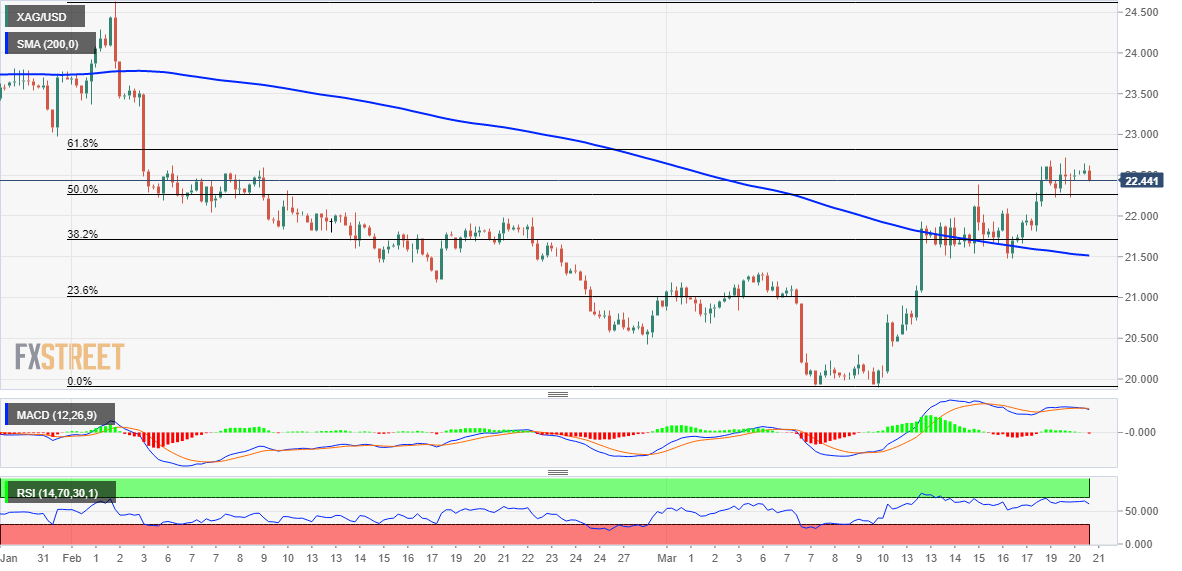
Key levels to watch
Gold price consolidates previous losses. XAU/USD has more room to the upside on acceptance above $2,000, FXStreet’s Dhwani Mehta reports.
Retracement in XAU/USD could find buyers initially at $1,970
“Acceptance above the $2,000 mark is critical to sustaining the recent bullish momentum. The next upside target for Gold buyers is seen at the yearly high of $2,010. Further up, all eyes will be on the 2022 top of $2,071 and the all-time high at $2,075.”
“On the flip side, the retracement in the Gold price could find buyers initially at the $1,970 round figure, below which the previous day’s low at $1,966 will be tested. Gold sellers will then challenge the February high at $1,960, which could be a tough nut to crack.”
See – Gold Price Forecast: XAU/USD to head gradually toward $2,055/75 – SocGen
UOB Group’s Economist Lee Sue Ann and Markets Strategist Quek Ser Leang suggest EUR/USD is expected to maintain the consolidative range unchanged for the time being.
Key Quotes
24-hour view: “We expected EUR to test 1.0725 yesterday but we were of the view that ‘the next resistance at 1.0760 is not expected to come under threat’. Our view was not wrong as EUR rose to 1.0730 before closing at 1.0719 (+0.50%). While the advance does not possess a lot of momentum, there is room for EUR to rise to 1.0760 before a pullback is likely. The major resistance at 1.0800 is unlikely to come into view. Support is at 1.0700, a breach of 1.0680 would indicate EUR is not advancing further.”
Next 1-3 weeks: “Yesterday (20 Mar, spot at 1.0680), we indicated that EUR appears to be trading in a consolidation phase, likely in a broad range between 1.0600 and 1.0800. We continue to hold the same even though the firm short-term outlook suggest EUR is likely to test 1.0800 in the next few days. At this stage, we do not expect a sustained rise above this level.”
European Central Bank’s (ECB) policymaker and Spanish central bank head Pablo Hernandez de Cos said on Tuesday, “market expectations of a 3.25% rate peak cannot be validated.”
Additional quotes
“The ECB is ready to react to maintain price stability, financial stability and the Eurozone's finance.”
“We have many tools to ensure liquidity to the finance system.”
Market reaction
EUR/USD is challenging bullish commitments at the 1.0700 level so far this Tuesday. The spot is down 0.11% on the day.
- EUR/GBP tumbles towards 0.8700 as banking turmoil weighs on the Euro.
- Pound gains on Euro as market brace for UK CPI data and BoE policy decision.
- GBP buoyed by increasing odds of a pause in the BoE rate decision.
EUR/GBP faces significant pressure as the market awaits the UK Consumer Price Index (CPI) and Bank of England (BoE) policy decision. The Euro has started to fall amid ongoing banking issues, as reports suggest that two more commercial banks are under scrutiny for possible contagion.
The Pound sterling is getting a boost as money markets price in a 50% chance of no interest rate hike by the BoE on Thursday, and the same chance of a 25 basis-point increase. With the odds of a pause rising, this is perceived as positive amid banking turmoil.
EUR/GBP is currently sitting around a multi-month low at the 0.8725 level, which is also the surface of an ascending trendline beginning at the 0.8342 mark on a daily timeframe. A convincing break below would likely send the pair towards uncharted territory until the support zone at the 0.8600 level.
The 21- Daily Moving Average (DMA) and 50-DMA crossover is contributing to the downside bias for EUR/GBP. Any upside gains are likely to be capped around the 0.8800 mark, followed by both Moving Averages. Although the Relative Strength Index (RSI) is signaling an oversold condition for the pair, the price is likely due for a pullback.
All eyes will be on the UK's CPI data before heading into the BoE rate decision later this week.
EUR/GBP: Daily chart

FX option expiries for Mar 21 NY cut at 10:00 Eastern Time, via DTCC, can be found below.
- EUR/USD: EUR amounts
- 1.0600 565m
- 1.0675 797m
- 1.0690 2b
- GBP/USD: GBP amounts
- 1.2100 504m
- 1.2150 570m
- USD/JPY: USD amounts
- 133.25-50 805m
- USD/CAD: USD amounts
- 1.3710 945m
- Natural Gas holds lower ground after declining in the last two consecutive days.
- Fears of less energy demand from Asia, mild winter in Europe weigh on the quote.
- US Dollar pares recent losses as yields take a breather at multi-day low.
- Banking crisis, official inventory from EIA will be in focus for fresh impulse.
Natural Gas stays pressured around $2.34, following a two-day downtrend heading into Tuesday’s European session. In doing so, the energy prices bear the burden of the US Dollar’s corrective bounce, as well as the market’s fears of easing gas demand and higher supplies.
US Dollar Index (DXY) bounces off the lowest levels since early February, marked the previous day, while snapping a three-day downtrend, mildly bid around 103.40 by the press time. In doing so, the greenback’s gauge versus the six major currencies traces the late Monday’s recovery in the US Treasury bond yields, as well as the hawkish Fed bets, to tease buyers.
Elsewhere, fears of easing demand supersede the supply crunch fears, initially backed by the Russia-Ukraine crisis. In this regard, The Guardian quotes Seb Kennedy, head of data insights at TransitionZero while saying, “An unexpectedly mild winter in Europe and lower demand from Asia have tempered enthusiasm for the fuel, with a shipload now expected to earn about $37m profit. The news also stated that despite the current enthusiasm for Liquefied Natural Gas (LNG), next year may be the last that the number of LNG terminal projects of any size will move forward, as global appetite for natural gas is expected to fall.
On a different page, hopes of easing the banking crisis seem to have favored the market sentiment and drowned the US Dollar. UBS’ takeover of the troubled Credit Suisse, by paying 3 billion Swiss francs (£2.6bn), eased the market’s baking fears. On the same line were statements from the US Federal Deposit Insurance Corporation (FDIC) mentioning that the deposits of Signature Bridge Bank will be assumed by a subsidiary of New York Community Bancorporation.
It’s worth noting that the mixed concerns around the banking turmoil challenge the previous risk-on mood and join the mixed concern about the major central banks’ next moves to revive the US Treasury bond yields and weigh on commodity prices.
Moving ahead, Natural Gas traders should keep their eyes on the risk catalysts, as well as the weekly official gas inventories from the Energy Information Administration (EIA).
Technical analysis
With late February’s failure to cross the 50-DMA hurdle, currently around $2.73, Natural Gas bears are likely to approach the previous monthly low surrounding $2.17, also the lowest level since August 2020.
- EUR/USD snaps three-day winning streak with mild losses.
- Convergence of 200-SMA, weekly support line appears a tough nut to crack for bears before retaking control.
- Euro buyers need validation from five-week-old resistance line to keep the reins.
EUR/USD struggles to defend the 1.0700 threshold, printing mild losses heading into Tuesday’s European session, as it snaps a three-day uptrend.
The Euro pair’s pullback joins the RSI (14) line’s retreat and receding bullish bias of the MACD signals to suggest further downside.
However, the 200-SMA and an ascending trend line from the last Wednesday, around 1.0660, appear strong support for the bears to break before ushering further.
In a case where the EUR/USD price drops below 1.0660, multiple supports may test the bears around 1.0540 and 1.0525 before highlighting the monthly low of 1.0516.
Additionally, the quote’s weakness past 1.0516 could direct sellers to aim for January’s low surrounding 1.0480 for further dominance.
Meanwhile, EUR/USD recovery remains elusive unless crossing a one-month-old descending resistance line, around 1.0750 at the latest.
Following that, the monthly high and mid-February peak, respectively around 1.0760 and 1.0805, could challenge the Euro pair’s further upside.
Should the quote remains firmer past 1.0805, the odds of witnessing a run-up to refresh the Year-To-Date (YTD) high, currently around 1.1035 can’t be ruled out.
Overall, EUR/USD is likely to witness a short-term pullback but the bears are far from retaking control.
EUR/USD: Four-hour chart

Trend: Pullback expected
- AUD/USD may display further downside as investors believe that RBA’s response to Australian stubborn inflation is ordinary.
- RBA policymakers are worried that monthly Consumer Price Index (CPI) could remain volatile from month to month.
- To contain the consequences of elevating banking stress, Fed could consider silence on interest rates.
The AUD/USD pair is displaying a back-and-forth action below the round-level resistance of 0.6700 in the early Asian session. The Aussie asset still looks vulnerable below 0.6700 and is expected to continue its downside as the release of the Reserve Bank of Australia (RBA) minutes have confirmed that RBA policymakers are not very hawkish as expected by the street.
In considering the policy decision, members observed that inflation in Australia remained too high, the labor market was very tight and wage growth had picked up. Surveys continued to signal that business conditions were favorable. Also, RBA policymakers considered the option of 25 basis points (bps) only despite persistent inflation in the Australian economy.
For inflation guidance, the minutes show that RBA policymakers are worried that the monthly Consumer Price Index (CPI) could remain volatile from month to month despite softening from its peak of 8.4%, recorded in December.
Meanwhile, S&P500 futures are sticking to some nominal losses, which have been added in the Asian session. The 500-US stocks basket recovered firmly on Monday as the street is anticipating an unchanged monetary policy from the Federal Reserve (Fed). To contain the consequences of elevating banking stress, Fed chair Jerome Powell could consider silence on interest rates as further policy tightening could propel fears of further banking turmoil.
The US Dollar Index (DXY) is struggling to extend its recovery move above 103.44 as the street believes in the hawkish case scenario, Fed won’t go beyond the 25 basis points (bps) rate hike as the revival of investors’ confidence has also become a priority for them.
European Central Bank (ECB) policymaker Martins Kazaks said on Tuesday, “uncertainty in the financial markets is high, but European banks are well capitalized.”
Additional comments
“Financial resources are available in Europe.”
“There is no reason to compare the situation with 2008. “
“Bank supervision is much stronger than back then.”
Market reaction
EUR/USD is keeping its range just above 1.0700 on the above comments. The pair is still down 0.07% on the day, as of writing.
- EUR/CHF is aiming to recapture the 1.0000 resistance as hawkish ECB bets soar.
- ECB Lagarde cited that inflation is projected to remain too high for too long.
- The demise of Credit Suisse has continued to weigh on the Swiss Franc.
The EUR/CHF pair is attempting to come out of the woods for an upside move above the immediate resistance of 0.9966 in the Asian session. The cross has remained in action after the demise of Credit Suisse, the second-largest bank in Switzerland. Although UBS has announced the acquisition of the former, the street expects that the fears of further banking turmoil would stay for a while.
The Euro has gained traction as European Central Bank (ECB) President Christine Lagarde has revised its guidance for Eurozone inflation on the upside. ECB Lagarde cited that inflation is projected to remain too high for too long, as reported by Reuters. She further added that wage pressures have strengthened on the back of robust labor markets and added that employees are aiming to recoup some of the purchasing power. This has bolstered hopes of the continuation of bigger rate hikes from the ECB.
EUR/CHF pair has extended its upside journey to near the prior inventory adjustment area whose breakdown led to a massive sell-off. The inventory adjustment area in a range of 0.9923-0.9967 serves as a territory where the asset spent the majority of time in its prior move and also covers significant volume.
The 20-period Exponential Moving Average (EMA) at 0.9940 is sloping north and will continue to provide support to the Euro bulls.
Adding to that, the Relative Strength Index (RSI) (14) is oscillating in the bullish range of 60.00-80.00, which indicates that bullish momentum is already active.
For further upside, a decisive break above March 20 high at 0.9966 will drive the cross toward the psychological resistance at 1.0000 followed by March 02 high at 1.0042.
On the flip side, a downside break below March 16 low at 0.9800 would drag the cross toward March 14 low at 0.9748. A slippage below the latter would expose the cross to March 15 low at 0.9706.
EUR/CHF hourly chart
-638149741176698931.png)
- XAU/USD reaches historic levels as investors seek safe-haven assets.
- Gold price surge amid falling US Treasury yields and global banking turmoil.
- Is the end of Fed’s hiking cycle near? Gold prices await a crucial decision.
Gold prices reached a fresh yearly high on Monday this week, with XAU/USD hitting the $2,000 mark for only the third time in recorded history; the last time was during the COVID era.
The robust bull run began from the March low of around $1,800, and gold prices have not looked back since. Gold prices have a strong inverse correlation with US Treasury (UST) bond yields, which experienced a notable decline in March.
The global banking turmoil has forced investors to reconsider their outlook on surging borrowing costs. Amid this uncertainty, investors chose to seek safety in US Treasury bonds, causing yields to fall.
Some speculations suggest we may have seen the peak in US Treasury yields. Two driving forces could be behind this exponential Gold price surge: Gold's role as a safe haven during adversity and falling UST yields.
Despite gold prices hovering around the $2,000 mark, it's too early to claim any top. According to the CME FedWatch tool, markets are pricing in a 26.2% chance that the Fed will stand pat at the end of its March 21-22 meeting, with around a 75% chance of a 25 basis point (bps) hike.
It's doubtful for the Fed to terminate the current hiking cycle with a surprise. However, one should remember that the Fed has made mid-cycle adjustments in the past. Given that most central banks are nearing their peak in the hiking cycle, it's not impossible that the Fed could signal the end of the cycle.
On the other hand, inflation remains above the 2% Fed’s target, so it would be premature for the Fed to pause or end the hiking cycle.
Levels to watch
- GBP/JPY takes offers to refresh intraday low, prints mild losses.
- DUP shows readiness to reject UK PM Sunak’s Brexit deal on Wednesday’s key voting.
- Market remains unclear as banking crisis tests BoE hawks.
GBP/JPY bears keep the reins around the intraday low of 160.76, down 0.18% on a day heading into Tuesday’s London open, as anxiety surrounding the Bank of England’s (BoE) next move joins Brexit woes. It’s worth noting that holiday in Japan restrict the cross-currency pair’s latest moves amid mixed feelings about the banking crisis.
Late on Monday, BBC News quotes Democratic Unionist Party (DUP) Leader Sir Jeffrey Donaldson as saying that the agreement was not sufficient to deal with concerns that his party had raised about post-Brexit trade rules for Northern Ireland. “The DUP has confirmed that it will oppose the deal - known as the Windsor Framework - when MPs are given a vote on part of it on Wednesday,” adds BBC News.
On the other hand, The Telegraph conveys multiple analysts’ estimations while saying, “The Bank of England (BoE) will be forced to abandon an interest rate rise this week following turmoil in global financial markets.” The forecasts become too important ahead of the “Super Thursday” as some on the floor expected a 50 bps rate hike from the “Old Lady”, as the BoE is casually known.
On a broader front, hopes of easing the banking crisis seem to have favored the market sentiment and drowned the US Dollar. UBS’ takeover of the troubled Credit Suisse, by paying 3 billion Swiss francs (£2.6bn), eased the market’s baking fears. On the same line were statements from the US Federal Deposit Insurance Corporation (FDIC) mentioning that the deposits of Signature Bridge Bank will be assumed by a subsidiary of New York Community Bancorporation.
It’s worth noting that the mixed concerns around the banking turmoil challenge the previous risk-on mood and join the mixed concern about the major central banks’ next moves to revive the US Treasury bond yields. That said, the US 10-year and two-year Treasury bond yields bounced off the lowest levels since September 2022 the previous day, mildly bid during the early Asian hours on Tuesday.
Looking ahead, risk catalysts will be important to watch for GBP/JPY traders amid Japan holidays. However, Wednesday’s Brexit voting in the UK’s Parliament and the British inflation data will be crucial for the pair watchers to observe for clear directions. Above all, banking headlines and the BoE updates are all-important to gauge the cross-currency pair’s next move.
Technical analysis
GBP/JPY stays depressed between a downward-sloping resistance line from October 2022 and an ascending support line from January 13, respectively near 162.90 and 158.80.
- GBP/USD has shown a mild correction after failing to extend recovery above the 1.2280 resistance.
- The USD Index has printed a day high of 103.43 as pre-Fed anxiety has kicked in.
- BoE might continue its rate hiking spell despite global banking issues and declining inflation.
The GBP/USD pair has displayed a corrective move to near 1.2250 in the Asian session. The corrective move in the Cable has been witnessed as the US Dollar Index (DXY) has shown a recovery move. The USD Index has printed an intraday high of 103.43 as pre-Federal Reserve (Fed) anxiety is expected to play ahead. However, the upside bias for Cable is still favored as odds for a steady monetary policy by the Fed are gaining the limelight.
S&P500 futures are holding nominal gains added in the Asian session as investors are expecting that Fed chair Jerome Powell would keep the focus on the deepening stress in the United States after the collapse of three mid-size commercial banks in just one week and sidelined the topic of stubborn inflation.
Returns offered on US government bonds are withholding gains as the liquidity influx by financial institutions to support the First Republic Bank could propel inflationary pressures. The 10-year US Treasury yields have scaled to near 3.5%.
On the United Kingdom front, a power-pack action is expected from the Pound Sterling this week amid the monetary policy announcement by the Bank of England (BoE) and the UK’s inflation data.
Wednesday’s Consumer Price Index (CPI) will be followed by Thursday’s BoE interest rate decision. As per the estimates, the annual headline CPI is expected to trim to 9.8% from the former release of 10.1%. While the core CPI that excludes oil and food prices would remain steady at 5.8%.
BoE Governor Andrew Bailey might continue hiking rates despite a decline in the inflationary pressures and potential banking crisis as the scale of CPI is extremely high. According to the consensus, the BoE would hike rates further by 25 basis points (bps) to 4.25%.
- NZD/USD extends the previous day’s pullback from one-month high inside rising wedge bearish chart pattern.
- Convergence of 100-SMA, wedge’s support and 23.6% Fibonacci retracement highlights 0.6190 level.
- Bearish MACD signals, failure to cross descending resistance from late February keep Kiwi pair sellers hopeful.
NZD/USD sellers attack a 0.6200 round figure during a two-day downbeat after refreshing the monthly top. Even so, the Kiwi pair stays within a fortnight-old rising wedge bearish chart pattern during early Tuesday in Europe.
Not only the rising wedge but the bearish MACD signals and repeated failures to cross an upward-sloping resistance line from February 20 also keep NZD/USD sellers hopeful.
However, the 100-SMA joins the stated wedge’s lower line and 23.6% Fibonacci retracement of the pair’s February-March fall to highlight 0.6190 as a tough nut to crack for the bears.
In a case where the quote successfully breaks the 0.6190 support confluence, the odds of witnessing a slump toward the theoretical target surrounding the 0.6000 psychological magnet can’t be ruled out.
During the anticipated fall, the 0.6100 threshold and the monthly low of 0.6084 can act as buffers.
Meanwhile, recovery moves may initially aim for the 38.2% Fibonacci retracement level of 0.6257 before challenging the aforementioned monthly resistance line, near 0.6275 by the press time.
Even so, the NZD/USD pair sellers remain hopeful unless the quote stays below the aforementioned wedge’s top line, close to 0.6300 as we write.
Overall, NZD/USD remains on the bear’s radar but the pair’s further downside hinges on a 0.6190 breakdown.
NZD/USD: Four-hour chart
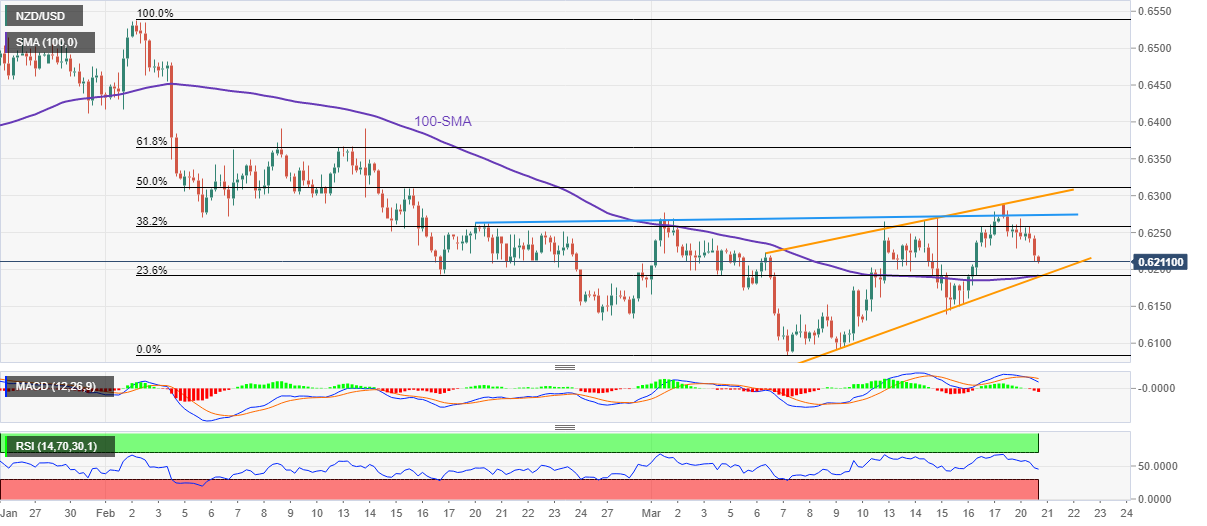
Trend: Further downside expected
- USD/CAD renews intraday high while bouncing off one-week low ahead of key Canada data.
- Mixed sentiment, hawkish Fed bets allow US Dollar to pare recent losses.
- WTI crude oil fades bounce off the lowest levels since December 2021.
- BoC CPI appears crucial for Loonie pair buyers ahead of Fed meeting.
USD/CAD picks up bids to refresh daily top around 1.3690, extending the early Asian session bounce off a one-week low heading into Tuesday’s European session. In doing so, the Loonie pair cheers the downbeat price of Canada’s main export earner, namely WTI crude oil, while also justifying the latest recovery of the US Dollar, ahead of the nation’s key inflation data for February.
WTI holds lower ground near the intraday bottom surrounding $67.20 as it retreats towards the 24-month low marked the previous day. Looming fears from the banking sector fallout join the US Dollar rebound in weighing on the black gold prices.
That said, US Dollar Index (DXY) bounces off the lowest levels since early February, marked the previous day, while snapping a three-day downtrend, mildly bid around 103.40 by the press time. In doing so, the greenback’s gauge versus the six major currencies traces the late Monday’s recovery in the US Treasury bond yields, as well as the hawkish Fed bets, to tease buyers.
Although the policymakers’ efforts to tame the banking crisis joined the UBS-Credit Suisse deal to weigh on the US Dollar and previously favored the USD/CAD bears, the market’s indecision about the latest actions to defend the bank depositors seems to challenge the risk-on mood.
It should be noted that the Treasury bond yields remain inactive but keep the previous day’s bounce off multi-day low as the US 10-year and two-year Treasury bond yields recovered from the lowest levels since September 2022 on Monday. Furthermore, CME’s FedWatch tool mentions the probability of witnessing a 0.25% Fed rate hike on Wednesday as near 75%, up from the last week’s 65%.
Against this backdrop, S&P 500 Futures print mild gains to portray cautious optimism even as traders struggle for clear directions.
Moving ahead, the Bank of Canada (BoC) Consumer Price Index (CPI) for February appears the key data for the USD/CAD pair traders to watch amid talks of a policy pivot.
Technical analysis
USD/CAD recovery fails to gain support from the MACD, as the oscillator keeps flashing bearish signals. Also testing the Loonie pair buyers is a seven-day-old descending resistance line near 1.3745.
- Asian stocks have shown an overall recovery as institutions are making efforts to fade banking turmoil fears.
- Goldman Sachs has favored a steady Fed policy due to rising stress in the banking sector.
- Oil price has shown a recovery amid expectations of an OPEC intervention.
Markets in the Asian domain have shown an all-around recovery on Tuesday following the footprints of the S&P500. It seems that investors are cheering the attempts of reviving the collapsed banks. In Eurozone, UBS has agreed to acquire Credit Suisse for $3.2 billion in a rescue deal. And, various financial institutions have pumped $30 billion to save First Republic Bank.
Despite huge liquidity influx into First Republic Bank, Standard and Poor has downgraded the creditworthiness of the mid-side United States bank into deeper junk, citing that the promised helicopter money is unable to get the commercial bank out of trouble.
At the press time, ChinaA50 jumps 0.60%, Hang Seng inched up by 0.08%, KOSPI gained 0.31%, and Nifty50 added 0.36%.
Japanese markets are closed today on account of Vernal Equinox Day.
Rising uncertainty over the monetary policy announcement by the Federal Reserve (Fed) is squeezing volatility from the market. Fresh concerns about global banking turmoil are bolstering the case of an unchanged monetary policy stance. As per the CME Fedwatch tool more than 70% odds are favoring a 25 basis point (bps) interest rate hike on Wednesday. Contrary to that, Goldman Sachs is expecting a pause in the policy-tightening spell considering the stress in the banking system.
After an unchanged interest rate decision by the People’s Bank of China (PBoC), optimism for economic recovery is stemming again as retail demand and spending pattern is solidifying. Bloomberg reported that consumer spending is increasing again as people are planning trips, dining out, and returning to shopping malls. Still, residents of the world’s second-biggest economy aren’t splashing out like they used to. It would be worth calling that this just the beginning as spending patterns would bolster further as fears of a pandemic would fade further.
On the oil front, oil prices have recovered firmly after printing a fresh 15-month low below $65.00. The oil price is struggling to extend recovery above $68.00, however, the upside looks solid. A recovery in oil price has been observed amid expectations that OPEC might intervene to support prices.
- USD/JPY hovers near the 131.00 level with bearish bias ahead of a crucial Fed decision.
- US Dollar under pressure amid struggling global banking sector and excess liquidity.
- Investors brace for potential volatility as the market anticipates for 25 bps rate hike from Fed.
USD/JPY hovers around the 131.00 mark during Tuesday's Asian session, maintaining its bearish bias.
Although US Treasury (UST) bond yields received a boost on Monday, USD/JPY failed to capitalize significantly. This can be attributed to the struggling global banking sector, as many commercial banks began to falter last week. Consequently, investors rushed to purchase UST bonds, causing yields to decline.
USD/JPY closely follows the UST yield direction, so it is unsurprising that the US Dollar remains under pressure. Earlier this week, the Federal Reserve restarted swap lines to provide US Dollar liquidity to central banks in need, in addition to the Fed's discount window. This rapid action has flooded the market with excess US Dollar liquidity, resulting in widespread weakness.
As the market heads toward Wednesday's FOMC meeting, caution is advised. The global banking system is already strained, and a further increase in borrowing costs could exacerbate existing issues. The market anticipates a 25 basis point (bps) rate hike from the Fed.
Trading during the FOMC event requires extra caution, as this meeting is not a typical one with pre-set expectations. With investors divided over various variables, volatility is expected. It is always recommended to be especially careful, as the market could reverse during the press conference.
It is crucial to pay attention to Fed Chair Jerome Powell's press conference, as the media will scrutinize his statements for any unexpected comments that could trigger market volatility.
Levels to watch
- USD/CHF grinds higher after positing the first daily gains in three.
- US policymakers’ discussion on bank deposit insurance allows markets to remain optimistic.
- Yields rebound amid hawkish Fed bets, mixed feelings about banking sector fallout.
- Swiss trade numbers, US housing data can entertain intraday traders.
USD/CHF picks up bids to refresh intraday high as it extends the previous day’s gains, the first in three, to 0.9300 during early Tuesday morning in Europe.
The Swiss Franc (CHF) pair’s latest rebound could be linked to the US Dollar’s corrective bounce off the five-month low amid hawkish Fed bets. However, cautious optimism surrounding the latest banking industry updates, following a debacle in the US and Europe.
US Dollar Index (DXY) bounces off the lowest levels since early February, marked the previous day, while snapping a three-day downtrend, mildly bid around 103.40 by the press time. In doing so, the greenback’s gauge versus the six major currencies traces the late Monday’s recovery in the US Treasury bond yields, as well as the hawkish Fed bets, to tease buyers ahead of the key Federal Open Market Committee (FOMC) Monetary Policy Meeting, up for release on Wednesday.
That said, the Treasury bond yields remain inactive but keep the previous day’s bounce off multi-day low as the US 10-year and two-year Treasury bond yields recovered from the lowest levels since September 2022 on Monday. Furthermore, CME’s FedWatch tool mentions the probability of witnessing a 0.25% Fed rate hike on Wednesday as near 75%, up from the last week’s 65%.
Alternatively, a headline from Bloomberg suggests relief for the traders amid the impending banking crisis, which in turn challenges the US Dollar’s haven demand and may test the USD/CHF upside. “US officials are studying ways they might temporarily expand Federal Deposit Insurance Corporation (FDIC) coverage to all deposits, a move sought by a coalition of banks arguing that it’s needed to head off a potential financial crisis,” reported Bloomberg. The news quotes anonymous people with knowledge of the talks saying, “Treasury Department staff are reviewing whether federal regulators have enough emergency authority to temporarily insure deposits greater than the current $250,000 cap on most accounts without formal consent from a deeply divided Congress.”
It should be noted that the fears of the FDIC’s inability to cover the US bank deposits, due to the limitations of funds in the reserve, join the doubts surrounding the UBS-Credit Suisse deal to probe the risk-on mood amid a sluggish Asian session.
Amid these plays, S&P 500 Futures print mild gains to portray cautious optimism.
Looking ahead, February month trade numbers from Switzerland will precede the US second-tier housing data to entertain intraday USD/CHF traders. However, major attention will be given to the Fed versus Swiss National Bank (SNB) play as the latter previously advocated policy pivot.
Technical analysis
A two-week-old descending resistance line challenge USD/CHF bulls around 0.9300.
- EUR/USD is displaying a sideways auction around 1.0720 as investors await Fed policy for fresh guidance.
- Federal Reserve could remain shy of hiking rates further to tame the consequences of the banking sector debacle.
- European Central Bank is likely to remain stick to bigger rates spell as inflation would remain higher for a longer period.
- EUR/USD is marching towards the potential resistance plotted from March around 1.0740.
EUR/USD is continuously juggling in a narrow range above the round-level support of 1.0700 in the Asian session. It seems that investors have been sidelined ahead of the interest rate decision by the Federal Reserve (Fed). Therefore, the major currency pair is mimicking the pre-Fed policy period and is likely to continue its sideways performance.
S&P500 futures are adding further gains, carry forwarding the recovery performance on Monday as investors cheered liquidity assistance from various financial institutions to First Republic Bank after solvency issues. It seems that investors are showing maturity in efforts made for easing financial instability, portraying a recovery in the risk appetite theme.
The US Dollar Index (DXY) is also demonstrating a lackluster performance around 103.30 as the street looks confused about the Federal Reserve’s monetary policy. The commentary has come from Futuristic carmaker Elon Musk that the Federal Reserve should cut interest rates by at least 50 basis points (bps). The rationale behind the commentary could be an expected recession due to sheer policy tightening.
Meanwhile, demand for US government bonds still looks weak as the return offered looks solid at higher levels. The 10-year US Treasury yields have been recorded at 3.5%, at the time of writing. Yields have been supported after the promise of a liquidity influx of $30 billion by various financial institutions to support the First Republic Bank.
Investors look ambiguous over Fed policy
Inflation in the United States is still stubborn despite the case of the declining trend for the past few months. Therefore, the Federal Reserve (Fed) is expected to continue its policy-tightening cycle to bring down inflationary pressures to the desired levels. However, fresh evidence of banking sector shakedown has alarmed that the United States economy could face a deep recession. Higher inflationary pressures would join hands with the banking sector fiasco, which would impact the scales of economic activities dramatically.
Apart from the interest rate policy, Federal Reserve chair Jerome Powell would also deliver the dot plot plan, a roadmap dictating further rate hikes to achieve price stability. The Federal Reserve is still sticking to its prior terminal rate projection of around 5.25%, therefore, no surprises are expected for the interest rate guidance.
ECB Lagarde escalates fears of higher inflation projections
The Euro remained extremely active on Monday amid the commentary from European Central Bank (ECB) President Christine Lagarde. European Central Bank Lagarde confirmed that Eurozone inflation would remain higher for a longer period and shifted the blame to rising wage pressures. She reiterated that wage pressures have strengthened on the back of robust labor markets and added that employees are aiming to recoup some of the purchasing power.
Upward guidance on Eurozone inflation has strengthened the case for the continuation of bigger rates from the European Central Bank. Investors should be aware that the European Central Bank hiked its interest rates by 50 bps to 3.5% last week despite the demise of Credit Suisse.
Apart from that, investors were curious about the exposure of Eurozone banks to the Credit Suisse debacle. On which, European Central Bank Lagarde claimed that Eurozone banks' exposure to Credit Suisse was in Euro millions, not billions, per Reuters.
EUR/USD technical outlook

EUR/USD has displayed sheer strength after a Triple Bottom formation on an hourly scale. A Triple Bottom is a bullish reversal chart pattern that indicates an absence of selling pressure in the major currency pair while testing previous lows. The shared currency pair is marching towards the potential resistance plotted from March 15 high at 1.0740.
Upward-sloping 20-and 50-period Exponential Moving Averages (EMAs) at 1.0710 and 1.0687 respectively add to the upside filters.
Meanwhile, the Relative Strength Index (RSI) (14) is oscillating in the bullish range of 60.00-80.00, which indicates that the upside momentum is active.
- USD/INR struggles with 83.00 resistance amid Indian Rupee’s bearish pressure.
- The pair is awaiting for the subsequent directional bias as the FOMC meeting approaches.
- RSI points to further upside potential for USD/INR.
USD/INR has been unable to break through the resistance zone around the 83.00 level, despite four attempts on the daily chart. The synchronized US Dollar weakness is not reflected in this pair, indicating that the Indian Rupee is facing strong bearish pressure.
The technical outlook suggests that both the 21-Day Moving Average (DMA) and 50-DMA are providing support, positioned just below the current quote of 82.53 as of now.
USD/INR is poised to test the 83.00 level for the fifth time, maintaining the bullish bias for the pair. The ascending trendline indicates that upside price pressure is building. The upcoming FOMC meeting will be crucial for determining whether the pair surpasses the key psychological level of 83.00 or faces rejection once more.
Any downward movement is likely to be limited by the 21-DMA, pegged at the previous day's low of 82.42. A break below this level would be further restrained by the 50-DMA, currently at 82.15.
The last line of support will be the ascending trendline that starts from September's low of 79.04, intersecting the March low at the psychological level of 81.50.
The Relative Strength Index (RSI) signals higher highs and supports further upside potential for the pair.
USD/INR: Daily chart
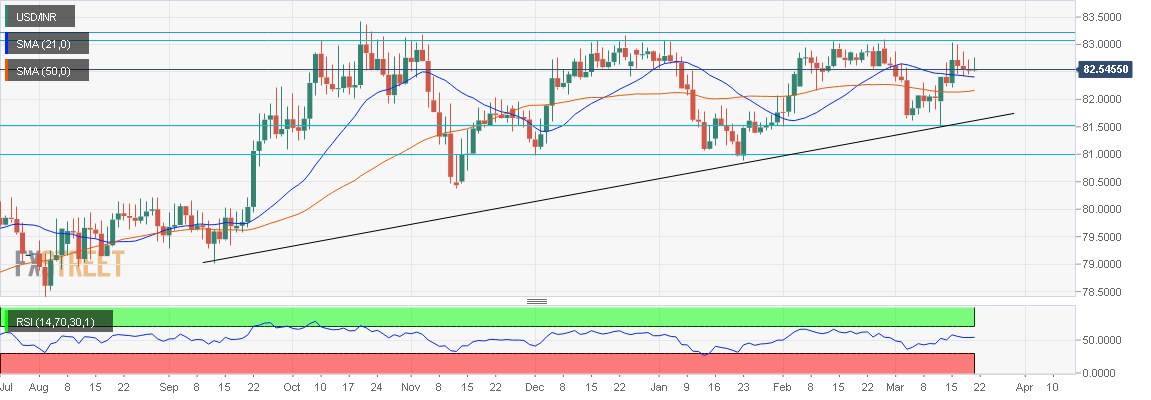
- AUD/USD holds lower grounds near intraday bottom after reversing from 21-EMA.
- Trendline breakout, bullish MACD signals favor buyers despite the latest retreat.
- Bulls need validation from 0.6780-85 resistance confluence to retake control.
AUD/USD prints the first daily loss in four around 0.6700 during early Tuesday morning in Europe as the 21-day Exponential Moving Average (EMA) challenges the buyers.
Even so, the Aussie pair’s successful trading beyond the previous resistance line from early February, near 0.6625 by the press time, join the bullish MACD signals to keep the buyers hopeful.
That said, a clear upside break of the 21-EMA, around 0.6720 by the press time, could direct the AUD/USD buyers towards the 0.6780-85 resistance confluence including 100-EMA, 50-EMA and 38.2% Fibonacci retracement of October 2022 to February 2023 upside.
Hence, the AUD/USD pair appears to remain sidelined between 0.6780-85 resistance and 0.6625 resistance-turned-support line.
It should be noted that a sustained break of 0.6785 could aim for the mid-February high surrounding 0.7030 wherein the 0.7000 round figure and early February’s low of 0.6855 may act as buffers.
Alternatively, a downside break of the stated trend line support, previous resistance around 0.6625, may aim for the 0.6600 round figure before approaching the monthly low of 0.6564.
Even if the quote drops below 0.6564, the 61.8% Fibonacci retracement, also known as the golden Fibonacci ratio, could challenge the AUD/USD bears around 0.6545.
To sum up, AUD/USD is likely to grind higher despite the latest retreat.
AUD/USD: Daily chart
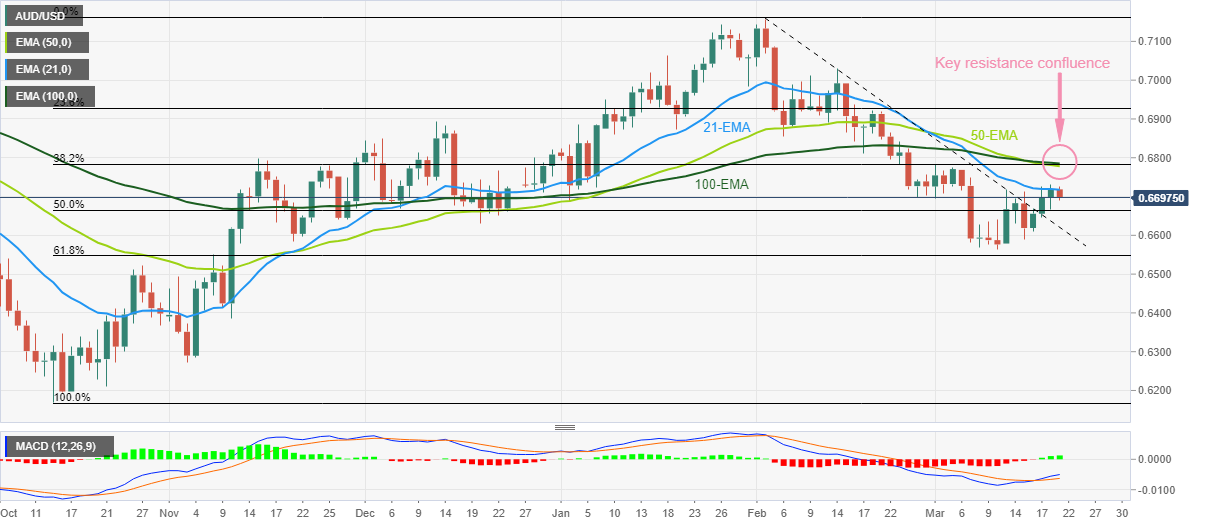
Trend: Recovery expected
- Gold price struggles to reverse the previous day’s pullback from YTD top.
- Mixed headlines about banking crisis, cautious mood ahead of key central bank events probe XAU/USD traders.
- Rebound in yields, hawkish Fed bets probe Gold buyers ahead of FOMC.
- XAU/USD bears need validation from $1,960 support confluence, Fed’s hawkish bias.
Gold price (XAU/USD) regains upside momentum, following the pullback from a Year-To-Date (YTD) high, amid cautious optimism surrounding the banking sector. Adding strength to the recovery moves could be the market’s inaction amid the Japanese holiday, as well as the failures on the part of the US Treasury bond yields to extend the recent corrective bounce off a six-month low.
Headlines suggesting the US policymakers’ search for ways to insure all banking deposits join the UBS-Credit Suisse deal and major central banks’ rush to keep the markets liquid with the US Dollar flow seem to favor the Gold buyers.
It’s worth noting, however, that the latest read of the CME’s FedWatch tool mentions the probability of witnessing a 0.25% Fed rate hike on Wednesday as near to 75%, up from the last week’s 65%, which in turn allows the US Treasury bond yields to rebound. That said, Treasury bond yields remain inactive as Japan’s holidays limited bond trading in Asia. It’s worth noting that the US 10-year and two-year Treasury bond yields bounced off the lowest levels since September 2022 the previous day.
Moving on, Fed’s reaction to the banking crisis will be crucial for Gold traders to watch as the 0.25% rate hike is already given. Should the dot-plot tease policy pivot, the US Dollar can have a further downside to trace, which in turn can propel the XAU/USD price.
Also read: Gold Price Forecast: XAU/USD grinds beyond $1,940 support, banking crisis, Federal Reserve in focus
Gold Price: Key levels to watch
As per Technical Confluence Detector, Gold price trades successfully beyond the $1,960 support confluence, despite the latest inaction, which in turn keeps the XAU/USD buyers hopeful. That said, the stated key support comprises Fibonacci 23.6% on one-week, previous monthly high and Pivot Point one-day S1.
That said, Fibonacci 23.6% on one-day and 50-HMA levels restrict immediate downside of the Gold price near $1,976 and $1,965-66 in that order. It's worth mentioning that the $1,940 acts as the key downside support, apart from the $1,960, which could challenge the XAU/USD bears.
Meanwhile, the previous weekly high surrounding $1,990 can act as an immediate resistance before highlighting the $2,000 threshold.
In a case where the Gold price remains firmer past $2,000, Pivot Point one-day R1 can act as a validation point for the further run-up near $2,005 before fueling the XAU/USD towards 2022’s peak of $2,070.
Here is how it looks on the tool
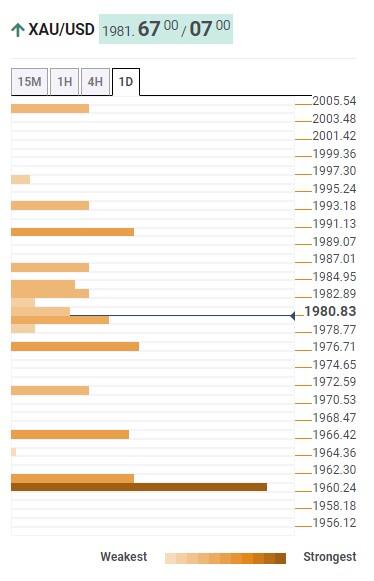
About Technical Confluences Detector
The TCD (Technical Confluences Detector) is a tool to locate and point out those price levels where there is a congestion of indicators, moving averages, Fibonacci levels, Pivot Points, etc. If you are a short-term trader, you will find entry points for counter-trend strategies and hunt a few points at a time. If you are a medium-to-long-term trader, this tool will allow you to know in advance the price levels where a medium-to-long-term trend may stop and rest, where to unwind positions, or where to increase your position size.
- WTI takes offers to refresh intraday low, reverses the previous day’s bounce off the lowest levels since December 2021.
- US Dollar Index licks its wounds near five-week low, traces rebound in yields.
- Market players remain cautious amid banking sector fallout, hawkish Fed bets.
- Receding optimism surrounding China, cautious mood ahead of API inventories favor Oil bears.
WTI crude oil renews its intraday low near $67.30 while reversing the previous day’s corrective bounce off a 27-month low during early Tuesday. In doing so, the black gold takes clues from the US Dollar’s rebound, as well as a corrective bounce in the US Treasury bond yields.
That said, the US Dollar Index (DXY) prints the first daily gains around 103.35 as the greenback bears lick their wounds after a three-day losing streak. That said, Treasury bond yields remain inactive as Japan’s holidays limited bond trading in Asia. It’s worth noting that the US 10-year and two-year Treasury bond yields bounced off the lowest levels since September 2022 the previous day.
It should be noted that the market’s failure to cheer the risk-on mood contrasts with the headlines suggesting an ongoing discussion about deposit guarantees in the US banks and challenging the WTI crude oil traders.
Also important to note is the lack of risk-positive statements from China, as well as hopes of more Oil output, due to US President Biden’s readiness for releasing the Strategic Petroleum Reserve (SPR) on need. It’s worth noting that Saudi Arabia’s support to the OPEC+ supply-cut accord and hopes for more energy demand in the years to come, as per the latest energy demand forecasts from the Organization of the Petroleum Exporting Countries and Russia, known as OPEC+, as well as the US Energy Information Administration.
Above all, recently promising hawkish Fed bets and fears of a banking crisis weigh on the WTI crude Oil prices ahead of the weekly release of industry inventories, from the American Petroleum Institute (API).
Technical analysis
Although the oversold RSI triggered WTI crude oil’s recovery from a multi-month low, the recovery remains elusive unless crossing the December 2022 low of nearly $70.30.
| Raw materials | Closed | Change, % |
|---|---|---|
| Silver | 22.538 | -0.45 |
| Gold | 1978.88 | -0.35 |
| Palladium | 1413.11 | -0.59 |
- USD/MXN picks up bids to reverse the previous day’s pullback from six-week high.
- Convergence of 100-HMA, 50-HMA challenges Mexican Peso pair buyers.
- Mexican markets are off due to Benito Juarez's Birthday.
- Looming bull cross on MACD, steady RSI keeps buyers hopeful.
USD/MXN consolidates the previous day’s losses from a 1.5-month high during a sluggish Tuesday morning as Mexican Peso traders celebrate Benito Juarez's Birthday. That said, the pair remains mildly bid near 18.84 by the press time.
In doing so, the Mexican Peso pair pokes a convergence of the 50-Hour Moving Average (HMA) and the 100-HMA.
It should be noted, however, that the impending bull cross on the MACD and steady RSI (14) keeps USD/MXN buyers hopeful of crossing the 18.85 key resistance confluence.
Following that, the 19.00 threshold may act as an intermediate halt during a likely run-up towards the latest peak of 19.23 and to the previous monthly high surrounding 19.30.
In a case where USD/MXN remains firmer past 19.30, bulls may find it difficult to cross the 19.60 and 19.90 levels marked in December 2022 before approaching the 20.00 psychological magnet.
On the contrary, pullback moves remain elusive until the USD/MXN pair stays beyond a one-week-old support line, close to 18.70 by the press time.
Even if the Mexican Peso pair breaks the aforementioned support line, the 200-HMA level of near 18.65 can prod the bears before giving them control.
USD/MXN: Hourly chart
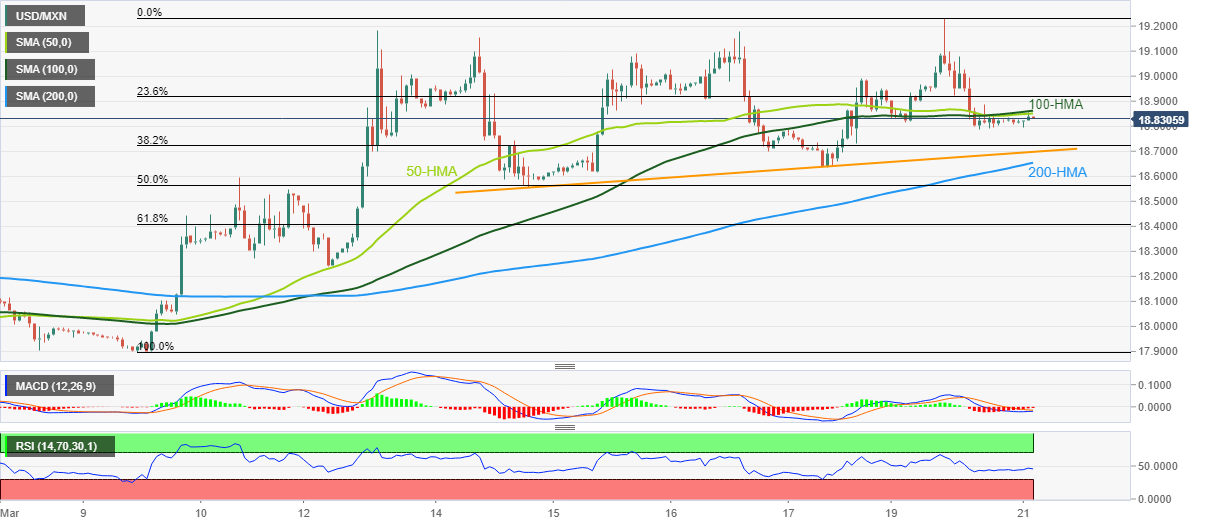
Trend: Further upside expected
- NZD/USD is under pressure as a group of republicans challenges universal federal guarantee.
- Investors cautious ahead of FOMC meeting: hike by 25bps or pause.
- RBNZ follows BoJ and declines Fed’s swap line offer.
NZD/USD is facing pressure as headlines report that hardline US Republicans are opposed to bank deposit guarantees beyond the $250,000 limit.
Some Republicans have suggested that the Federal Reserve (Fed) should unwind its extraordinary funding facilities, arguing that a universal guarantee on all bank deposits sets a dangerous precedent, encouraging future irresponsible behavior.
According to earlier reports, some banking groups have requested universal guarantees from the Federal Deposit Insurance Corp (FDIC) on all bank deposits due to deteriorating banking conditions. Bloomberg reported on Monday that US officials were considering expanding FDIC coverage to all deposits, a measure implemented during the 2008 crisis but now requiring congressional approval.
On Monday, markets were buoyed by various liquidity options, such as the swap line, the UBS-Credit Suisse merger, and the potential FDIC extension. However, it appears that the FDIC may struggle to cover all bank deposits, which could be a significant setback for depositors.
As the FOMC meeting approaches, investors remain divided on whether to expect a 25 basis point (bps) rate hike or a pause. Currently, the market is leaning towards a 25 bps increase.
Regarding the swap line opened by the Fed, the Reserve Bank of New Zealand (RBNZ) has followed the Bank of Japan (BoJ) in stating that there is no immediate need for it.
Earlier, New Zealand's Trade Balance data for February was released, with exports at $5.23 billion, down from $5.47 billion previously, and imports at $5.95 billion compared to $7.42 billion previously.
Levels to watch
- GBP/USD bears are testing prior equal highs level near 1.2270.
- A 61.8% Fibonacci is in focus which is near prior highs of 1.2200.
GBP/USD bulls are in the market but are meeting resistance above equal highs as for the prior analysis, GBP/USD Price Analysis: Bulls move towards bear´s lair.
GBP/USD prior analysis
It was noted that GBP/USD was on the backside of the bullish market but is riding a micro-bull trend for the time being. 1.2200 remains key in this regard.
It was stated that while holding above 1.2200, the focus is on the upside with the bulls taking on equal highs from February in the upper quarter of the

1.22 area. Eyes remain on the 1.2320s at this juncture.
However, still, if the bears move in, considering that the price is on the backside of the prior dominant bull trend, then there will be prospects of a break of the micro bull trend and structure in and around 1.2200.
GBP/USD update
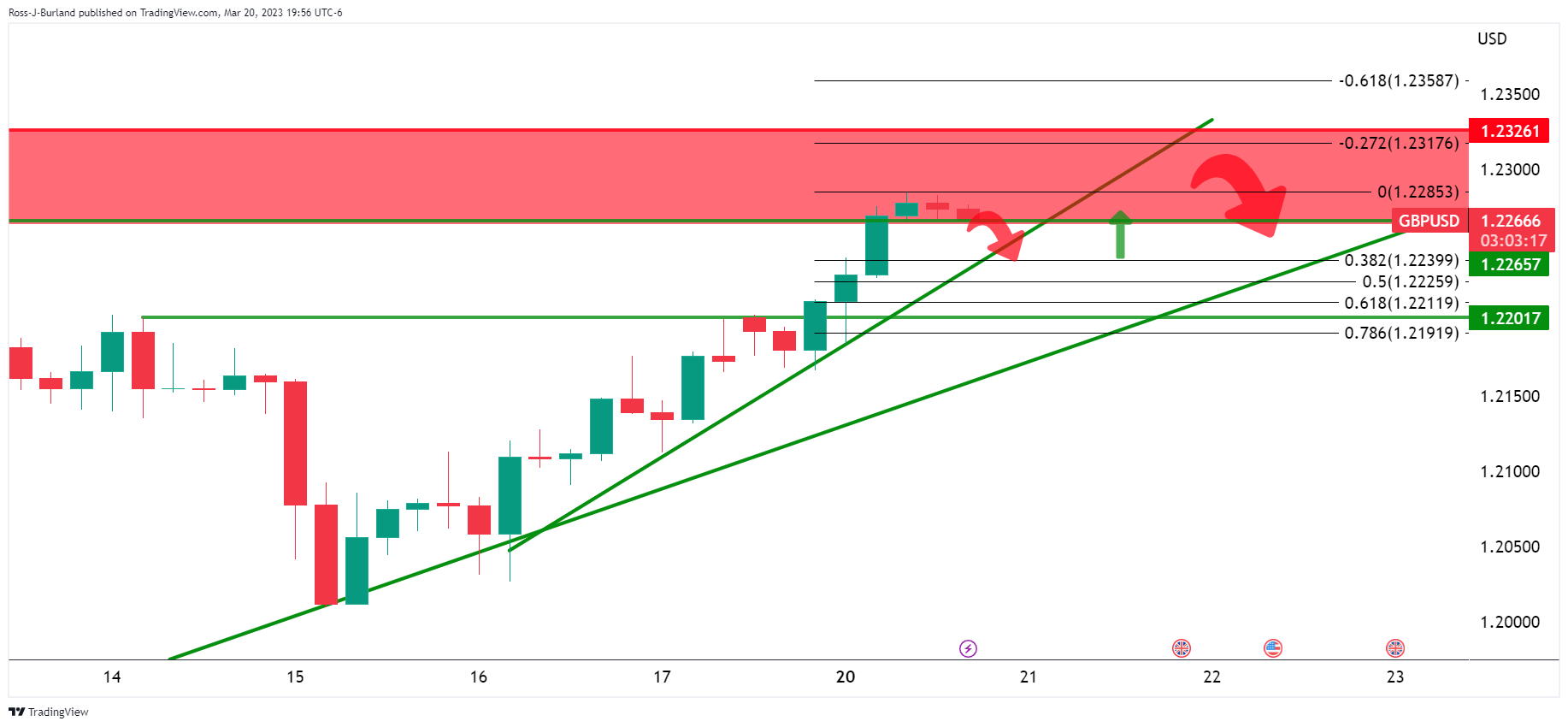
GBP/USD is testing a prior resistance and an equal highs level near 1.2270. A break of this will open the risk of a deeper correction of the prior H4 bullish impulse with the 61.8% Fibonacci in focus that is near prior highs of 1.2200.
- Market sentiment remains cautiously optimistic amid mixed headlines about banking crisis, Federal Reserve.
- Bloomberg reports that US Officials discuss ways to secure all bank deposits under FDIC.
- Doubts on the insurance coverage, hawkish Fed bets allowed yields to recover before Japan’s holiday restricted bond moves in Asia.
Market sentiment stays mixed during early Tuesday as the holiday in Japan restricts yields while the stock futures struggle to cheer hopes of deposit guarantee amid the looming banking crisis.
While portraying the mood, the S&P 500 Futures print mild gains around 3,990, after refreshing an eight-day high, whereas the Treasury bond yields remain inactive but keep the previous day’s bounce off multi-day low. That said, the US 10-year and two-year Treasury bond yields bounced off the lowest levels since September 2022 the previous day.
“US officials are studying ways they might temporarily expand Federal Deposit Insurance Corporation (FDIC) coverage to all deposits, a move sought by a coalition of banks arguing that it’s needed to head off a potential financial crisis,” reported Bloomberg. The news quotes anonymous people with knowledge of the talks saying, “Treasury Department staff are reviewing whether federal regulators have enough emergency authority to temporarily insure deposits greater than the current $250,000 cap on most accounts without formal consent from a deeply divided Congress.”
It should be noted that the fears of the FDIC’s inability to cover the US bank deposits, due to the limitations of funds in the reserve, join the doubts surrounding the UBS-Credit Suisse deal to probe the risk-on mood amid a sluggish Asian session.
Analysts at S&P think that it is unlikely that some US bank failures will prevent policymakers from sticking to the task of taming inflation, reported Reuters early Tuesday in Asia. The global rating agency also mentioned that the decision to write off Credit Suisse's AT1 bonds may contribute to a higher cost of capital for banks. On the same line were comments from a Senior Swiss lawmaker who warned on Monday that “the UBS-Credit Suisse merger is an enormous risk.”
That said, the latest read of the CME’s FedWatch tool mentions the probability of witnessing a 0.25% Fed rate hike on Wednesday as near to 75%, up from the last week’s 65%.
It’s worth noting that the sluggish markets allow the US Dollar to lick its wounds near the lowest level in five weeks while the Gold price renews upside momentum after retreating from the Year-To-Date (YTD) high the previous day.
Looking ahead, second-tier housing data from the US could join the risk catalysts to direct short-term market moves. However, major attention will be given to Wednesday’s Federal Open Market Committee (FOMC) Monetary Policy Meeting.
Also read: Forex Today: Currencies respond to improvement in market sentiment, Fed takes center stage
- Silver price is juggling around $22.60 as investors have sidelined ahead of Fed’s monetary policy.
- Investors have turned skeptical about whether the Fed would continue hiking rates further or choose silence this time.
- The street has cheered liquidity assistance from various financial institutions to support the First Republic Bank.
Silver price (XAG/USD) is juggling in a narrow range below $22.60 in the Tokyo session. The white metal recovered after a correction from $22.20 but failed to extend recovery as investors are uncertain about Wednesday’s interest rate decision by the Federal Reserve (Fed). Amid rising fears of banking turmoil, investors have turned skeptical about whether the Fed would continue hiking rates further or choose silence this time.
A recovery move by S&P500 indicates that investors have started digesting the volatility linked to the banking fiasco. S&P500 futures have extended gains further, portraying further improvement in the risk appetite of the market participants. It seems that investors have cheered liquidity assistance from various financial institutions, which have come forward to provide support to the First Republic Bank.
The US Dollar Index (DXY) has continued to remain choppy around 103.33 as investors have sidelined ahead of the Fed’s monetary policy. Analysts at ING believe “We do not expect too much volatility if conditions allow the Fed to hike 25 bps and the dot plots do not surprise too much and an unlikely 50 bps hike would be very bullish for the Dollar.”
Silver technical outlook
Silver price has sensed cushion around a minor inventory accumulation phase plotted near $22.20 on an hourly scale. The recovery move from the Silber price is expected to push it toward March 20 high around $22.72.
Advancing 20-and 50-period Exponential Moving Averages (EMAs) at $22.48 and $22.32 add to the upside filters.
The Relative Strength Index (RSI) (14) is gathering strength for climbing into the bullish range of 60.00-80.00. An occurrence of the same would strengthen the Silver price further.
Silver hourly chart
-638149594681264337.png)
In recent trade today, the People’s Bank of China (PBOC) set the yuan at 6.8763 vs. the last close of 6.8785 and the estimate at 6.8753.
About the fix
China maintains strict control of the yuan’s rate on the mainland.
The onshore yuan (CNY) differs from the offshore one (CNH) in trading restrictions, this last one is not as tightly controlled.
Each morning, the People’s Bank of China (PBOC) sets a so-called daily midpoint fix, based on the yuan’s previous day's closing level and quotations taken from the inter-bank dealer.
Bloomberg has published an article that describes the possibilities of how all bank deposits could be guaranteed if the crisis expands.
The article reads that ´´US officials are studying ways they might temporarily expand Federal Deposit Insurance Corp. coverage to all deposits, a move sought by a coalition of banks arguing that it’s needed to head off a potential financial crisis.´´
´´Treasury Department staff are reviewing whether federal regulators have enough emergency authority to temporarily insure deposits greater than the current $250,000 cap on most accounts without formal consent from a deeply divided Congress, according to people with knowledge of the talks.´´
Meanwhile, there are still concerns over regional US banks. First Republic shares tumbled as much as 50% on Monday and were last down about 39%. Additionally, the Bank of Canada, Bank of England, Bank of Japan, European Central Bank, Federal Reserve, and the Swiss National Bank are taking coordinated action to enhance the provision of liquidity via standing US Dollar liquidity swap line arrangements.
- USD/CAD rebound from one-week low, mildly bid of late.
- Convergence of three-month-old support line, 21-DMA puts floor under Loonie prices.
- Bearish MACD signals, descending resistance line from March 10 prod bulls.
USD/CAD renews its intraday high around 1.3680 as it pares the biggest daily loss in more than a week while bouncing off a multi-day-old support line, as well as from the 21-DMA, during early Tuesday.
It should, however, be noted that the recovery moves fail to gain support from the MACD, as the oscillator keeps flashing bearish signals. Also testing the Loonie pair buyers is a seven-day-old descending resistance line near 1.3745.
Even if the quote rises past the 1.3745 hurdle, multiple resistances between 1.3750-60 can challenge the USD/CAD buyers before directing them to the monthly high surrounding 1.3865, a break of which opens the door for the pair’s run-up towards the previous yearly top of 1.3977.
On the contrary, the 21-DMA and a three-month-old support line, respectively near 1.3670 and 1.3660, restrict short-term USD/CAD downside.
In a case where the Loonie pair provides a daily closing below 1.3660, a slump toward the monthly low of 1.3555 can’t be ruled out. Though, the 1.3600 round figure may act as an intermediate halt during the anticipated fall.
Should the USD/CAD bears keep the reins past 1.3555, the late January swing high around 1.3520 appears the last defense of the pair buyers.
Overall, USD/CAD remains bearish despite the latest recovery moves.
USD/CAD: Daily chart
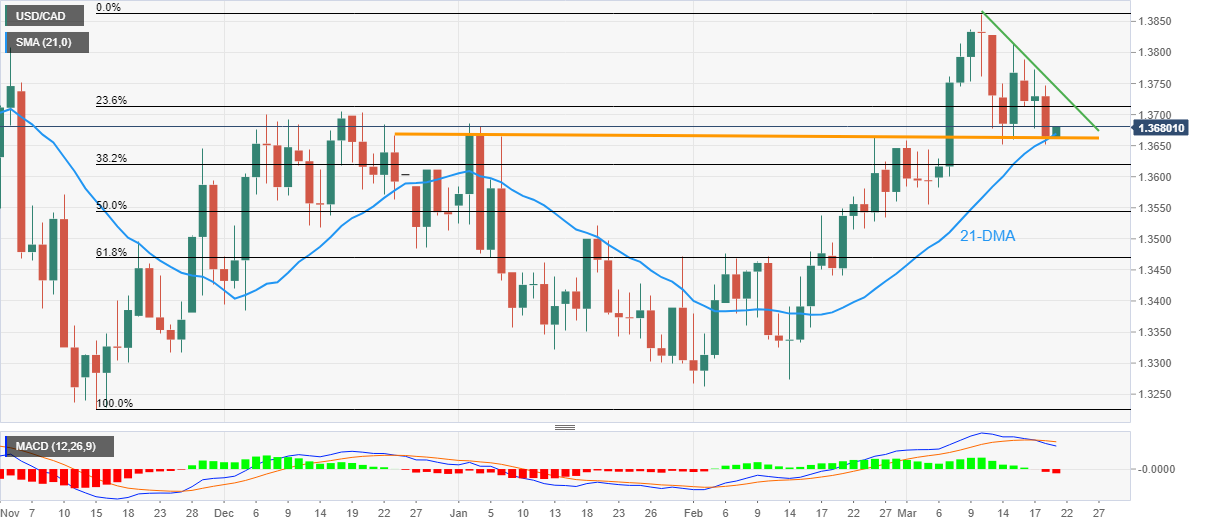
Trend: Limited recovery expected
- EUR/USD maintains bullish momentum amid falling US Treasury yields.
- Key resistance and support levels to watch as investors await the Fed meeting.
- EUR/USD knocking the trio junction: A combination of resistance.
EUR/USD has maintained its bullish bias for the past three days, driven by renewed pressure on the US Dollar due to falling US Treasury (UST) bond yields. A shift in interest rate repricing has caused the UST yield to enter a corrective decline.
The three-day bullish rally for EUR/USD has led to a retest of the descending trendline that originates from February's high at the 1.1036 level.
The descending trendline intersects the 38.2% Fibonacci level at the 1.0720 mark, which also coincides with the 50-Day Moving Average (DMA). This convergence of factors creates a significant and challenging resistance.
A decisive break above this level could propel the price towards a series of resistances, starting with last week's high at 1.0753, followed by the 50% Fibonacci level. The final line of resistance would be the 61.8% Fibonacci level.
Any pullback is likely to be limited around the 23.6% Fibonacci level, which coincides with the 21-DMA. A convincing break below this point could send EUR/USD down to the multi-month low of 1.0525, which also serves as the last line of support.
As we approach an important Fed meeting, it is not uncommon for investors to be polarized regarding policy decisions. Consequently, the pair is likely to tread water ahead of the event. All crucial levels will remain on the watchlist, as volatility is expected during the FOMC policy decision.
EUR/USD: Daily chart
-638149569731438083.png)
- AUD/USD has slipped firmly to near 0.6700 as RBA considered only 25 bps a viable option for March’s monetary policy.
- Recent upbeat Australian employment figures have conveyed that the fight against sticky inflation is extremely complicated.
- After the collapse of three mid-size US commercial banks, Fed is required to revive the confidence of investors.
The AUD/USD pair has slipped to near 0.6705 amid the release of the less hawkish Reserve Bank of Australia (RBA) minutes. The Board reiterated that further tightening of the POLICY would likely be required given inflation was still too high, the labor market tight and business surveys showed solid activity. RBA policymakers considered only a 25 basis points (bps) rate hike as a viable option for March’s monetary policy.
Investors should be aware of the fact that RBA Governor Philip Lowe hiked its Official Cash Rate (OCR) by 25 bps consecutively for the fifth time to 3.60%. Also, it was the 10th consecutive interest rate hike by the RBA in its battle against stubborn inflation.
Recent upbeat Australian employment figures have conveyed that the fight against sticky inflation is extremely complicated and RBA policymakers are still required to take tough decisions in times when inflation uncertainty has joined fears of a global banking meltdown.
S&P500 futures have extended Monday’s gains in the Asian session as investors have ignored the fears associated with upcoming monetary policy by the Federal Reserve (Fed), portraying further enhancement in the risk appetite of the market participants.
The US Dollar Index (DXY) has continued to remain sideways around 103.30 as investors are anticipating a less hawkish monetary policy and interest rate guidance. After the collapse of three mid-size United States commercial banks, Fed chair Jerome Powell is required to revive the confidence of investors, which could be done by mild tweaks to the interest rate policy.
Meanwhile, the demand for US government bonds has weakened further as the collaborative effort of various central banks of providing liquidity assistance in the form of US Dollars for supporting commercial banks has escalated inflation expectations. This has led to a rise in the returns offers on US Treasury bonds. The 10-year US Treasury yields have jumped to 3.5%.
- USD/JPY bears are in the market and 131.20 is key in this regard.
- A breakout of the coiled market conditions could be on the cards.
As per the prior analysis, USD/JPY Price Analysis: Bulls need to show up or 131.00 is a viable target, the bears moved in to capitalize on failures to crack the trendline resistance.
USD/JPY prior analysis
It was stated that USD/JPY´s M-formation was pulling in the price to the neckline support and if the bears stuck around, then while being on the front side of the bear trend, 131.00 could easily come back under pressure for the days ahead:
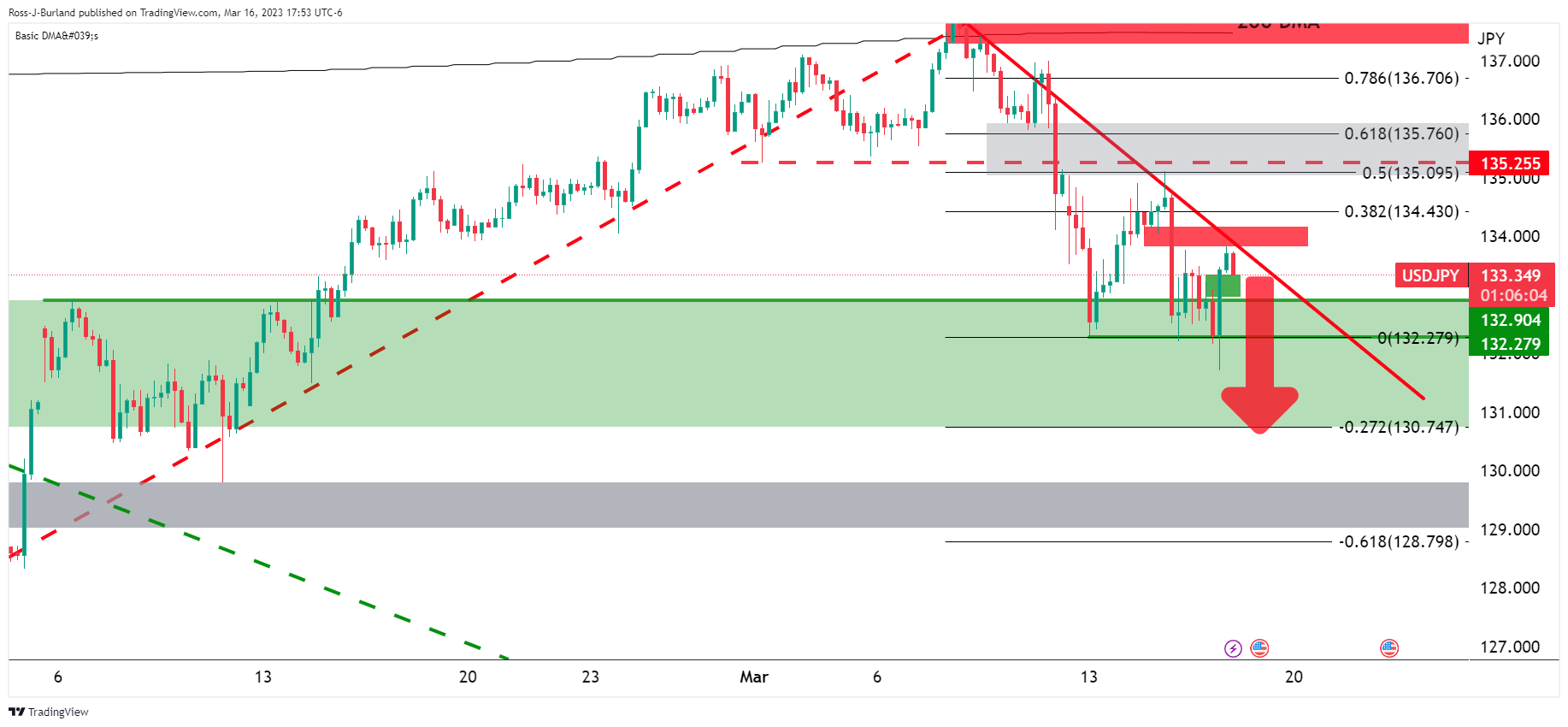
USD/JPY update
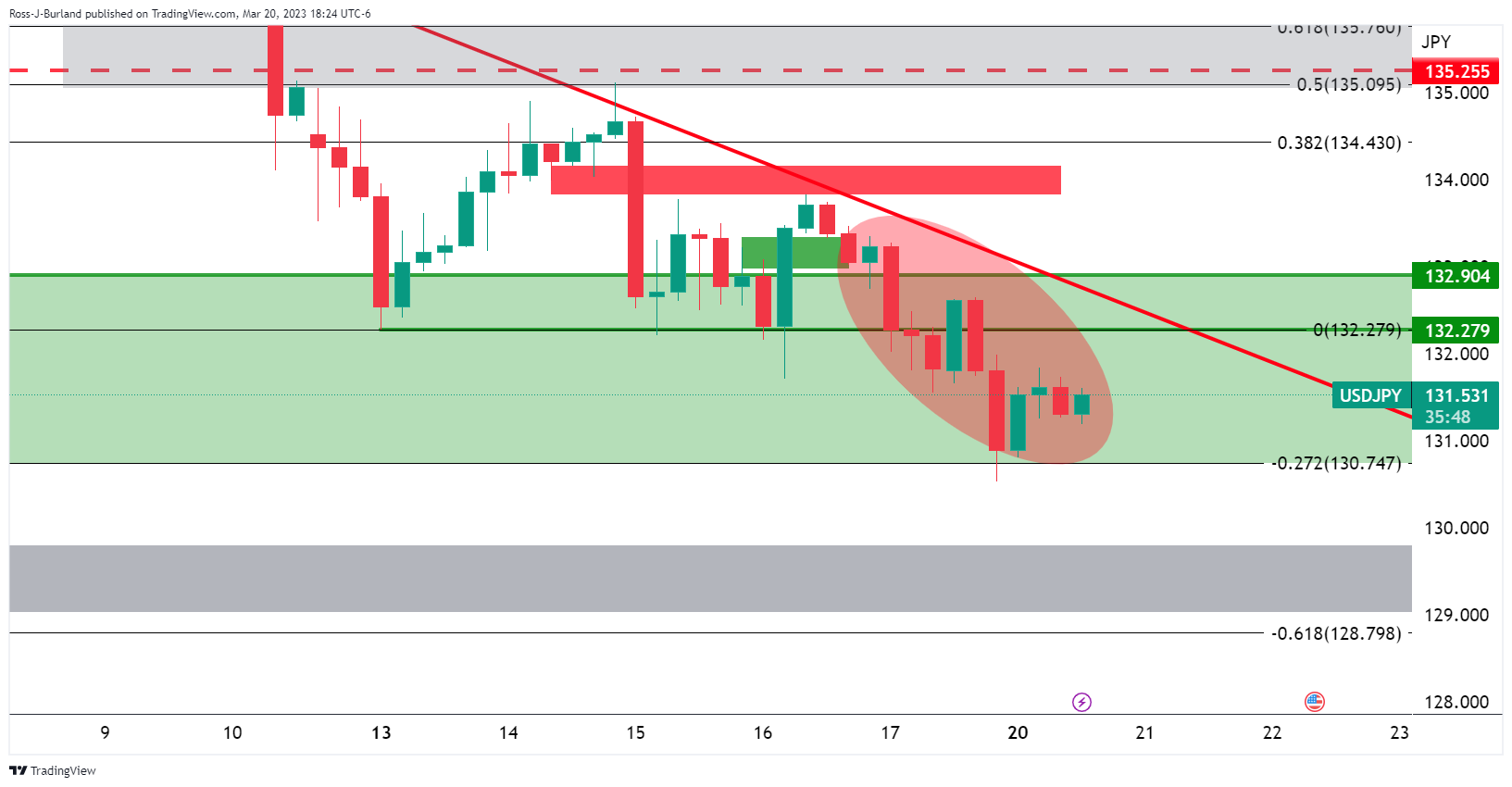
The market melted and is now correcting the move:
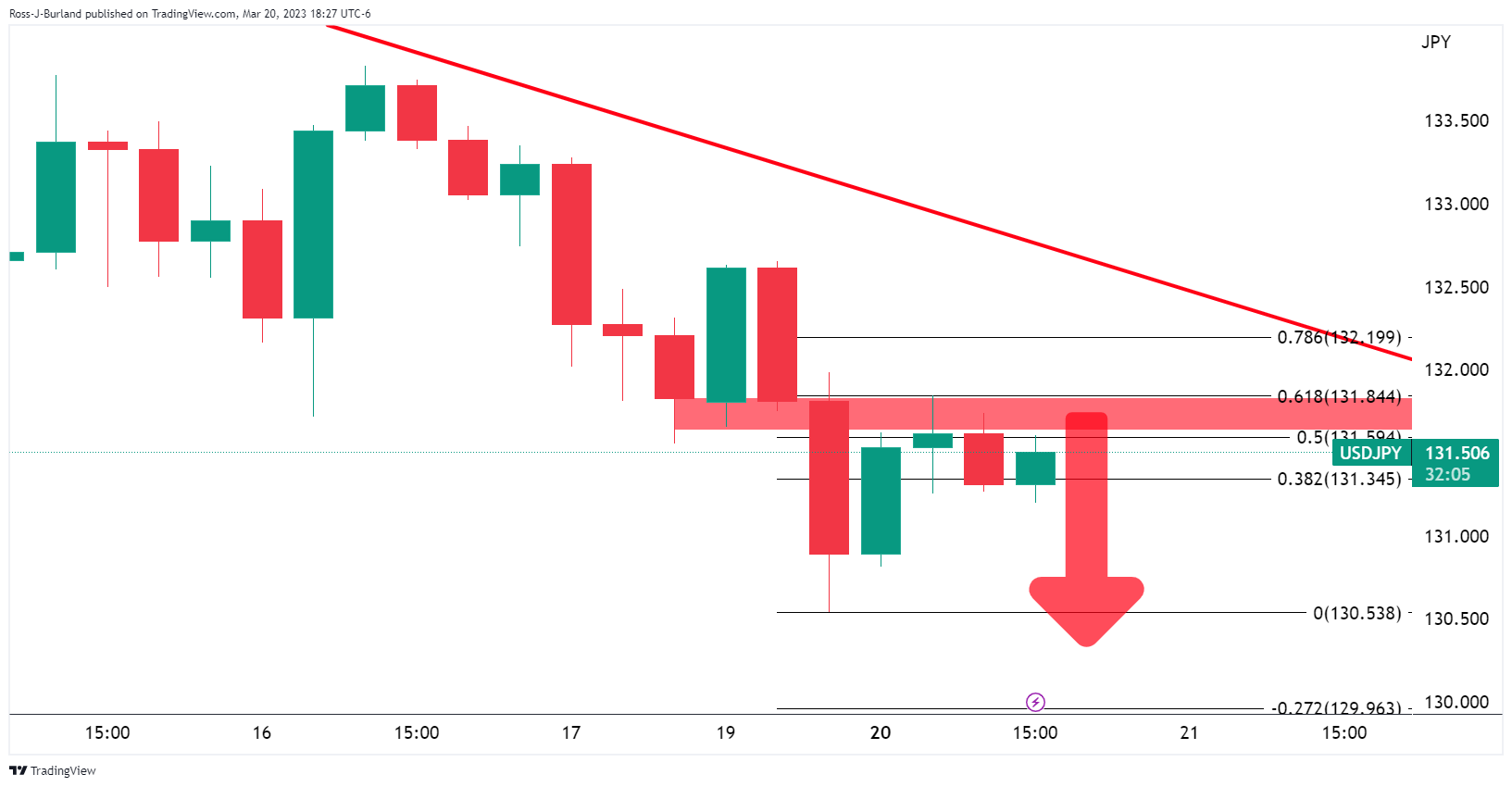
On an hourlñy basis, as per below, the market is coiled and a breakout to the downside could be in store:
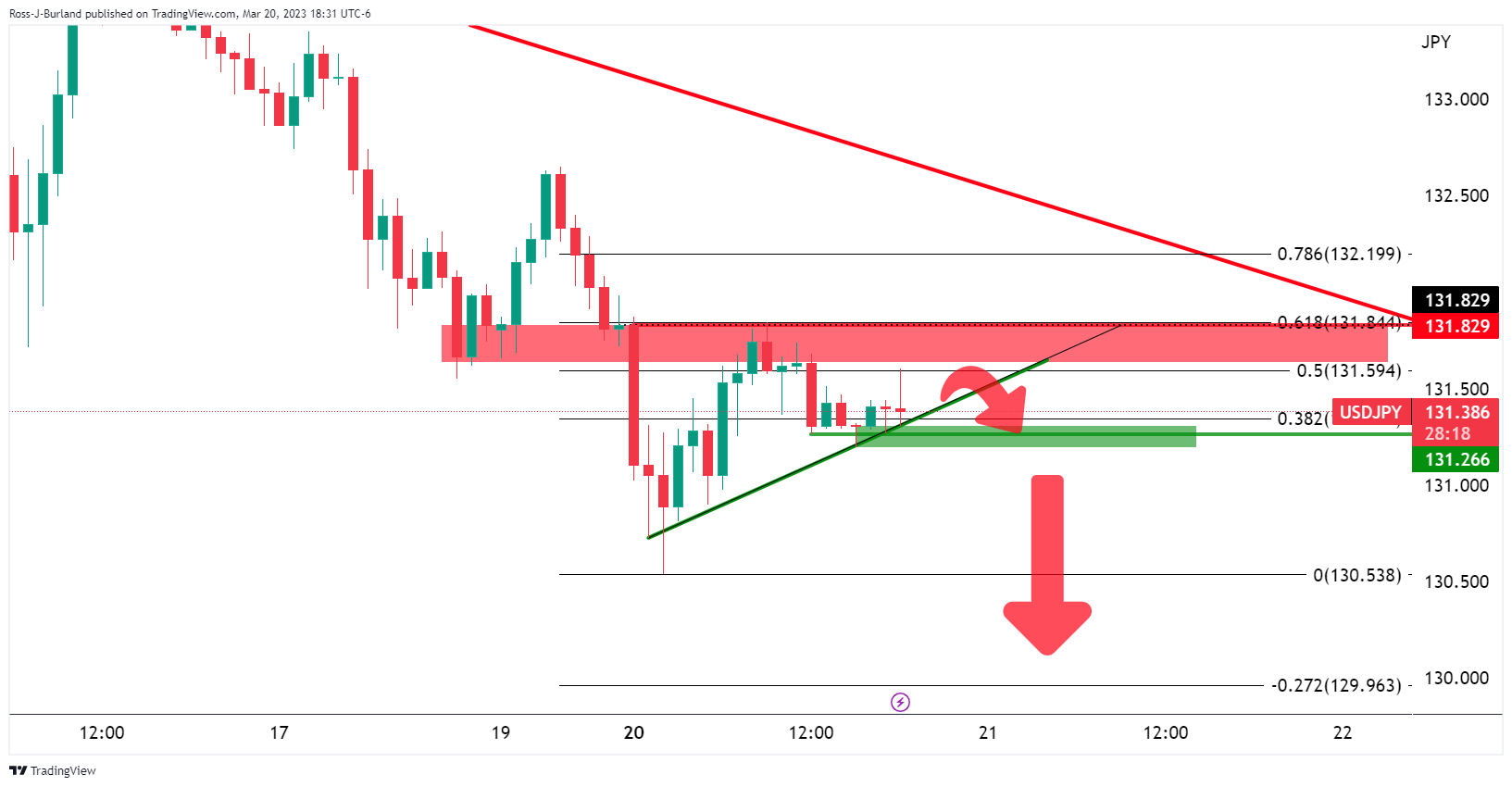
131.20 is key in this regard.
- AUD/JPY picks up bids to extend the previous day’s rebound from three-month low.
- RBA Minutes highlight the need for further monetary policy tightening.
- Yields recover amid mixed concerns about banking crisis, hawkish Fed bets.
AUD/JPY holds onto the previous day’s corrective bounce off a three-month low after the Reserve Bank of Australia’s (RBA) hawkish commentary, published early Tuesday morning in Asia. Adding strength to the cross-currency pair’s corrective bounce could be the latest recovery in the US Treasury bond yields amid mixed market sentiment.
As per the latest RBA Minutes, Further monetary policy tightening is expected to be required to bring inflation down. The statement also mentioned that a pause would allow time to examine the economy's prospects.
Also read: RBA: Further monetary policy tightening is expected to be required to bring inflation down.
On a different page, the mixed concerns around the banking turmoil challenge the previous risk-on mood and join the hawkish Fed bets to revive the US Treasury bond yields. That said, the US 10-year and two-year Treasury bond yields bounced off the lowest levels since September 2022 the previous day, mildly bid during the early Asian hours on Tuesday.
Talking about the risk, the UBS-Credit Suisse deal and the global central banks’ efforts to tame the liquidity crunch previously tamed the market’s pessimism. However, the details suggest no relief from the banking fallout and allow the yields to pare recent losses near the multi-day low.
Late Monday, analysts at S&P think that it is unlikely that some US bank failures will prevent policymakers from sticking to the task of taming inflation, reported Reuters early Tuesday in Asia. The global rating agency also mentioned that the decision to write off Credit Suisse's AT1 bonds may contribute to a higher cost of capital for banks. On the same line were comments from a Senior Swiss lawmaker who warned on Monday that “the UBS-Credit Suisse merger is an enormous risk.”
Amid these plays, the S&P 500 Futures print mild gains while tracking Wall Street’s performance.
Moving on, the cross-currency pair traders should pay attention to the risk catalysts and the US Treasury bond yields for fresh impulse.
Technical analysis
Nearly oversold RSI (14) challenges AUD/JPY bears even if a downside break of the three-month-old ascending trend line, close to 89.35 by the press time, keeps the pair sellers hopeful. That said, the late 2022 bottom surrounding 87.00 appears as the short-term key support.
The Reserve Bank of Australia minutes are out as follows:
Key notes
Minutes of the March 7 policy meeting out on Tuesday showed the Reserve Bank of Australia's (RBA) Board only discussed raising the cash rate by 25 basis points to 3.6%, compared with weighing between 25 bps and 50 bps hikes in February.
Monetary policy was already in restrictive territory and the economic outlook was uncertain.
Members "agreed to reconsider the case for a pause at the following meeting, recognising that pausing would allow additional time to reassess the outlook for the economy," according to the minutes.
- Further monetary policy tightening is expected to be required to bring inflation down.
The Board reiterated that further tightening of the monetary would likely be required given inflation was still too high, the labor market tight and business surveys showed solid activity.
The RBA noted that recent data releases on Gross Domestic Product, jobs, wages and inflation, had come in softer than expected, but the shortfalls to expectations were not large.
The Board said they would be watching upcoming releases on employment, inflation, retail trade and business surveys, as well as the developments in the global economy at the April meeting.
AUD/USD update
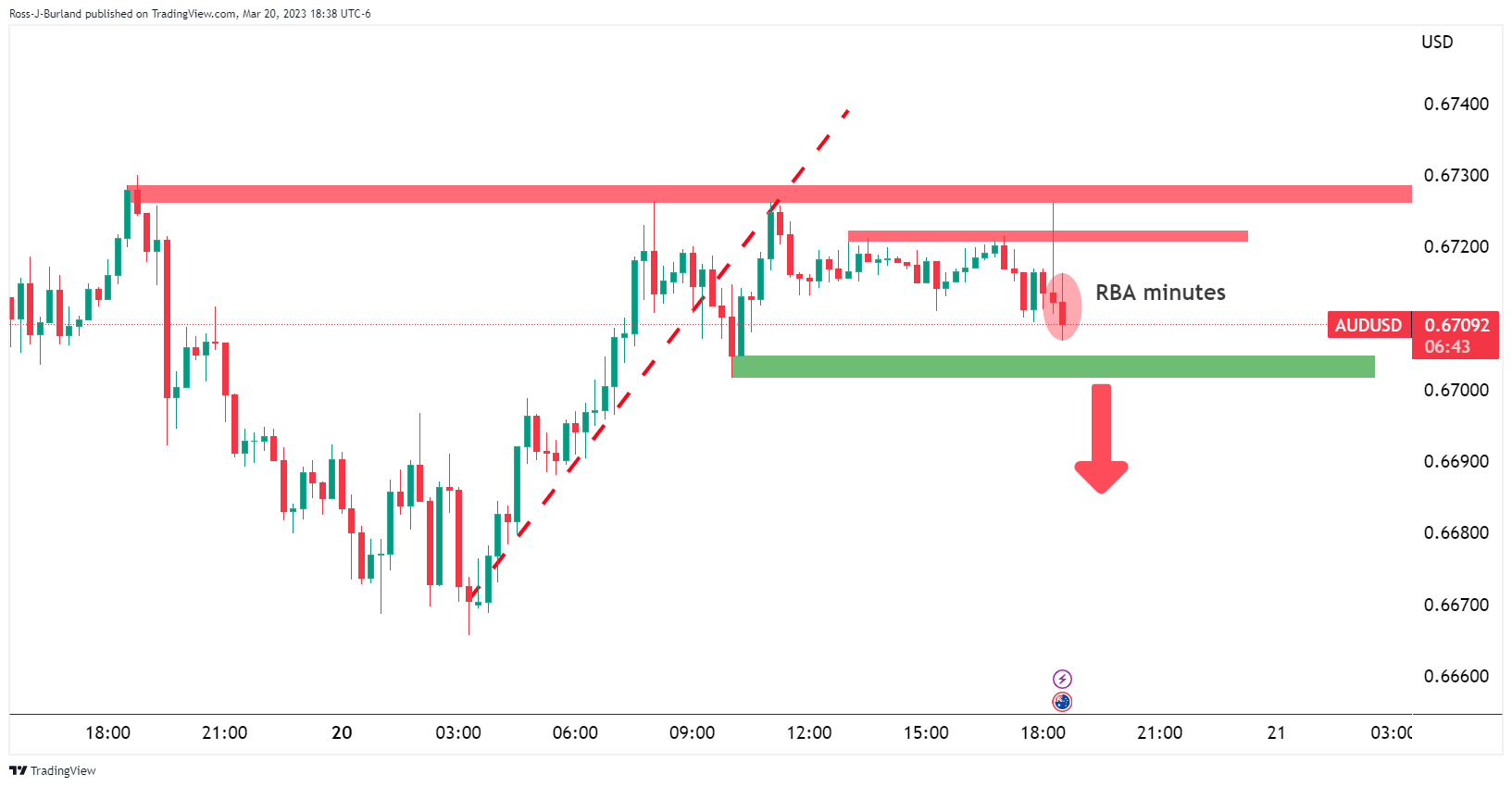
Governor Philip Lowe earlier this month said the central bank was closer to pausing its rate increases as policy was now in restrictive territory, and suggested a halt could come as soon as April depending on the data.
Why it matters to traders?
The Reserve Bank of Australia (RBA) publishes the minutes of its monetary policy meeting two weeks after the interest rate decision is announced. It provides a detailed record of the discussions held between the RBA’s board members on monetary policy and economic conditions that influenced their decision on adjusting interest rates and/or bond buys, significantly impacting the AUD. The minutes also reveal considerations on international economic developments and the exchange rate value.
| Index | Change, points | Closed | Change, % |
|---|---|---|---|
| NIKKEI 225 | -388.12 | 26945.67 | -1.42 |
| Hang Seng | -517.88 | 19000.71 | -2.65 |
| KOSPI | -16.49 | 2379.2 | -0.69 |
| ASX 200 | -96.3 | 6898.5 | -1.38 |
| FTSE 100 | 68.45 | 7403.85 | 0.93 |
| DAX | 165.18 | 14933.38 | 1.12 |
| CAC 40 | 90.3 | 7015.7 | 1.3 |
| Dow Jones | 382.6 | 32244.58 | 1.2 |
| S&P 500 | 34.93 | 3951.57 | 0.89 |
| NASDAQ Composite | 45.03 | 11675.54 | 0.39 |
- Gold price keeps the previous day’s pullback from YTD high, directionless of late.
- Corrective bounce in United States Treasury bond yields, hawkish Federal Reserve bets prod XAU/USD bulls.
- Banking crisis, successful break of the previous key resistance line favor Gold buyers.
Gold price (XAU/USD) struggles for clear directions around $1,980, following a pullback from the yearly high above $2,000, as markets slip into cautious mode ahead of the key data/events. Also challenging the Gold traders could be the recent rebound in the United States Treasury bond yields and the hawkish Federal Reserve (Fed) bets.
Gold price cheers technical breakout, banking turmoil
Gold price marked a sustained break of a downward-sloping resistance line from August 2020, now support around $1,940, in the last week, which in turn joins the traders’ rush for risk-safety to keep the traditional haven on the bull’s radar despite the latest pullback.
It should be noted that the UBS-Credit Suisse deal and the global central banks’ efforts to tame the liquidity crunch seemed to have tamed the market’s pessimism and allowed the Gold buyers to take a breather. However, the details suggest no relief from the banking fallout and put a floor under the XAU/USD price.
Late Monday, analysts at S&P think that it is unlikely that some US bank failures will prevent policymakers from sticking to the task of taming inflation, reported Reuters early Tuesday in Asia. The global rating agency also mentioned that the decision to write off Credit Suisse's AT1 bonds may contribute to a higher cost of capital for banks. On the same line were comments from a Senior Swiss lawmaker who warned on Monday that “the UBS-Credit Suisse merger is an enormous risk.”
While portraying the mood, Wall Street closed with gains but S&P 500 Futures struggled for clear directions.
XAU/USD retreats on Treasury bond yields’ rebound
While the mixed concerns around the banking turmoil challenge the previous risk-on mood, the United States Treasury bond yields manage to extend the previous day’s corrective bounce, which in turn weighed on the Gold price.
That said, the US 10-year and two-year Treasury bond yields bounced off the lowest levels since September 2022 the previous day, mildly bid during the early Asian hours on Tuesday.
It should be noted that the recently hawkish bets on the Federal Reserve (Fed) also seem to prod the XAU/USD bulls ahead of Wednesday’s Federal Open Market Committee (FOMC) Monetary Policy Meeting. As per the latest read of the CME’s FedWatch tool, the probability of witnessing a 0.25% Fed rate hike on Wednesday is 75%, up from the last week’s 65%.
Moving on, Gold traders should keep their eyes on the risk catalysts, as well as the US Treasury bond yields, for fresh impulse.
Gold price technical analysis
Gold price remains on the bull’s radar, despite the latest pullback from the Year-To-Date (YTD) high as the quote remains well above the previous resistance line from August 2020, breached the last week.
Adding strength to the bullish bias could be the price-positive signals from the Moving Average Convergence and Divergence (MACD) signals.
It’s worth noting that the Relative Strength Index (RSI), placed at 14, flashes overbought signals and hence suggests a pullback in the Gold price.
That said, the XAU/USD retreat remains elusive unless the commodity remains firmer past the resistance-turned-trend line, currently around $1,948.
Even if the quote Gold price remains weak past $1,948, the 100-week Simple Moving Average (SMA) level surrounding $1,815 appears the last defense of the XAU/USD buyers.
Alternatively, sustained trading beyond the $2,000 psychological magnet could give comfort to the bulls in dominating the momentum.
Following that, the tops marked during the years 2020 and 2022, around $2070-75 appear as the key upside hurdles for Gold buyers to watch during the metal’s further advances.
In a case where the XAU/USD remains firmer past the $2,075 hurdle and renews the record high, the 61.8% Fibonacci Expansion (FE) of the Gold price movement between August 2018 and September 2022, near $2,180, will be in focus.
Gold price: Weekly chart
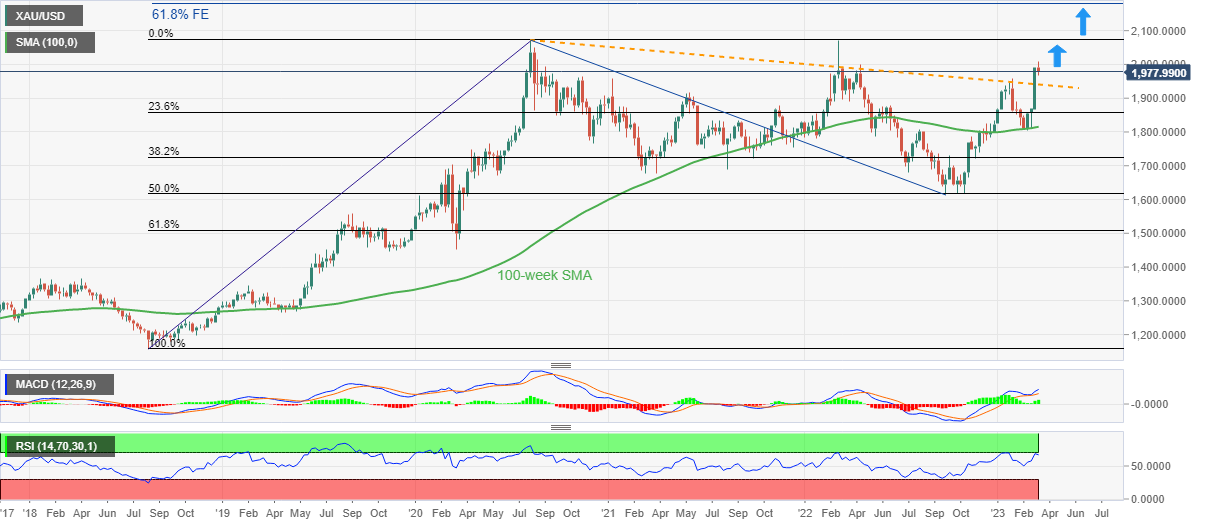
Trend: Further upside expected
- EUR/GBP is expected to deliver a fresh downside below 0.8730 ahead of the BoE policy.
- ECB Lagarde reiterated fears of wage pressures and cited that inflation will still be high for a longer period.
- UK’s annual headline CPI is expected to trim to 9.8% while the core CPI would remain steady.
The EUR/GBP pair is displaying topsy-turvy moves in a narrow range of 0.8730 in the Asian session. The cross is eyeing a downside below the aforementioned support as the street is anticipating more rates from the Bank of England (BoE) despite credible signs of banking turmoil.
Financial instability in global markets after the collapse of three mid-size United States commercial banks and the 164-year-old Credit Suisse has spooked the sentiment of market participants. Two schools of thought have confused investors as one believes that central banks could adopt a steady approach on interest rates as banking shakedown could have its dramatic consequences ahead. While others believe that inflation is extremely stubborn, especially in the United Kingdom region, which is highly required to be tamed as early as possible.
Therefore, the street is anticipating an announcement of a smaller interest rate hike of 25 basis points (bps) by BoE Governor Andrew Bailey to continue to weigh pressure on UK inflation. This would push interest rates to 4.25%.
Before the BoE’s interest rate decision, UK’s inflation data will be keenly watched. As per the estimates, the annual headline CPI is expected to trim to 9.8% from the former release of 10.1%. While the core CPI that excludes oil and food prices would remain steady at 5.8%.
On the Eurozone front, the commentary from European Central Bank (ECB) President Christine Lagarde on inflation projections and wages geared up expectations for the continuation of bumper rate hikes by the ECB. ECB Lagarde cited that inflation is projected to remain too high for too long, as reported by Reuters. She further added that wage pressures have strengthened on the back of robust labor markets and added that employees are aiming to recoup some of the purchasing power.
- US Dollar bulls eye up a 38.2% Fibonacci that is near 104.20 and prior support.
- 102.80 guards prospects of a downside continuation towards 101.00 February lows.
The US Dollar was pressured on Monday due to UBS' cut-price forced merger of its beleaguered rival Credit Suisse. The banks came together on an agreement and price tag of 3 billion Swiss francs ($3.23 billion) and assume up to $5.4 billion in losses in a takeover engineered by Swiss authorities.
The US Dollar index, DXY, which weighs the greenback vs. a basket of currencies was touching its lowest level since Feb. 15 at 103.27. However, there are still concerns over regional US banks. First Republic shares tumbled as much as 50% on Monday and were last down about 39%. Additionally, the Bank of Canada, Bank of England, Bank of Japan, European Central Bank, Federal Reserve, and the Swiss National Bank are taking coordinated action to enhance the provision of liquidity via standing US Dollar liquidity swap line arrangements.
Meanwhile, the Federal Reserve's latest decision on interest rate hikes is due on Wednesday and adds an additional layer of uncertainty for investors. Rates currently stand at 4.5% to 4.75%.
Analysts at TD Securities explained that they ´´expect a 25bp rate hike at next week's FOMC meeting, taking the Fed Funds rate to 4.75%-5.00%. Post-meeting communication is likely to emphasize that the Fed is not done yet in terms of tightening (also reflected in a slightly more hawkish dot plot), with officials also flagging the more uncertain economic environment, resulting in an even larger emphasis on data dependence.´´
US Dollar technical analysis
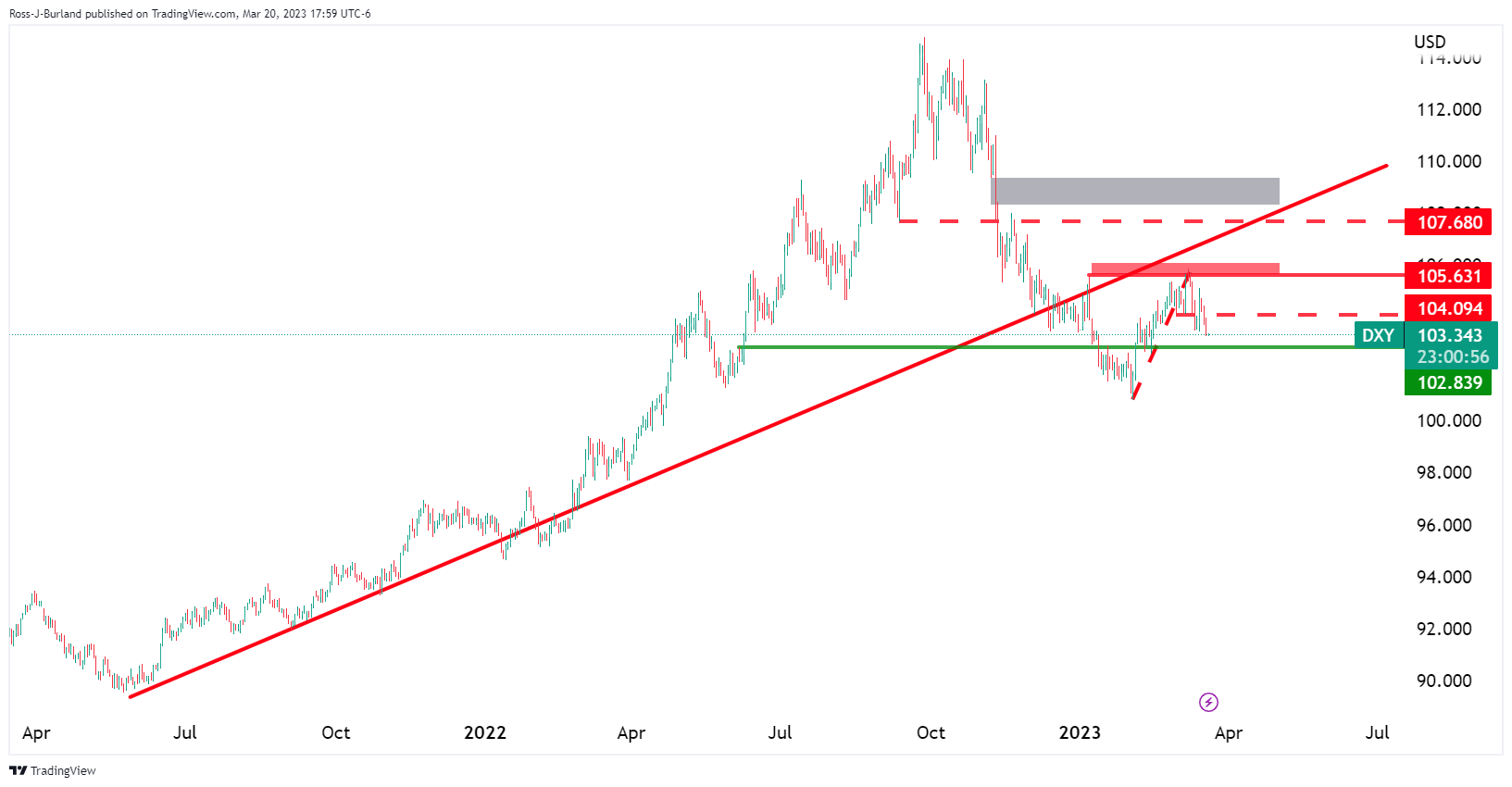

From the charts above, a bearish bias can be drawn considering that the market is on the backside of the prior bullish trend. A correction could be underway here and the 38.2% Fibonacci is up near 104.20 and prior support could be a target. 102.80 guards prospects of a downside continuation towards 101.00 February lows.
| Pare | Closed | Change, % |
|---|---|---|
| AUDUSD | 0.67147 | -0.04 |
| EURJPY | 140.75 | -0.05 |
| EURUSD | 1.07189 | 0.29 |
| GBPJPY | 161.174 | 0.26 |
| GBPUSD | 1.22759 | 0.6 |
| NZDUSD | 0.62484 | -0.48 |
| USDCAD | 1.36662 | -0.33 |
| USDCHF | 0.92872 | 0.37 |
| USDJPY | 131.296 | -0.35 |
© 2000-2025. All rights reserved.
This site is managed by Teletrade D.J. LLC 2351 LLC 2022 (Euro House, Richmond Hill Road, Kingstown, VC0100, St. Vincent and the Grenadines).
The information on this website is for informational purposes only and does not constitute any investment advice.
The company does not serve or provide services to customers who are residents of the US, Canada, Iran, The Democratic People's Republic of Korea, Yemen and FATF blacklisted countries.
Making transactions on financial markets with marginal financial instruments opens up wide possibilities and allows investors who are willing to take risks to earn high profits, carrying a potentially high risk of losses at the same time. Therefore you should responsibly approach the issue of choosing the appropriate investment strategy, taking the available resources into account, before starting trading.
Use of the information: full or partial use of materials from this website must always be referenced to TeleTrade as the source of information. Use of the materials on the Internet must be accompanied by a hyperlink to teletrade.org. Automatic import of materials and information from this website is prohibited.
Please contact our PR department if you have any questions or need assistance at pr@teletrade.global.















